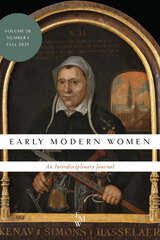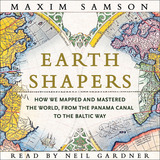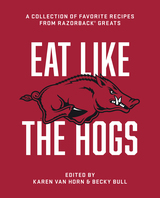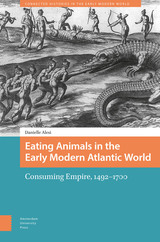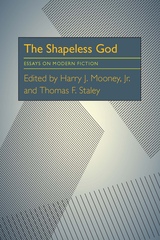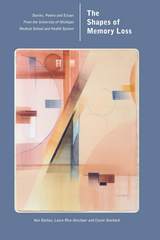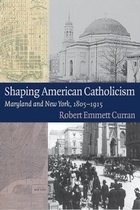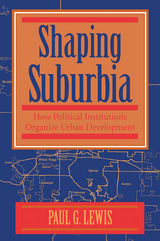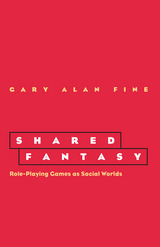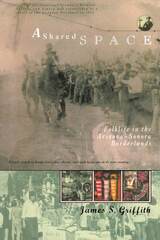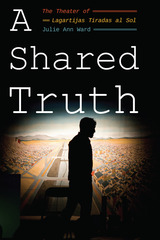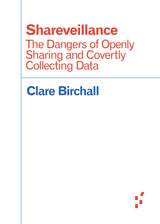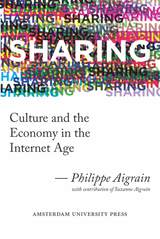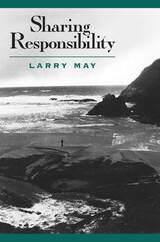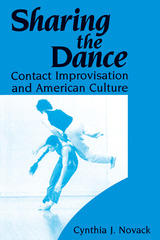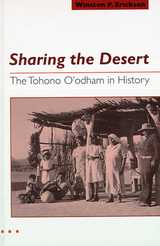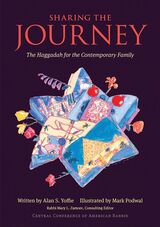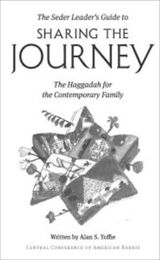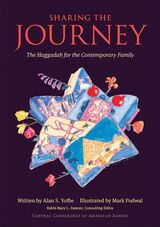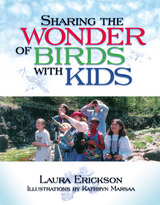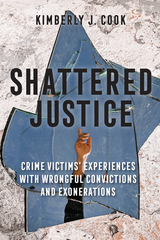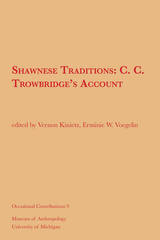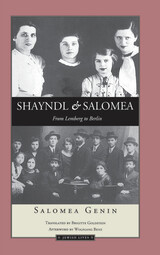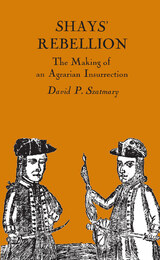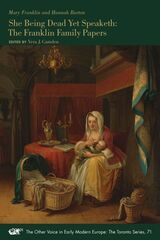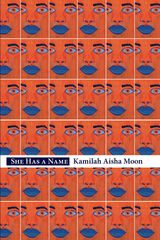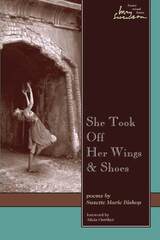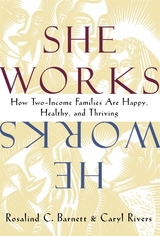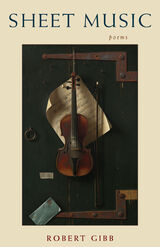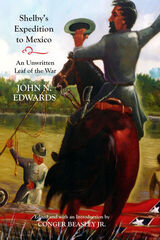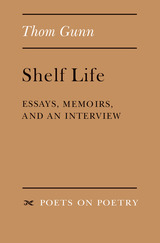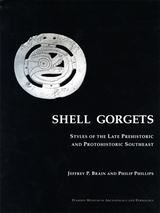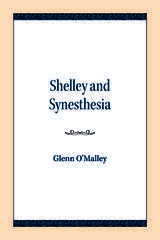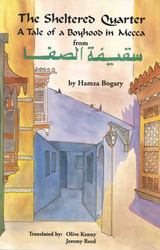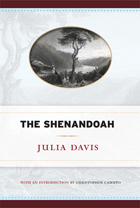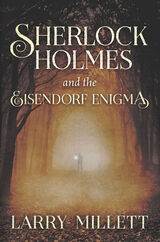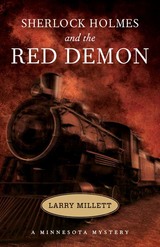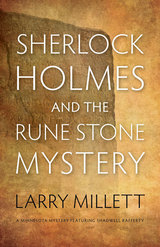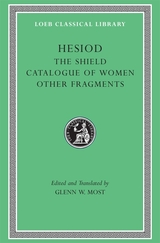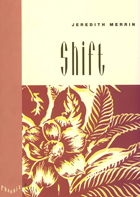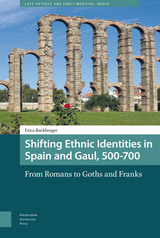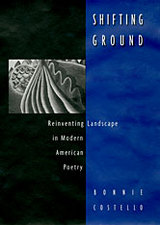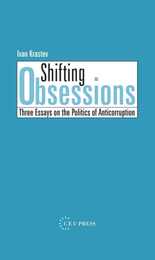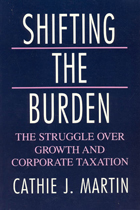The Shapeless God: Essays on Modern Fiction
Harry John Mooney
University of Pittsburgh Press, 1968
Nine noted literary critics examine the spiritual and religious elements in the fiction of such diverse writers as James Baldwin, J. F. Powers, Graham Greene, Par Lagerkvist, and Flannery O’Connor.
Contributors: Robert Boyle, S.J.; Robert McAfee Brown; A. A. Devitis; Herbert Howarth; Maralee Frampton; Nathan A. Scott, Jr.; Albert Sonnenfeld; Winston Weathers; and the editors
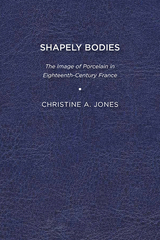 Shapely Bodies: The Image of Porcelain in Eighteenth-Century France
Christine A. Jones
University of Delaware Press, 2013 Shapely Bodies: The Image of Porcelain in Eighteenth-Century France constructs the first cultural history of porcelain making in France. It takes its title from two types of “bodies” treated in this study: the craft of porcelain making shaped clods of earth into a clay body to produce high-end commodities and the French elite shaped human bodies into social subjects with the help of makeup, stylish patterns, and accessories. These practices crossed paths in the work of artisans, whose luxury objects reflected and also influenced the curves of fashion in the eighteenth century. French artisans began trials to reproduce fine Chinese porcelain in the 1660s. The challenge proved impossible until they found an essential ingredient, kaolin, in French soil in the 1760s. Shapely Bodies differs from other studies of French porcelain in that it does not begin in the 1760s at the Sèvres manufactory when it became technically possible to produce fine porcelain in France, but instead ends there. Without the secret of Chinese porcelain, artisans in France turned to radical forms of experimentation. Over the first half of the eighteenth century, they invented artificial alternatives to Chinese porcelain, decorated them with French style, and, with equal determination, shaped an identity for their new trade that distanced it from traditional guild-crafts and aligned it with scientific invention. The back story of porcelain making before kaolin provides a fascinating glimpse into the world of artisanal innovation and cultural mythmaking. To write artificial porcelain into a history of “real” porcelain dominated by China, Japan, and Meissen in Saxony, French porcelainiers learned to describe their new commodity in language that tapped into national pride and the mythic power of French savoir faire. Artificial porcelain cut such a fashionable image that by the mid-eighteenth century, Louis XV appropriated it for the glory of the crown. When the monarchy ended, revolutionaries reclaimed French porcelain, the fruit of a century of artisanal labor, for the Republic. Tracking how the porcelain arts were depicted in documents and visual arts during one hundred years of experimentation, Shapely Bodies reveals the politics behind the making of French porcelain’s image. Published by University of Delaware Press. Distributed worldwide by Rutgers University Press.
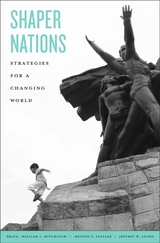 Shaper Nations: Strategies for a Changing World
William I. Hitchcock, Melvyn P. Leffler, and Jeffrey W. Legro
Harvard University Press, 2016 Shaper Nations provides illuminating perspectives on the national strategies of eight emerging and established countries that are shaping global politics at the beginning of the twenty-first century. The volume’s authors offer a unique viewpoint: they live and work primarily in the country about which they write, bringing an insider’s feel for national debates and politics.
The conventional wisdom on national strategy suggests that these states have clear central authority, coherently connect means to ends, and focus on their geopolitical environment. These essays suggest a different conclusion. In seven key countries—Brazil, China, Germany, India, Israel, Russia, and Turkey—strategy is dominated by nonstate threats, domestic politics, the distorting effect of history and national identity, economic development concerns, and the sheer difficulty, in the face of many powerful internal and external constraints, of pursuing an effective national strategy.
The shapers represent a new trend in the international arena with important consequences. Among them is a more uncertain world in which countries concentrate on their own development rather than on shared problems that might divert precious resources, and attend more to regional than to global order. In responding to these shaper states, the United States must understand the sources of their national strategies in determining its own role on the global stage.
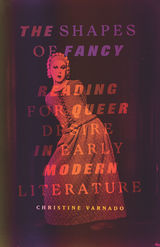 The Shapes of Fancy: Reading for Queer Desire in Early Modern Literature
Christine Varnado
University of Minnesota Press, 2020 Exploring forms of desire unaccounted for in previous histories of sexuality
What can the Renaissance tell us at our present moment about who and what is “queer,” as well as the political consequences of asking? In posing this question, The Shapes of Fancy offers a powerful new method of accounting for ineffable and diffuse forms of desire, mining early modern drama and prose literature to describe new patterns of affective resonance. Starting with the question of how and why readers seek traces of desire in texts from bygone times and places, The Shapes of Fancy demonstrates a practice of critical attunement to the psychic and historical circulations of affect across time within texts, from texts to readers, and among readers. Closely reading for uncharted desires as they recur in early modern drama, witchcraft pamphlets, and early Atlantic voyage narratives and demonstrating how each is structured by qualities of secrecy, impossibility, and excess, Christine Varnado follows four “shapes of fancy”: the desire to be used to others’ ends; indiscriminate, bottomless appetite; paranoid self-fulfilling suspicion; and melancholic longings for impossible transformations and affinities. These affective dynamics go awry in atypical and perverse ways. In other words, argues Varnado, these modes of feeling are recognizable on the page or stage as “queer” because of how, and not by whom, they are expressed. This new theorization of desire expands the notion of queerness in literature, decoupling the literary trace of queerness from the binary logics of same-sex versus opposite-sex and normative versus deviant that have governed early modern sexuality studies. Providing a set of methods for analyzing affect and desire in texts from any period, The Shapes of Fancy stages an impassioned defense of the inherently desirous nature of reading, making a case for readerly investment and identification as vital engines of meaning making and political insight.
The Shapes of Memory Loss: Stories, Poems and Essays from the University of Michigan Medical School and Health System
Nan Barbas
Michigan Publishing, 2013 “Shapes of Memory Loss” is a collection of poetry, fiction, and narrative written by and about people with cognitive impairment or dementia. The authors, all affiliated with the University of Michigan Health System, come forward to share their personal experience as they “navigate this unknown territory”. These pieces offer the reader a view into the often isolated and not fully understood journey that those with memory loss and cognitive impairment are on. The book serves as an educational and support tool for anyone who has been touched by dementia, memory loss, and other related disorders. Healthcare professionals will gain information and insight about these disorders presented from the perspective of patients and families affected by them.
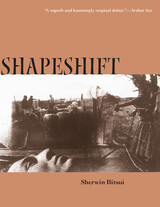 Shapeshift
Sherwin Bitsui
University of Arizona Press, 2003 "Fourteen ninety-something, / something happened / and no one can pick it out of the lineup . . . "
In words drawn from urban and Navajo perspectives, Sherwin Bitsui articulates the challenge a Native American person faces in reconciling his or her inherited history of lore and spirit with the coldness of postmodern civilization.
Shapeshift is a collection of startling new poetry that explores the tensions between the worlds of nature and man. Through brief, imagistic poems interspersed with evocative longer narratives, it offers powerful perceptions of American culture and politics and their lack of spiritual grounding. Linking story, history, and voice, Shapeshift is laced with interweaving images—the gravitational pull of a fishbowl, the scent of burning hair, the trickle of motor oil from a harpooned log—that speak to the rich diversity of contemporary Diné writing.
"Tonight, I draw a raven's wing inside a circle
measured a half second
before it expands into a hand.
I wrap its worn grip over our feet
As we thrash against pine needles inside the earthen pot."
With complexities of tone that shift between disconnectedness and wholeness, irony and sincerity, Bitsui demonstrates a balance of excitement and intellect rarely found in a debut volume. As deft as it is daring, Shapeshift teases the mind and stirs the imagination.
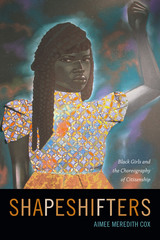 Shapeshifters: Black Girls and the Choreography of Citizenship
Aimee Meredith Cox
Duke University Press, 2015 In Shapeshifters Aimee Meredith Cox explores how young Black women in a Detroit homeless shelter contest stereotypes, critique their status as partial citizens, and negotiate poverty, racism, and gender violence to create and imagine lives for themselves. Based on eight years of fieldwork at the Fresh Start shelter, Cox shows how the shelter's residents—who range in age from fifteen to twenty-two—employ strategic methods she characterizes as choreography to disrupt the social hierarchies and prescriptive narratives that work to marginalize them. Among these are dance and poetry, which residents learn in shelter workshops. These outlets for performance and self-expression, Cox shows, are key to the residents exercising their agency, while their creation of alternative family structures demands a rethinking of notions of care, protection, and love. Cox also uses these young women's experiences to tell larger stories: of Detroit's history, the Great Migration, deindustrialization, the politics of respectability, and the construction of Black girls and women as social problems. With Shapeshifters Cox gives a voice to young Black women who find creative and non-normative solutions to the problems that come with being young, Black, and female in America.
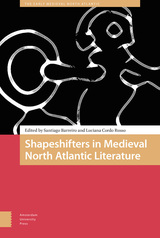 Shapeshifters in Medieval North Atlantic Literature
Santiago Francisco Barreiro
Amsterdam University Press, 2019 Representations of shapeshifters are prominent in medieval culture and they are particularly abundant in the vernacular literatures of the societies around the North Sea. Some of the figures in these stories remain well known in later folklore and often even in modern media, such as werewolves, dragons, berserkir and bird-maidens. Incorporating studies about Old English, Norse, Latin, Irish, and Welsh literature, this collection of essays marks an important new contribution to the study of medieval shapeshifters. Each essay highlights how shapeshifting cannot be studied in isolation, but intersects with many other topics, such as the supernatural, monstrosity, animality, gender and identity. Contributors to Shapeshifters in Medieval North Atlantic Literature come from different intellectual traditions, embracing a multidisciplinary approach combining influences from literary criticism, history, philology, and anthropology.
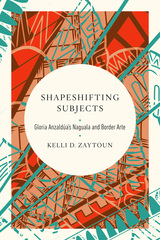 Shapeshifting Subjects: Gloria Anzaldua's Naguala and Border Arte
Kelli D. Zaytoun
University of Illinois Press, 2022 Kelli D. Zaytoun draws on Gloria Anzaldúa's thought to present a radically inclusive and expansive approach to selfhood, creativity, scholarship, healing, coalition-building, and activism. Zaytoun focuses on Anzaldúa's naguala/ shapeshifter, a concept of nagualismo. This groundbreaking theory of subjectivity details a dynamic relationship between “inner work” and "public acts" that strengthens individuals' roles in social and transformative justice work. Zaytoun's detailed emphasis on la naguala, and Nahua metaphysics specifically, brings much needed attention to Anzaldúa's long-overlooked contribution to the study of subjectivity. The result is a women and queer of color, feminist-focused work aimed at scholars in many disciplines and intended to overcome barriers separating the academy from everyday life and community. An original and moving analysis, Shapeshifting Subjects draws on unpublished archival material to apply Anzaldúa's ideas to new areas of thought and action.
Shaping American Catholicism: Maryland and New York, 1805-1915
Robert Emmett Curran
Catholic University of America Press, 2012 Distinguished historian Robert Emmett Curran presents an informed and balanced study of the American Catholic Church's experience in its two most important regions in the nineteenth and twentieth centuries
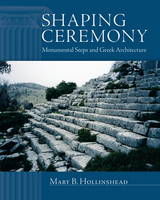 Shaping Ceremony: Monumental Steps and Greek Architecture
Mary B. Hollinshead
University of Wisconsin Press, 2014 Offering a fresh approach to ancient Greek architecture, Shaping Ceremony focuses on the overlooked subject of monumental steps. Written in a clear and readable style, the book presents three complementary ways of studying steps: examining how the human body works on steps; theoretical perspectives on the relationship between architecture and human behavior; and the socio-political effects of steps' presence. Although broad steps are usually associated with emperors and political dominance, Mary B. Hollinshead argues that earlier, in Greek sanctuaries, they expressed and reinforced communal authority. From this alternate perspective, she expands the traditional intellectual framework for studying Greek architecture.
The heart of the study is a close reading of thirty-eight sites with monumental steps from the sixth through second centuries B.C. Organized by century, the book tracks the development of built pathways and grandstands for crowds of worshippers as evidence of the Greeks' increasing awareness of the power of architecture to shape behavior and concentrate social energy. With photographs and illustrations of plans, Shaping Ceremony offers a clear account of how Greeks' adaptation of terrain for human use promoted social cohesion and integrated architectural compositions.
Shaping Film Festivals In a Changing World: Practice and Methods
Dorota Ostrowska
Amsterdam University Press, 2025 This volume is a collective attempt on the part of a community of academics, film festival curators, and archivists to come to terms with practical and intellectual challenges of the pandemic and post-pandemic realities affecting cultures of film festivals. The collection draws contours of critical inquiry orienting current film festival research and practice to explore new directions in archiving and decolonizing practices and big data analysis in the post-Covid-19 context and beyond. The four-part study gathers the voices of academics and practitioners who engage in a dialogue to articulate critical areas for both study and practice of film festivals, and identifies conceptual tools to address them: “Archival Turn,” “Decolonizing Film Festival Studies,” “Post-Covid-19 and Film Festival Studies” and “Data Visualization and Film Festival Research and Practice.”
 Shaping Global Cultures through Screenwriting: Women Who Write Our Worlds
Edited by Rose Ferrell and Rosanne Welch
Intellect Books, 2025 The voices of women changing the world one script at a time speak to how screenwriting is more than a craft—it’s activism, education, and revolution.
Shaping Global Culture through Screenwriting is a powerful testament to the undeniable impact of an international collection of female screenwriters. Spanning film, television, virtual reality, games, and digital media, these case studies showcase instances when women filmmakers used screenwriting to challenge injustice and give voice to communities around the world.
Divided into sections that seek to overcome global disparities in wealth and power, the book views screenwriting as activism, shifting attitudes, and altering lived experiences. Whether about gender and race or war and colonization, each chapter exposes the deep connections between storytelling and social change. More than just a study of the craft, this book is a celebration of the women writers who use their artistic lens to educate and empower others. Geared toward readers interested in screenwriting, media studies, sociology, women’s studies, and a wide range of humanities subjects, including history and population studies, Shaping Global Culture through Screenwriting brings long-overdue attention to the vital role women take in shaping the global cultural landscape.
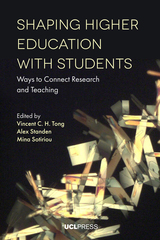 Shaping Higher Education with Students: Ways to Connect Research and Teaching
Edited by Vincent C. H. Tong, Alex Standen, and Mina Sotiriou
University College London, 2018 Forging close links between research and teaching is a key way universities can enhance learning in higher education. Given the current focus on student engagement, there is widespread and growing interest in how can university leaders and educators can more effectively engage with their students to connect research and teaching.
In Shaping Higher Education with Students, leading researchers and educators from a range of disciplines lay out practical steps for shaping research-based education. Written in collaboration with university students, the book encourages active partnerships between students and educators and offers an accessible guide to accomplishing this, including connecting students with real-world projects and workplaces, working with students as partners in higher education, encouraging students to pursue research activities that transcend disciplinary boundaries, and rethinking current assessment and teaching practices. Together, the contributions poses fundamental questions about the future of education in universities.
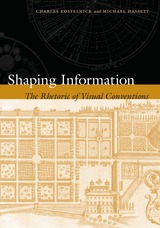 Shaping Information: The Rhetoric of Visual Conventions
Charles Kostelnick and Michael Hassett
Southern Illinois University Press, 2003 From charts, texts, and graphs to illustrations, icons, and screens, we live in an information age saturated with visual language. Yet the underlying principles that provide structure for visual language have long eluded scholars of rhetoric, design, and engineering. To function as a language that reliably conveys meaning, visual language must embody codes that normalize its practices among both the designers who employ it and the readers who interpret it. In this wide-ranging analysis, Charles Kostelnick and Michael Hassett demonstrate how visual language in professional communication—text design, data displays, illustrations—is shaped by conventional practices that are invented, codified, and modified by users in visual discourse communities. Drawing on rhetorical theory, design studies, and a broad array of historical and contemporary examples, Shaping Information: The Rhetoric of Visual Conventions explores the processes by which conventions evolve and proliferate and shows how conventions serve as the medium that designers use to shape, stabilize, and streamline visual information. Kostelnick and Hassett extend contemporary theories that define rhetoric as a social act, arguing that visual conventions also thrive within discourse communities and are fragile forms that vary widely in their longevity and scope. Shaping Information: The Rhetoric of Visual Conventions is a thorough guide for scholars, teachers and practitioners of rhetoric and business and technical communication and for professionals in engineering, science, design, and business.
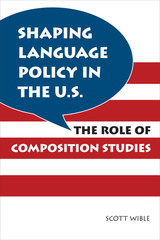 Shaping Language Policy in the U.S.: The Role of Composition Studies
Scott Wible
Southern Illinois University Press, 2013 In Shaping Language Policy in the U.S.: The Role of Composition Studies, author Scott Wible explores the significance and application of two of the Conference on College Composition and Communication’s key language policy statements: the 1974 Students’ Right to Their Own Language resolution and the 1988 National Language Policy. Wible draws from a wealth of previously unavailable archived material and professional literature to offer for the first time a comprehensive examination of these policies and their legacies that continue to shape the worlds of rhetoric, politics, and composition.
Wible demonstrates the continued relevance of the CCCC’s policies, particularly their role in influencing the recent, post-9/11 emergence of a national security language policy. He discusses in depth the role the CCCC’s language policy statements can play in shaping the U.S. government’s growing awareness of the importance of foreign language education, and he offers practical discussions of the policies’ pedagogical, professional, and political implications for rhetoric and composition scholars who engage contemporary debates about the politics of linguistic diversity and language arts education in the United States. Shaping Language Policy in the U.S. reveals the numerous ways in which the CCCC language policies have usefully informed educators’ professional practices and public service and investigates how these policies can continue to guide scholars and teachers in the future.
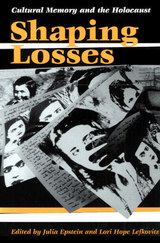 Shaping Losses: CULTURAL MEMORY AND THE HOLOCAUST
Edited by Julia Epstein and Lori Hope Lefkovitz
University of Illinois Press, 2001 Shaping Losses explores how traumatic loss affects identity and how those who are shaped by loss give shape, in turn, to the empty place where something--relationships, family, culture--was and is no longer. Taking the example of the decimation of European Jewry during the Nazi era, Shaping Losses confronts the problem of transforming trauma into cultural memory.
This eloquent volume examines how memoirs, films, photographs, art, and literature, as well as family conversations and personal remembrances, embody the impulse to preserve what is destroyed. The contributors -- all distinguished women scholars, most of them survivors or daughters of survivors--examine classic memorializations such as Claude Lanzmann's film Shoah and Roman Vishniac's photographs of prewar Jews as well as several less-well-known works. They also address ways in which children of survivors of the Holocaust--and of other catastrophic traumas--struggle with inherited or vicarious memory, striving to come to terms with losses that centrally define them although they experience them only indirectly.
Shaping Losses considers the limitations of Holocaust representations and testimonies that capture shards of the experience but are necessarily selective and reductive. Contributors discuss artistic efforts to "preserve the rawness" of memory, to resist redemptive closure in Holocaust narratives and public memorials, and to prevent the Holocaust from being sealed in "the cold storage of history." The authors probe the nature of memory and of trauma, studying the use of language within and outside a traumatic context such as Auschwitz and pinpointing the qualities that make traumatic memory ineffable, untransmittable, and perhaps unreliable. Within the "haunted terrain of traumatized memory" that all Holocaust testimonies inhabit, the impulse to give form to emptiness--to shape loss--emerges as a necessary betrayal, a vital effort to bridge the gap between history and memory.
Shaping Migration between Europe and Latin America: New Perspectives and Challenges
Edited by Ana Margheritis
University of London Press, 2018 With its focus on Latin America and Europe, two world regions historically linked by human mobility and cultural exchange, this insightful interdisciplinary examination of their changing international migration patterns demonstrates how they are now responding to significant demographic changes and new migration trends. The volume examines strategies pursued by state and non-state actors to address the political and policy implications of mobility, and asks to what extent is cross-regional migration effectively managed today, and how it could be improved. Its chapters provide an integrated and comparative view of the links between the two regions and highlight the formal and informal interstices through which migration journeys are negotiated and shaped.
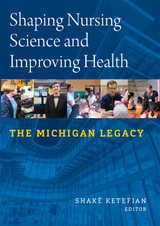 Shaping Nursing Science and Improving Health: The Michigan Legacy
Shaké Ketefian, editor
Michigan Publishing, 2016 Shaping Nursing Science and Improving Health: The Michigan Legacy chronicles the growth and development of nursing research and scholarship, and the outstanding contributions made to the discipline and the profession of nursing in the United States and beyond by the School of Nursing, University of Michigan.
The work covers selectively the development of nursing science over a period of some thirty years which was undertaken by nursing faculty and the School’s PhD Alumni. The account of the strategic development of a program of research across bio-behavioral phenomena, health promotion/risk reduction, women’s health and nursing and health care systems is instructive. Substantive contributions have been made across the selected areas; of note also is the impact of translational science on health outcomes of individuals and communities. The accounts of the purposeful development of health informatics in nursing and leadership as scholarship are also highly developed. The book is a valuable contribution to the literature on how nursing research at Michigan is helping transform the lives of patients, families and communities.
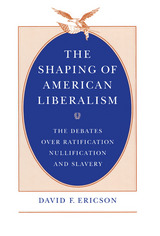 The Shaping of American Liberalism: The Debates over Ratification, Nullification, and Slavery
David F. Ericson
University of Chicago Press, 1993 In The Liberal Tradition in America (1955), Louis Hartz first put forth his thesis that the American political tradition derives essentially from consensual liberal principles. The many detractors to this theory include Bernard Bailyn, who argued that preliberal, republican values initially held sway in eighteenth-century American politics. In The Shaping of American Liberalism, David Ericson offers an innovative reinterpretation of both positions by redefining the terms of the argument.
Focusing on three critical debates in American history—the debate between Anti-Federalists and Federalists over the ratification of the Constitution; the debate between the national republicans and the states-rights republicans over the nullification of the tariff; and the Lincoln-Douglas debates over slavery and pluralist democracy—Ericson shows that republicanism, rather than being opposed to liberalism, is in fact an offshoot of it. His descriptions of republicanism and pluralism represent the poles of an evolving tradition of liberal ideas in America: the former championing the claims of the public sphere, general welfare, and civic virtue; the latter protecting the rights of the individual to liberty, property, and privacy.
Republicanism and pluralism are therefore more properly understood as two sets of competing ideas that evolved from common roots. Ericson concludes that although republican themes persist in American politics, the profound transformations brought about by the Civil War made the ascendancy of pluralism virtually inevitable.
This highly original discussion of the relation between liberalism and republicanism—the central concern of much of the recent scholarship in American political thought—will be important reading for those interested in American politics, history, and culture.
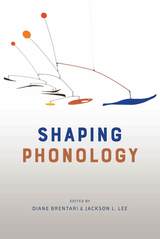 Shaping Phonology
Edited by Diane Brentari and Jackson L. Lee
University of Chicago Press, 2018 Within the past forty years, the field of phonology—a branch of linguistics that explores both the sound structures of spoken language and the analogous phonemes of sign language, as well as how these features of language are used to convey meaning—has undergone several important shifts in theory that are now part of standard practice. Drawing together contributors from a diverse array of subfields within the discipline, and honoring the pioneering work of linguist John Goldsmith, this book reflects on these shifting dynamics and their implications for future phonological work.
Divided into two parts, Shaping Phonology first explores the elaboration of abstract domains (or units of analysis) that fall under the purview of phonology. These chapters reveal the increasing multidimensionality of phonological representation through such analytical approaches as autosegmental phonology and feature geometry. The second part looks at how the advent of machine learning and computational technologies has allowed for the analysis of larger and larger phonological data sets, prompting a shift from using key examples to demonstrate that a particular generalization is universal to striving for statistical generalizations across large corpora of relevant data. Now fundamental components of the phonologist’s tool kit, these two shifts have inspired a rethinking of just what it means to do linguistics.
 Shaping Roman Landscape: Ecocritical Approaches to Architecture and Wall Painting in Early Imperial Italy
Mantha Zarmakoupi
J. Paul Getty Trust, The A groundbreaking ecocritical study that examines how ideas about the natural and built environment informed architectural and decorative trends of the Roman Late Republican and Early Imperial periods.
Landscape emerged as a significant theme in the Roman Late Republican and Early Imperial periods. Writers described landscape in texts and treatises, its qualities were praised and sought out in everyday life, and contemporary perceptions of the natural and built environment, as well as ideas about nature and art, were intertwined with architectural and decorative trends.
This illustrated volume examines how representations of real and depicted landscapes, and the merging of both in visual space, contributed to the creation of novel languages of art and architecture. Drawing on a diverse body of archaeological, art historical, and literary evidence, this study applies an ecocritical lens that moves beyond the limits of traditional iconography. Chapters consider, for example, how garden designs and paintings appropriated the cultures and ecosystems brought under Roman control and the ways miniature landscape paintings chronicled the transformation of the Italian shoreline with colonnaded villas, pointing to the changing relationship of humans with nature. Making a timely and original contribution to current discourses on ecology and art and architectural history, Shaping Roman Landscape reveals how Roman ideas of landscape, and the decorative strategies at imperial domus and villa complexes that gave these ideas shape, were richly embedded with meanings of nature, culture, and labor.
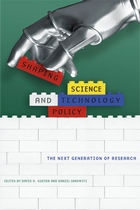 Shaping Science and Technology Policy: The Next Generation of Research
Edited by David H. Guston and Daniel Sarewitz
University of Wisconsin Press, 2006 With scientific progress occurring at a breathtaking pace, science and technology policy has never been more important than it is today. Yet there is a very real lack of public discourse about policy-making, and government involvement in science remains shrouded in both mystery and misunderstanding. Who is making choices about technology policy, and who stands to win or lose from these choices? What criteria are being used to make decisions and why? Does government involvement help or hinder scientific research?
Shaping Science and Technology Policy brings together an exciting and diverse group of emerging scholars, both practitioners and academic experts, to investigate current issues in science and technology policy. Essays explore such topics as globalization, the shifting boundary between public and private, informed consent in human participation in scientific research, intellectual property and university science, and the distribution of the costs and benefits of research.
Contributors: Charlotte Augst, Grant Black, Mark Brown, Kevin Elliott, Patrick Feng, Pamela M. Franklin, Carolyn Gideon, Tené N. Hamilton, Brian A. Jackson, Shobita Parthasarathy, Jason W. Patton, A. Abigail Payne, Bhaven Sampat, Christian Sandvig, Sheryl Winston Smith, Michael Whong-Barr
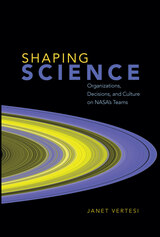 Shaping Science: Organizations, Decisions, and Culture on NASA’s Teams
Janet Vertesi
University of Chicago Press, 2020 Drawing on a decade of immersive ethnography with NASA’s robotic spacecraft teams to create a comparative account of two great space missions of the early 2000s, Janet Vertesi uncovers how the social organization of a scientific team affects their scientific practices and results.
In Shaping Science, Janet Vertesi draws on a decade of immersive ethnography with NASA’s robotic spacecraft teams to create a comparative account of two great space missions of the early 2000s. Although these missions featured robotic explorers on the frontiers of the solar system bravely investigating new worlds, their commands were issued from millions of miles away by a very human team. By examining the two teams’ formal structures, decision-making techniques, and informal work practices in the day-to-day process of mission planning, Vertesi shows just how deeply entangled a team’s local organizational context is with the knowledge they produce about other worlds.
Using extensive, embedded experiences on two NASA spacecraft teams, this is the first book to apply organizational studies of work to the laboratory environment in order to analyze the production of scientific knowledge itself. Engaging and deeply researched, Shaping Science demonstrates the significant influence that the social organization of a scientific team can have on the practices of that team and the results they yield.
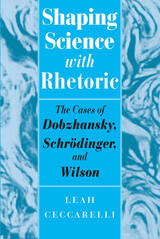 Shaping Science with Rhetoric: The Cases of Dobzhansky, Schrodinger, and Wilson
Leah Ceccarelli
University of Chicago Press, 2001 How do scientists persuade colleagues from diverse fields to cross the disciplinary divide, risking their careers in new interdisciplinary research programs? Why do some attempts to inspire such research win widespread acclaim and support, while others do not?
In Shaping Science with Rhetoric, Leah Ceccarelli addresses such questions through close readings of three scientific monographs in their historical contexts—Theodosius Dobzhansky's Genetics and the Origin of Species (1937), which inspired the "modern synthesis" of evolutionary biology; Erwin Schrödinger's What Is Life? (1944), which catalyzed the field of molecular biology; and Edward O. Wilson's Consilience (1998), a so far not entirely successful attempt to unite the social and biological sciences. She examines the rhetorical strategies used in each book and evaluates which worked best, based on the reviews and scientific papers that followed in their wake.
Ceccarelli's work will be important for anyone interested in how interdisciplinary fields are formed, from historians and rhetoricians of science to scientists themselves.
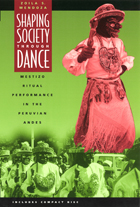 Shaping Society through Dance: Mestizo Ritual Performance in the Peruvian Andes
Zoila S. Mendoza
University of Chicago Press, 2000 During the patron saint fiesta in the Andean town of San Jerónimo, Peru, crowds gather at sunset in the town square, eagerly awaiting the entrance of the colorful dance troupes, or comparsas. With their masks, music, and surprising interpretations of contemporary events, the comparsas of the Cusco region are the focus of this multifaceted work. At the crossroads of folklore and ritual, mass media and local preferences, and regional and national identity, the comparsas—recorded here on VHS, DVD, and compact disc—have become a powerful way for the local people to make sense of their place in Peru and in the world. As Zoila Mendoza shows, they do more than reflect societal changes, they actively transform society.
In this fluid world, she argues, racial and ethnic identities are shaped more by notions of what is decent, elegant, and modern rather than by skin color or status. As the different troupes vie for the townspeople's recognition as the most "authentic" group, these notions are challenged and reworked. A fascinating look at a rich tradition, this innovative work is also a compelling example of the critical anthropology of performance.
Shaping Suburbia: How Political Institutions Organize Urban Development
Paul G. Lewis
University of Pittsburgh Press, 1996 The American metropolis has been transformed over the past quarter century. Cities have turned inside out, with rapidly growing suburbs evolving into edge cities and technoburbs. But not all suburbs are alike. In Shaping Suburbia, Paul Lewis argues that a fundamental political logic underlies the patterns of suburban growth and states that the key to understanding suburbia is to understand the local governments that control it - their number, functions, and power. Using innovative models and data analyses, Lewis shows that the relative political fragmentation of a metropolitan area plays a key part in shaping its suburbs.
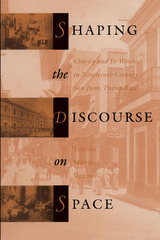 Shaping the Discourse on Space: Charity and Its Wards in Nineteenth-Century San Juan, Puerto Rico
By Teresita Martínez-Vergne
University of Texas Press, 1999 As an inchoate middle class emerged in Puerto Rico in the early nineteenth century, its members sought to control not only public space, but also the people, activities, and even attitudes that filled it. Their instruments were the San Juan town council and the Casa de Beneficencia, a state-run charitable establishment charged with responsibility for the poor. In this book, Teresita Martínez-Vergne explores how municipal officials and the Casa de Beneficencia shaped the discourse on public and private space and thereby marginalized the worthy poor and vagrants, "liberated" Africans, indigent and unruly women, and destitute children. Drawing on extensive and innovative archival research, she shows that the men who comprised the San Juan ayuntamiento and the board of charity regulated the public discourse on topics such as education, religious orthodoxy, hygiene, and family life, thereby establishing norms for "correct" social behavior and chastising the "deviant" lifestyles of the working poor. This research clarifies the ways in which San Juan's middle class defined itself in the midst of rapid social and economic change. It also offers new insights into notions of citizenship and the process of nation-building in the Caribbean.
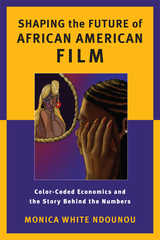 Shaping the Future of African American Film: Color-Coded Economics and the Story Behind the Numbers
Monica White Ndounou
Rutgers University Press, 2014 Received the Distinction Honor for the 2016 C. Calvin Smith Book Award from the Southern Conference on African American Studies, Inc.
In Hollywood, we hear, it’s all about the money. It’s a ready explanation for why so few black films get made—no crossover appeal, no promise of a big payoff. But what if the money itself is color-coded? What if the economics that governs film production is so skewed that no film by, about, or for people of color will ever look like a worthy investment unless it follows specific racial or gender patterns? This, Monica Ndounou shows us, is precisely the case. In a work as revealing about the culture of filmmaking as it is about the distorted economics of African American film, Ndounou clearly traces the insidious connections between history, content, and cash in black films.
How does history come into it? Hollywood’s reliance on past performance as a measure of potential success virtually guarantees that historically underrepresented, underfunded, and undersold African American films devalue the future prospects of black films. So the cycle continues as it has for nearly a century. Behind the scenes, the numbers are far from neutral. Analyzing the onscreen narratives and off-screen circumstances behind nearly two thousand films featuring African Americans in leading and supporting roles, including such recent productions as Bamboozled, Beloved, and Tyler Perry’s Diary of a Mad Black Woman, Ndounou exposes the cultural and racial constraints that limit not just the production but also the expression and creative freedom of black films. Her wide-ranging analysis reaches into questions of literature, language, speech and dialect, film images and narrative, acting, theater and film business practices, production history and financing, and organizational history.
By uncovering the ideology behind profit-driven industry practices that reshape narratives by, about, and for people of color, this provocative work brings to light existing limitations—and possibilities for reworking stories and business practices in theater, literature, and film.
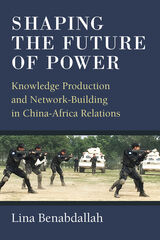 Shaping the Future of Power: Knowledge Production and Network-Building in China-Africa Relations
Lina Benabdallah
University of Michigan Press, 2020 China’s rise to power is one of the biggest questions in International Relations theory (IRT) and foreign policy circles. Although power has been a core concept of IRT for a long time, the faces and mechanisms of power as it relates to Chinese foreign policymaking has changed the contours of that debate. The rise of China and other powers across the global political arena sparks a new visibility for different kinds of encounters between states, particularly between China and other Global South states. These encounters are more visible to IR scholars because of the increasing influence that rising powers have in the international system. This book shows that foreign policy encounters between rising powers and Global South states do not necessarily exhibit the same logics, behaviors, or investment strategies of Euro-American hegemons. Instead, they have distinctive features that require new theoretical frameworks for analysis. Shaping the Future of Power probes the types of power mechanisms that build, diffuse, and project China’s power in Africa. One must take into account the processes of knowledge production, social capital formation, and skills transfers that Chinese foreign policy directs toward African states to fully understand China’s power-building mechanisms. The relational power framework requires these elements to capture both the material aspects and ideational people-centered aspects to power. By examining China’s investments in human resource development programs for Africa, the book reveals a vital, yet undertheorized, aspect of China’s foreign policy making.
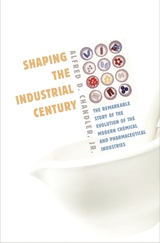 Shaping the Industrial Century: The Remarkable Story of the Evolution of the Modern Chemical and Pharmaceutical Industries
Alfred D. Chandler Jr.
Harvard University Press, 2009 The dean of business historians continues his masterful chronicle of the transforming revolutions of the twentieth century begun in Inventing the Electronic Century.
Alfred Chandler argues that only with consistent attention to research and development and an emphasis on long-term corporate strategies could firms remain successful over time. He details these processes for nearly every major chemical and pharmaceutical firm, demonstrating why some companies forged ahead while others failed.
By the end of World War II, the chemical and pharmaceutical industries were transformed by the commercializing of new learning, the petrochemical and the antibiotic revolutions. But by the 1970s, chemical science was no longer providing the new learning necessary to commercialize more products, although new directions flourished in the pharmaceutical industries. In the 1980s, major drug companies, including Eli Lilly, Merck, and Schering Plough, commercialized the first biotechnology products, and as the twenty-first century began, the infrastructure of this biotechnology revolution was comparable to that of the second industrial revolution just before World War I and the information revolution of the 1960s. Shaping the Industrial Century is a major contribution to our understanding of the most dynamic industries of the modern era.
Shaping the Moral Life: An Approach to Moral Theology
Klaus Demmer. Brian McNeil, Translator
Georgetown University Press, 2000 Although he is one of the most influential Catholic theologians in Europe, very few of Klaus Demmer's writings are available in English. This translation of his well-known work on moral theology introduces Demmer's thought to English-speaking audiences. In an original synthesis of scholastic and continental philosophy, Demmer brings the Catholic moral tradition into conversation with contemporary philosophical schools—transcendental, hermeneutical, and analytical—to fashion a moral theology in the spirit of the Second Vatican Council. He shows the richness of the neoscholastic tradition in shaping and being shaped by our contemporary self-understanding. A complete bibliography of Demmer's works will assist readers in seeking out more of his writings.
 Shaping the Motherhood of Indigenous Mexico
Vania Smith-Oka
Vanderbilt University Press, 2013 Mainstream Mexican views of indigenous women center on them as problematic mothers, and development programs have included the goal of helping these women become "good mothers." Economic incentives and conditional cash transfers are the vehicles for achieving this goal. With ethnographic immediacy, Shaping the Motherhood of Indigenous Mexico</> examines the dynamics among the various players--indigenous mothers, clinicians, and representatives of development programs. The women's voices lead the reader to understand the structures of dependency that paradoxically bind indigenous women within a program that calls for their empowerment. The cash transfer program is Oportunidades, which enrolls more than a fifth of Mexico's population. It expects mothers to become involved in their children's lives at three nodes--health, nutrition, and education. If women do not comply with the standards of modern motherhood, they are dropped from the program and lose the bi-monthly cash payments. Smith-Oka explores the everyday implementation of the program and its unintended consequences. The mothers are often berated by clinicians for having too many children (Smith-Oka provides background on the history of eugenics and population control in Mexico) and for other examples of their "backward" ways. An entire chapter focuses on the humor indigenous women use to cope with disrespectful comments. Ironically, this form of resistance allows the women to accept the situation that controls their behavior.
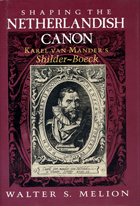 Shaping the Netherlandish Canon: Karel Van Mander's Schilder-Boeck
Walter S. Melion
University of Chicago Press, 1992 A treatise on Dutch art on par with Vasari's critical history
of Italian art, Karel van Mander's Schilder-Boeck (or
Book on Picturing) has long been recognized for its critical
and historical influence—and yet, until now, no
comprehensive account of the book's conception, aims, and
impact has been available. In this in-depth analysis of the
content and context of Van Mander's work, Walter S. Melion
reveals the Schilder-Boeck's central importance to an
understanding of northern Renaissance and Baroque art.
By interpreting the terminology employed in the
Schilder-Boeck, Melion establishes the text's
relationship to past and contemporary art theory. Van Mander
is seen here developing his critical categories and then
applying them to Ancient, Italian, and Netherlandish artists
in order to mark changes within a culture and to characterize
excellence for each region. Thus Melion demonstrates how Van
Mander revised both the structure and critical language of
Vasari's Lives to refute the Italian's claims for the
superiority of the Tuscan style, and to clarify northern
artistic traditions and the concerns of Netherlandish
artists. A much needed corrective to the view that Dutch art
of the period was lacking in theory, Melion's work offers a
compelling account of a sixteenth- and seventeenth-century
theoretical and critical perspective and shows how this
perspective suggests a rereading of northern art.
Walter S. Melion is assistant professor of art history
at The Johns Hopkins University.
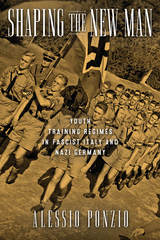 Shaping the New Man: Youth Training Regimes in Fascist Italy and Nazi Germany
Alessio Ponzio
University of Wisconsin Press, 2017 Despite their undeniable importance, the leaders of the Fascist and Nazi youth organizations have received little attention from historians. In Shaping the New Man, Alessio Ponzio uncovers the largely untold story of the training and education of these crucial protagonists of the Fascist and Nazi regimes, and he examines more broadly the structures, ideologies, rhetoric, and aspirations of youth organizations in Fascist Italy and Nazi Germany.
Ponzio shows how the Italian Fascists' pedagogical practices influenced the origin and evolution of the Hitler Youth. He dissects similarities and differences in the training processes of the youth leaders of the Opera Nazionale Balilla, Gioventù Italiana del Littorio, and Hitlerjugend. And, he explores the transnational institutional interactions and mutual cooperation that flourished between Mussolini's and Hitler's youth organizations in the 1930s and 1940s.
 Shaping The Political Arena: Critical Junctures, the Labor Movement, and Regime Dynamics in Latin America
Ruth Berins Collier
University of Notre Dame Press, 2002 “This book is a disciplined, paired comparison of the eight Latin American countries with the longest history of urban commercial and industrial development—Brazil and Chile, Mexico and Venezuela, Uruguay and Columbia, Argentina and Peru. The authors show how and why state party responses to the emergence of an organized working class have been crucial in shaping political coalitions, party systems, patterns of stability or conflict and the broad contours of regimes and their changes. The argument is complex yet clear, the analysis systematic yet nuanced. The focus is on autonomous political variables within particular socioeconomic contexts, the treatment of which is lengthy but rewarding.... Overall, a path-breaking volume.” —Foreign Affairs
“Excellent comparative-historical analysis of eight countries (Argentina, Brazil, Chile, Colombia, Mexico, Peru, Uruguay, and Venezuela) focuses on emergence of different forms of control and mobilization of the labor movement. By concentrating on alternative strategies of the State in shaping the labor movement, authors are able to explain different trajectories of national political change in counties with longest history of urban, commercial, and industrial development. Important and valuable work includes glossary of terms and extensive index (general and by country).”—Handbook of Latin American Studies
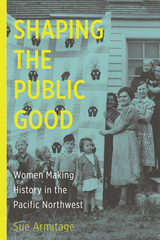 Shaping the Public Good: Women Making History in the Pacific Northwest
Sue Armitage
Oregon State University Press, 2015 Carved into a rock overlooking the Columbia River stands the arresting image of Tsagaglalal, or “She Who Watches,” an ancient female chief. As the Wishram people recount, when men replaced women in positions of power, Tsagaglalal was turned to stone by Coyote so that she could forever guide her community and guard its development.
Using the story of She Who Watches as her guide, Armitage shows that even though women were barred from positions of public authority until recently, they have always worked quietly and informally to assure the stability and security of their families and communities. Women’s community-building and cooperative skills have been decisive in developing the societies of the Pacific Northwest—Washington, Oregon, Idaho, western Montana, and British Columbia. Like She Who Watches, women have never been mere observers, but watchful guardians and active shapers of the public good.
Drawing on her three decades of research and teaching and based on hundreds of secondary sources, Armitage’s account explores the varied ways in which, beginning in the earliest times and continuing to the present, women of all races and ethnicities have made the history of our region. An accessible introduction for general readers and scholars alike, Shaping the Public Good restores a missing piece of Pacific Northwest history by demonstrating the part that women—“the famous, the forgotten, and all the women in between”—have always played in establishing their families and building communities.
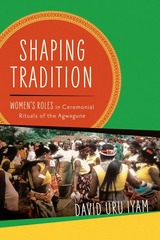 Shaping Tradition: Women's Roles in Ceremonial Rituals of the Agwagune
David Uru Iyam
University of Wisconsin Press, 2021 Agwagune women in southeastern Nigeria contribute to the cultural construction of their societies in deep and systematic ways. This reality is often concealed, misrepresented, or unexamined in studies that do not consciously set out to address female agency and authority. Most recently women have reshaped traditional male-centered village practices behind the scenes, such as when they updated the premarital ritual of fattening prospective brides, and when they ended female circumcision. Women use their status to direct and influence male leadership on matters of war, finance, education, and political stability.
Using this community as a case study, David Uru Iyam asserts that these women are not stereotypically submissive, oppressed, or passive. Agwagune women participate in male ceremonies by pretending to be unaware of them, concealing their authority under a veneer of secrecy. Instead of focusing on obvious male political power, Iyam highlights the overlooked domestic and public contributions of women that uphold—and change—entire social systems.
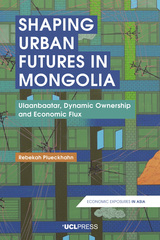 Shaping Urban Futures in Mongolia: Ulaanbaatar, Dynamic Ownership and Economic Flux
Rebekah Plueckhahn
University College London, 2019 Shaping Urban Futures in Mongolia discusses the lived experience of urban development, redevelopment, and change in Ulaanbaatar. The fast rates of urbanization occurring in many parts of the world are often buoyed by increased investment of capital and ensuing construction, giving rise to other less visible effects among those living in cities—including diverse economic practices, politics, and ethics. Construction becomes a solution to the provision of housing but also simultaneously becomes a problem when economic processes fail to work as they should, or people are dispossessed of land to make way for further urban change.
Rebekah Plueckhahn explores the inherent contradiction between solution and problem-making as experienced by residents of Ulaanbaatar during a tumultuous period in Mongolia’s economic history. She examines the ways residents attempt to own forms of real estate and, in turn, physically shape the city and its politics and urban economic forms from within. This book interlinks the intimate space of the home with ideologies of the national economy, urban development and disrepair and the types of politics and ethics that arise as a result.
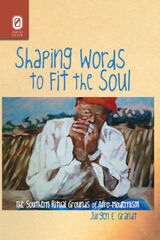 Shaping Words to Fit the Soul: The Southern Ritual Grounds of Afro-Modernism
Jürgen E. Grandt
Ohio State University Press, 2009 Taking up where he left off with Kinds of Blue (The Ohio State University Press, 2004), Jürgen E. Grandt seeks to explore in depth some of the implications of the modernist jazz aesthetic resonating in the African American literary tradition. Grandt’s new book, Shaping Words to Fit the Soul:The Southern Ritual Grounds of Afro-Modernism, probes the ways in which modernism’s key themes of fragmentation, alienation, and epistemology complicate the mapping of the American South as an “authenticating” locus of African American narrative. Rather than being a site of authentication, the South constitutes a symbolic territory that actually resists the very narrative strategies deployed to capture it. The figurative ritual grounds traversed in texts by Frederick Douglass, Jean Toomer, Richard Wright, and Tayari Jones reveal Afro-modernism as modernism with a historical conscience. Since literary Afro-modernism recurrently points to music as a symbolic territory of liberatory potential, this study also visits a variety of soundscapes, from the sorrow songs of the slaves to the hip-hop of the Dirty South, and from the blues of W. C. Handy to the southern rock of the Allman Brothers Band. Afro-modernism as modernism with a historical conscience thus suggests a reconfiguration of southern ritual grounds as situated in time and mind rather than time and place, and the ramifications of this process extend far above and beyond the Mason-Dixon Line.
 Shards of Love: Exile and the Origins of the Lyric
María Rosa Menocal
Duke University Press, 1994 With the Spanish conquest of Islamic Granada and the expulsion of the Jews from Spain, the year 1492 marks the exile from Europe of crucial strands of medieval culture. It also becomes a symbolic marker for the expulsion of a diversity in language and grammar that was disturbing to the Renaissance sensibility of purity and stability. In rewriting Columbus's narrative of his voyage of that year, Renaissance historians rewrote history, as was often their practice, to purge it of an offending vulgarity. The cultural fragments left behind following this exile form the core of Shards of Love, as María Rosa Menocal confronts the difficulty of writing their history.
It is in exile that Menocal locates the founding conditions for philology--as a discipline that loves origins--and for the genre of love songs that philology reveres. She crosses the boundaries, both temporal and geographical, of 1492 to recover the "original" medieval culture, with its Mediterranean mix of European, Arabic, and Hebrew poetics. The result is a form of literary history more lyrical than narrative and, Menocal persuasively demonstrates, more appropriate to the Middle Ages than to the revisionary legacy of the Renaissance. In discussions ranging from Eric Clapton's adaption of Nizami's Layla and Majnun, to the uncanny ties between Jim Morrison and Petrarch, Shards of Love deepens our sense of how the Middle Ages is tied to our own age as it expands the history and meaning of what we call Romance philology.
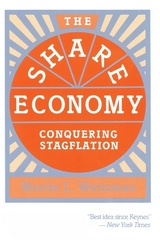 The Share Economy: Conquering Stagflation
Martin L. Weitzman
Harvard University Press, 1984 In the pages of this intriguing volume, a cure to stagflation seems to be at hand. Martin L. Weitzman, one of America’s leading economic theorists, has hit upon a central feature of our economic life as the cause of this chronic malady: the standard practice of paying workers a fixed wage, regardless of whether a company is doing well or poorly. Weitzman shows in a clear straightforward way that an alternative labor payment system, in which a significant number of firms share profits or revenues with their employees (like the Japanese bonus system), provides immunity against stagflation; an economy of such firms automatically soaks up unemployed labor and resists inflation.
Under the Weitzman system, firms always have an incentive to take on more workers because the additional worker is paid only a fraction or share of the revenue he brings into the firm. General Motors and Eastern Airlines have already taken steps to implement profit and revenue sharing. Here, for the first time, is a lucid explanation and justification of share systems. Eschewing theoretically unsound schemes such as supply-side tax cuts and industrial policy on the one hand and macroeconomic sledgehammer “cures” on the other, The Share Economy provides a powerful and hopeful account of what may become the most important economic innovation of our time.
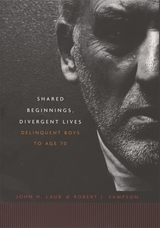 Shared Beginnings, Divergent Lives: Delinquent Boys to Age 70
John H. Laub and Robert J. Sampson
Harvard University Press, 2006 This book analyzes newly collected data on crime and social development up to age 70 for 500 men who were remanded to reform school in the 1940s. Born in Boston in the late 1920s and early 1930s, these men were the subjects of the classic study Unraveling Juvenile Delinquency by Sheldon and Eleanor Glueck (1950). Updating their lives at the close of the twentieth century, and connecting their adult experiences to childhood, this book is arguably the longest longitudinal study of age, crime, and the life course to date.
John Laub and Robert Sampson's long-term data, combined with in-depth interviews, defy the conventional wisdom that links individual traits such as poor verbal skills, limited self-control, and difficult temperament to long-term trajectories of offending. The authors reject the idea of categorizing offenders to reveal etiologies of offending--rather, they connect variability in behavior to social context. They find that men who desisted from crime were rooted in structural routines and had strong social ties to family and community.
By uniting life-history narratives with rigorous data analysis, the authors shed new light on long-term trajectories of crime and current policies of crime control.
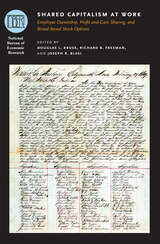 Shared Capitalism at Work: Employee Ownership, Profit and Gain Sharing, and Broad-Based Stock Options
Edited by Douglas L. Kruse, Richard B. Freeman, and Joseph R. Blasi
University of Chicago Press, 2010 The historical relationship between capital and labor has evolved in the past few decades. One particularly noteworthy development is the rise of shared capitalism, a system in which workers have become partial owners of their firms and thus, in effect, both employees and stockholders. Profit sharing arrangements and gain-sharing bonuses, which tie compensation directly to a firm’s performance, also reflect this new attitude toward labor.
Shared Capitalism at Work analyzes the effects of this trend on workers and firms. The contributors focus on four main areas: the fraction of firms that participate in shared capitalism programs in the United States and abroad, the factors that enable these firms to overcome classic free rider and risk problems, the effect of shared capitalism on firm performance, and the impact of shared capitalism on worker well-being. This volume provides essential studies for understanding the increasingly important role of shared capitalism in the modern workplace.
 SHARED DIFFERENCES: MULTICULTURAL MEDIA AND PRACTICAL PEDAGOGY
Edited by Diane Carson and Lester Friedman
University of Illinois Press, 1995 This timely volume addresses those who teach and study multicultural
topics. Rather than offering a Band-Aid approach to curricular offerings,
the contributors demonstrate inclusive, innovative ways to integrate multicultural
issues and media into existing courses.
In "Struggling for America's Soul: A Search for Some Common Ground
in the Multicultural Debate," Lester Friedman leads off the volume
with an analysis of the value and necessity of multicultural approaches
for today's students and for society at large. The essays that follow
provide a wealth of material for organizing courses, including week-by-week
syllabi detailing specific writing assignments, bibliographical information
on readings, and sources for films and videos. The contributors, who teach
at institutions ranging from community colleges through major research
universities, describe their experiences teaching students of various
ages, backgrounds, and interests.
Shared Differences will be of value to all who use media as a
tool in their teaching, whether in history, literature, or the social
sciences, as well as to those who teach film and video production.
Shared Fantasy: Role Playing Games as Social Worlds
Gary Alan Fine
University of Chicago Press, 1983 This classic study still provides one of the most acute descriptions available of an often misunderstood subculture: that of fantasy role playing games like Dungeons & Dragons. Gary Alan Fine immerses himself in several different gaming systems, offering insightful details on the nature of the games and the patterns of interaction among players—as well as their reasons for playing.
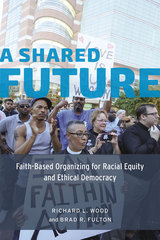 A Shared Future: Faith-Based Organizing for Racial Equity and Ethical Democracy
Richard L. Wood and Brad R. Fulton
University of Chicago Press, 2015 Faith-based community organizers have spent decades working for greater equality in American society, and more recently have become significant players in shaping health care, finance, and immigration reform at the highest levels of government. In A Shared Future, Richard L. Wood and Brad R. Fulton draw on a new national study of community organizing coalitions and in-depth interviews of key leaders in this field to show how faith-based organizing is creatively navigating the competing aspirations of America’s universalist and multiculturalist democratic ideals, even as it confronts three demons bedeviling American politics: economic inequality, federal policy paralysis, and racial inequity. With a broad view of the entire field and a distinct empirical focus on the PICO National Network, Wood and Fulton’s analysis illuminates the tensions, struggles, and deep rewards that come with pursuing racial equity within a social change organization and in society. Ultimately, A Shared Future offers a vision for how we might build a future that embodies the ethical democracy of the best American dreams. An interview of the authors on the subject of faith leaders organizing for justice (Peace Talks Radio, copyright Good Radio Shows, Inc.) can be heard at this link: https://beta.prx.org/stories/190030
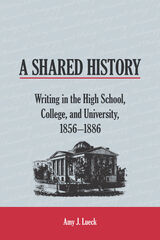 A Shared History: Writing in the High School, College, and University, 1856-1886
Amy J. Lueck
Southern Illinois University Press, 2020 In the nineteenth century, advanced educational opportunities were not clearly demarcated and defined. Author Amy J. Lueck demonstrates that public high schools, in addition to colleges and universities, were vital settings for advanced rhetoric and writing instruction. Lueck shows how the history of high schools in Louisville, Kentucky, connects with, contradicts, and complicates the accepted history of writing instruction and underscores the significance of high schools to rhetoric and composition history and the reform efforts in higher education today.
Lueck explores Civil War- and Reconstruction-era challenges to the University of Louisville and nearby local high schools, their curricular transformations, and their fate in regard to national education reform efforts. These institutions reflect many of the educational trends and developments of the day: college and university building, the emergence of English education as the dominant curriculum for higher learning, student-centered pedagogies and educational theories, the development and transformation of normal schools, the introduction of manual education and its mutation into vocational education, and the extension of advanced education to women, African American, and working-class students.
Lueck demonstrates a complex genealogy of interconnections among high schools, colleges, and universities that demands we rethink our categories and standards of assessment and our field’s history. A shift in our historical narrative would promote a move away from an emphasis on the preparation, transition, and movement of student writers from high school to college or university and instead allow a greater focus on the fostering of rich rhetorical practices and pedagogies at all educational levels. As the definition of college-level writing becomes increasingly contested once again, Lueck invites a reassessment of the discipline’s understanding of contemporary programs based in high schools like dual-credit and concurrent enrollment.
 Shared Land/Conflicting Identity: Trajectories of Israeli & Palestinian Symbol Use
Robert C. Rowland
Michigan State University Press, 2002 Shared Land/Conflicting Identity: Trajectories of Israeli and Palestinian Symbol Use argues that rhetoric, ideology, and myth have played key roles in influencing the development of the 100-year conflict between first the Zionist settlers and the current Israeli people and the Palestinian residents in what is now Israel. The Israeli-Palestinian conflict is usually treated as an issue of land and water. While these elements are the core of the conflict, they are heavily influenced by the symbols used by both peoples to describe, understand, and persuade each other. The authors argue that symbolic practices deeply influenced the Oslo Accords, and that the breakthrough in the peace process that led to Oslo could not have occurred without a breakthrough in communication styles.
Rowland and Frank develop four crucial ideas on social development: the roles of rhetoric, ideology, and myth; the influence of symbolic factors; specific symbolic factors that played a key role in peace negotiations; and the identification and value of criteria for evaluating symbolic practices in any society.
A Shared Life
Katherine Soniat
University of Iowa Press, 1993 There is a controlled, unpretentious constancy to Katherine Soniat's passionate, wise poetry that reminds one of the language of Elizabeth Bishop. Yet her voice is singular; there is an elegance of line, a centered quality that makes the poems more courtly than visceral. One tends to trust what is given in these beautifully rendered images and this gentle music. The poems are particularly crafted, partly meditative, yet the poet handles larger themes easily and with grace, without the shrillness that sometimes seems common in our time. Her gift for metaphoric language is evident. She has an even-tempered, deeply intelligent mode which carries from poem to poem.
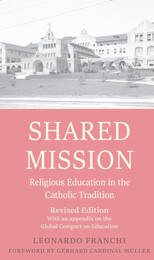 Shared Mission: Religious Education in the Catholic Tradition, Revised Edition
Leonardo Franchi
Catholic University of America Press, 2023 This book is a contribution to scholarship in the field of religious education. Its aim is simple: to offer a critical perspective on the nature of religious education in the light of contemporary developments in Catholic thinking in catechesis and wider thinking in education. The issues raised in the book will provide ample material for fruitful dialogue and constructive debate in the world of Catholic education.
Part One revolves around four historical contexts selected specifically to illuminate contemporary developments in the field. While these historical periods have porous boundaries, they offer a working structure in support of the core claims of the book.
Part Two explores the complex genealogy of the relationship between catechesis and Religious Education. Key thematic frames of reference within which the relevant Magisterial documents and associated academic literature are set out and explored chronologically thus allowing for some cross-referencing across the themes: unsurprisingly the range of the issues for debate resists a neat packaging within specific time-frames but does provide a helpful working structure. Part Three proposes that a Spirituality of Communion should underpin the Church’s work in catechesis, education and Religious Education.
Shared Mission seems to be a satisfactory articulation of the necessary dialogic relationship between both fields and offers a suitable space for both distinction and reciprocity. The revised edition contains an appendix on the Global Compact on Education.
Shared Mobility and Automated Vehicles: Responding to socio-technical changes and pandemics
Ata M. Khan
The Institution of Engineering and Technology, 2022 Shared vehicles are a key part of any future intelligent and clean transport system, as they can allow for the sharing and potentially more efficient use of transport resources and fuel. Shared mobility has been gaining attention in the private and public sectors as a possible strategy for taming auto ownership, vehicle miles/kilometers travelled, and emissions.
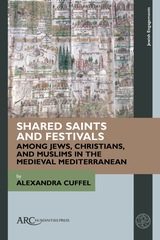 Shared Saints and Festivals among Jews, Christians, and Muslims in the Medieval Mediterranean
Alexandra Cuffel
Arc Humanities Press, 2024
This book explores shared religious practices among Jews, Christians, and Muslims, focusing primarily on the medieval Mediterranean. It examines the meanings members of each community ascribed to the presence of the religious other at "their" festivals or holy sites during pilgrimage. Communal boundaries were often redefined or dissolved during pilgrimage and religious festivals. Yet, paradoxically, shared practices served to enforce communal boundaries, since many of the religious elite devised polemical interpretations of these phenomena which highlighted the superiority of their own faith. Such interpretations became integral to each group’s theological understanding of self and other to such a degree that in some regions, religious minorities were required to participate in the festivals of the ruling community. In all formulations, “otherness” remained an essential component of both polemic and prayer.
 Shared Secrets: The Queer World of Newbery Medalist Charles J. Finger
Elizabeth Findley Shores
University of Arkansas Press, 2021 Winner, 2023 Booker Worthern Literary Prize
For nearly a century, British expatriate Charles Joseph Finger (1867–1941) was best known as an award-winning author of children’s literature. In Shared Secrets, Elizabeth Findley Shores relates Finger’s untold story, exploring the secrets that connected the author to an international community of twentieth-century queer literati. As a young man, Finger reveled in the easy homosociality of his London polytechnical school, where he launched a student literary society in the mold of the city’s private men’s clubs. Throughout his life, as he wandered from England to Patagonia to the United States, he tried to recreate similarly open spaces—such as Gayeta, his would-be art colony in Arkansas. But it was through his idiosyncratic magazine All’s Well that he constructed his most successful social network, writing articles filled with coded signals and winking asides for an inner circle of understanding readers. Capitalizing on the publishing opportunities of the day, Finger used every means available to express his twin loves—literature and men. He produced an enormous body of work, and his short, semiautobiographical fiction won some critical acclaim. Ultimately, the children’s book that won Finger a Newbery Medal ushered him into the public eye, ending his development as an author of serious queer literature. Shared Secrets is both the story of Finger’s remarkable, adventurous life and a rare look at a community of gay writers and artists who helped shaped twentieth-century American culture, even as they artfully concealed their own identities.
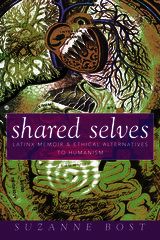 Shared Selves: Latinx Memoir and Ethical Alternatives to Humanism
Suzanne Bost
University of Illinois Press, 2019 Memoir typically places selfhood at the center. Interestingly, the genre's recent surge in popularity coincides with breakthroughs in scholarship focused on selfhood in a new way: as an always renewing, always emerging entity. Suzanne Bost draws on feminist and posthumanist ideas to explore how three contemporary memoirists decenter the self. Latinx writers John Rechy, Aurora Levins Morales, and Gloria E. Anzaldúa work in places where personal history intertwines with communities, environments, animals, plants, and spirits. This dedication to interconnectedness resonates with ideas in posthumanist theory while calling on indigenous worldviews. As Bost argues, our view of life itself expands if we look at how such frameworks interact with queer theory, disability studies, ecological thinking, and other fields. These webs of relation in turn mediate experience, agency, and lift itself.A transformative application of posthumanist ideas to Latinx, feminist, and literary studies, Shared Selves shows how memoir can encourage readers to think more broadly and deeply about what counts as human life.
Shared Space
James S. Griffith
Utah State University Press, 1995 Where it divides Arizona and Sonora, the international boundary between Mexico and the United States is both a political reality, literally expressed by a fence, and, to a considerable degree, a cultural illusion. Mexican, Anglo, and Native American cultures straddle the fence; people of various ethnic backgrounds move back and forth across the artificial divide, despite increasing obstacles to free movement. On either side is found a complex cultural mix of ethnic, religious, and occupational groups. In A Shared Space James Griffith examines many of the distinctive folk expressions of this varied cultural region.
 Shared Traditions: SOUTHERN HISTORY AND FOLK CULTURE
Charles Joyner
University of Illinois Press, 1999 Grounded in Charles Joyner's unique blend of rigorous scholarship and genuine curiosity, these thoughtful and incisive essays by the eminent southern historian and folklorist explore the South's extraordinary amalgam of cultural traditions.
By examining the mutual influence of history and folk culture, Shared Traditions reveals the essence of southern culture in the complex and dynamic interactions of descendants of Europeans, Africans, and Native Americans. The book covers a broad spectrum of southern folk groups, folklore expressions, and major themes of southern history, including antebellum society, slavery, the coming of the Civil War, economic modernization in the Appalachians and the Sea Islands, immigration, the civil rights movement, and the effects of cultural tourism.
Joyner addresses the convergence of African and European elements in the Old South and explores how specific environmental and demographic features shaped the acculturation process. He discusses divergent practices in worship services, funeral and burial services, and other religious ceremonies. He examines links between speech patterns and cultural patterns, the influence of Irish folk culture in the American South, and the southern Jewish experience. He also investigates points of intersection between history and legend and relations between the new social history and folklore.
Ranging from rites of power and resistance on the slave plantation to the creolization of language to the musical brew of blues, country, jazz, and rock, Shared Traditions reveals the distinctive culture born of a sharing by black and white southerners of their deep-rooted and diverse traditions.
A Shared Truth: The Theater of Lagartijas Tiradas al Sol
Julie Ann Ward
University of Pittsburgh Press, 2019 Lagartijas Tiradas al Sol (Lizards Lounging in the Sun) is a Mexican theater company that performs what is known as theater of the real. By taking reality as its subject, this genre claims a special relationship to reality, truth, and authenticity. In A Shared Truth, Julie Ann Ward traces the development of this contemporary and cutting-edge collective’s unique aesthetic. Based on performances, play texts, videos, and interviews, this in-depth look at a single theatrical troupe argues that the company’s work represents a larger trend in which Latin American theater positions itself as a source of and repository for truth in the face of unreliable official narratives. A Shared Truth critically examines the work of an influential company whose collaborative methods and engagement with the real challenge the bounds of theater.
 The Shared World: Poems
Vievee Francis
Northwestern University Press, 2021 The latest collection from award-winning poet Vievee Francis, The Shared World imagines the ideas and ideals and spaces of the Black woman. The book delves into inherited memories and restrictions between families, lovers, and strangers and the perception and inconvenient truth of Black woman as mother—with or without child. Francis challenges the ways in which Black women are often dismissed while expected to be nurturing. This raw assemblage of poetic narratives stares down the oppressors from within and writes a new language in the art of taking back the body and the memory. These poetic narratives are brutal in their lyrical blows but tender with the bruised history left behind. “You can’t stop this / song,” she writes. “More hands than yours have closed / around my throat.” Francis’s lyric gifts are on full display as she probes self-discovery, history, intimacy, and violence. Her voice encompasses humor and gravity, enigma and revelation. What emerges is a realm of intertwined experiences. “The secret to knowing the secret is to speak,” she concludes, “but we too often tell / the stories of no matter and avoid the one story that does matter. / In truth, we are bound by one story, so you’d think by now / we’d tell it, at least to each other.”
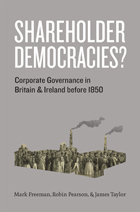 Shareholder Democracies?: Corporate Governance in Britain and Ireland before 1850
Mark Freeman, Robin Pearson, and James Taylor
University of Chicago Press, 2011 Understanding the challenges of corporate governance is central to our comprehension of the economic dynamics driving corporations today. Among the most important institutions in capitalism today, corporations and joint-stock companies had their origins in Europe during the seventeenth and eighteenth centuries. And as they became more prevalent, the issue of internal governance became more pressing. At stake—and very much contested—was the allocation of rights and obligations among shareholders, directors, and managers.
This comprehensive account of the development of corporate governance in Britain and Ireland during its earliest stages highlights the role of political factors in shaping the evolution of corporate governance as well as the important debates that arose about the division of authority and responsibility. Political and economic institutions confronted similar issues, including the need for transparency and accountability in decision making and the roles of electors and the elected, and this book emphasizes how political institutions—from election procedures to assemblies to annual reporting—therefore provided apt models upon which companies drew readily. Filling a gap in the literature on early corporate economy, this book provides insight into the origins of many ongoing modern debates.
Shareveillance: The Dangers of Openly Sharing and Covertly Collecting Data
Clare Birchall
University of Minnesota Press, 2017 Cracking open the politics of transparency and secrecy
In an era of open data and ubiquitous dataveillance, what does it mean to “share”? This book argues that we are all “shareveillant” subjects, called upon to be transparent and render data open at the same time as the security state invests in practices to keep data closed. Drawing on Jacques Rancière’s “distribution of the sensible,” Clare Birchall reimagines sharing in terms of a collective political relationality beyond the veillant expectations of the state.
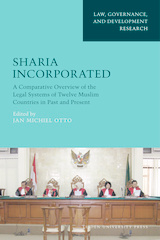 Sharia Incorporated: A Comparative Overview of the Legal Systems of Twelve Muslim Countries in Past and Present
Edited by Jan Michiel Otto
Leiden University Press, 2012 The aim of Sharia Incorporated is to provide unbiased and contextual information about a topic that has of late been hijacked by politics in the Muslim world as well as in the West. Sharia Incorporated, written by laudable international scholars, is an ambitious study of the incorporation of Islamic law traditions into national legal systems. The book also explores the sensitive topic of ‘Western’ human rights and other rule of law standards in a Muslim world. It provides an in-depth analysis of the role of sharia in the historical and legal formation of twelve representative Muslim states, with a unique comparison of key issues raised by the ‘Islamic awakening’ of recent decades. In the preface Jan Michiel Otto goes to the heart of the prevailing environment in which Western discourses tend to oversimplify the substance and effect of Islam and sharia. Watch a clarification on the book by Jan Michiel Otto here.
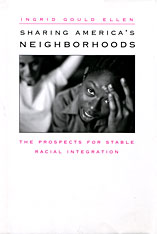 Sharing America’s Neighborhoods: The Prospects for Stable Racial Integration
Ingrid Gould Ellen
Harvard University Press, 2000 The first part of this book presents a fresh and encouraging report on the state of racial integration in America's neighborhoods. It shows that while the majority are indeed racially segregated, a substantial and growing number are integrated, and remain so for years.
Still, many integrated neighborhoods do unravel quickly, and the second part of the book explores the root causes. Instead of panic and "white flight" causing the rapid breakdown of racially integrated neighborhoods, the author argues, contemporary racial change is driven primarily by the decision of white households not to move into integrated neighborhoods when they are moving for reasons unrelated to race. Such "white avoidance" is largely based on the assumptions that integrated neighborhoods quickly become all black and that the quality of life in them declines as a result.
The author concludes that while this explanation may be less troubling than the more common focus on racial hatred and white flight, there is still a good case for modest government intervention to promote the stability of racially integrated neighborhoods. The final chapter offers some guidelines for policymakers to follow in crafting effective policies.
Sharing: Culture and the Economy in the Internet Age
Philippe Aigrain
Amsterdam University Press, 2012 An in-depth exploration of digital culture and its dissemination, Sharing offers a counterpoint to the dominant view that file sharing is piracy. Instead, Philippe Aigrain looks at the benefits of file sharing, which allows unknown writers and artists to be appreciated more easily. Concentrating not only on the cultural enrichment caused by widely shared digital media, Sharing also discusses new financing models that would allow works to be shared freely by individuals without aim at profit. Aigrain carefully balances the needs to support and reward creative activity with a suitable respect for the cultural common good and proposes a new interpretation of the digital landscape.
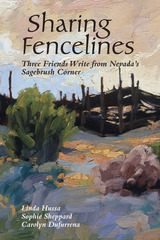 Sharing Fencelines
Linda Hussa
University of Utah Press, 2002 In the lightly-populated northwestern corner of Nevada, a former geologist and rural schoolteacher, a published poet and ranch owner, and an artist and environmentalist make for an intriguing—perhaps even unlikely—trio of friends. In this evocative collection of personal essays, each offers her voice as a testament to the joys and struggles of creating a home and connecting to the land and the people who live there. Stories of ranch hands and Ladies’ Clubs, raising chickens and raising children, pulling up roots and planting dreams tumble together in a mélange of lives lived well and thoughtfully. Sharing Fencelines is as much about art as it is about activism, as much about personal growth as it is about growing community. What these women offer us is the sweet taste of what is possible, and the blended harmony of their voices echoes across the mountains and washes and deserts, resonating in our own hearts, our own homes. Carolyn Dufurrena’s "The Flying Heart Museum" pays homage to a layered landscape of unique individuals—not the least of which are her students, searching for themselves in the Nevada wilderness: "You know how your spirit betrays you when you’re not thinking to protect yourself. Jose has been dreaming, doodling away, and his pencil has discovered this flying heart, as big as the Puritan meetinghouse....He has drawn the log cabin around the heart, and labeled it. At recess I ask him, gently, 'So, Jose, what’s in there, in your Flying Heart Museum?'" In "Shared Fencelines," Linda Hussa reveals the mystery of horses, the gift of water, and the serendipity of love: "My first hurt came from a horse when I tried to shinny up the feathered leg of our old gelding as I’d seen my brother and sister do. Twelve hundred pounds of him stepped on my bare foot. Mom carried her shrieking two-year-old to the house...she cut off the dangling nail saying Popeye didn’t mean to, he just didn’t notice my little foot. Then she cradled my face in her cool hands and said she hoped I would forgive him and we could be friends again." "Fire Hall" by Sophie Sheppard paints a picture of a families and communities forged against the backdrop of a rugged, rural life: "Here, when there is a funeral, the whole town comes. First to arrive are the older women, vestiges of the Lake City Ladies Club that was disbanded a few years ago because most of the younger women have jobs and no longer stay at home. At the potluck funeral dinner everyone will file in together: the women unfamiliar in dresses ordered from catalogs, the mens' hatless foreheads glowing pale in contrast to the tan of their freshly shaven jaws, the younger people that I won’t recognize."
Sharing Responsibility
Larry May
University of Chicago Press, 1992 Are individuals responsible for the consequences of actions taken by their community? What about their community's inaction or its attitudes? In this innovative book, Larry May departs from the traditional Western view that moral responsibility is limited to the consequences of overt individual action. Drawing on the insights of Arendt, Jaspers, and Sartre, he argues that even when individuals are not direct participants, they share responsibility for various harms perpetrated by their communities.
 Sharing Spaces: Technology, Mediation, and Human-Animal Relationships
Dolly Jorgensen
University of Pittsburgh Press, 2024 Human and animal lives intersect, whether through direct physical contact or by inhabiting the same space at a different time. Environmental humanities scholars have begun investigating these relationships through the emerging field of multispecies studies, building on decades of work in animal history, feminist studies, and Indigenous epistemologies. Contributors to this volume consider the entangled human-animal relationships of a complex multispecies world, where domesticated animals, wild animals, and people cross paths, creating hybrid naturecultures. Technology, they argue, structures how animals and humans share spaces. From clothing to cars to computers, technology acts as a mediator and connector of lives across time and space. It facilitates ways of looking at, measuring, moving, and killing, as well as controlling, containing, conserving, and cooperating with animals. Sharing Spaces challenges us to analyze how technology shapes human relationships with the nonhuman world, exploring nonhuman animals as kin, companions, food, transgressors, entertainment, and tools.
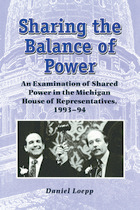 Sharing the Balance of Power: An Examination of Shared Power in the Michigan House of Representatives, 1993-1994
Daniel Loepp
University of Michigan Press, 1999 Like national politicians, state legislators all too often focus on partisanship instead of policy making, engaging themselves in rancorous debate that achieves little beyond gridlock. However, during one short period in Michigan's history, legislators stopped bickering and focused on forging compromise. Daniel Loepp's Sharing the Balance of Power chronicles the 87th Michigan Legislature (1993-1994), in which Republicans and Democrats successfully shared power. In 1992, Michigan voters elected exactly fifty-five Republicans and fifty-five Democrats to the state house. As a result, the two parties each elected a co-speaker, and a shared power agreement was forged. Given the history of intense partisanship in the state house, political pundits predicted that any plan for shared power would disintegrate within months. What resulted instead was one of the most productive legislatures in Michigan history. Author Daniel Loepp, chief of staff to Democratic Co-Speaker Curtis Hertel at the time, skillfully takes the reader "inside" the State Capitol, examining the key policy debates (including school finance reform), important personalities, and difficult negotiations. Loepp's balanced presentation is testimony to the two years of bi-partisan cooperation in which he took part. In an age of public cynicism about the legislative process, Daniel Loepp offers the reader a refreshing story about two co-speakers and their 108 colleagues who came together in the spirit of bi-partisan representation to successfully serve their constituents, the people of Michigan. Daniel Loepp is a partner in the firm of Karoub Associates, Michigan's oldest multi-client lobbying firm.
Sharing the Dance: Contact Improvisation and American Culture
Cynthia J. Novack
University of Wisconsin Press, 1990 In Sharing the Dance, Cynthia Novack considers the development of contact improvisation within its web of historical, social, and cultural contexts. This book examines the ways contact improvisers (and their surrounding communities) encode sexuality, spontaneity, and gender roles, as well as concepts of the self and society in their dancing.
While focusing on the changing practice of contact improvisation through two decades of social transformation, Novack’s work incorporates the history of rock dancing and disco, the modern and experimental dance movements of Merce Cunningham, Anna Halprin, and Judson Church, among others, and a variety of other physical activities, such as martial arts, aerobics, and wrestling.
Sharing the Desert: The Tohono O'odham in History
Winston P. Erickson
University of Arizona Press, 1994 This book marks the culmination of fifteen years of collaboration between the University of Utah's American West Center and the Tohono O'oodham Nation's Education Department to collect documents and create curricular materials for use in their tribal school system. . . . Erickson has done an admirable job compiling this narrative.—Pacific Historical Review
Sharing the Journey Gift Edition: The Haggadah for the Contemporary Family
Alan S. Yoffie
Central Conference of American Rabbis, 2012 The inclusive text, commentary, and magnificent original artwork in this new Haggadah will make all family members and friends feel welcome at your seder. Young and old, beginners and experienced seder participants, will experience the joy of celebrating Passover together with clear step-by-step explanations, inspiring readings on the themes of justice and freedom for all, and opportunities for discussion. Songs to sing along with will be available for download also. An accompanying comprehensive leader's guide will be available as well.
Sharing the Journey: The Haggadah for the Contemporary Family
Alan S. Yoffie
Central Conference of American Rabbis, 2012 The inclusive text, commentary, and magnificent original artwork in this new Haggadah will make all family members and friends feel welcome at your seder. Young and old, beginners and experienced seder participants, will experience the joy of celebrating Passover together with clear step-by-step explanations, inspiring readings on the themes of justice and freedom for all, and opportunities for discussion. Songs to sing along with will be available for download also. An accompanying comprehensive leader's guide will be available as well.
 Sharing the Land of Canaan: Human Rights and the Israeli-Palestinian Struggle
Mazin B. Qumsiyeh
Pluto Press, 2004 There is no more compelling and dramatic unfolding story, with more profound international ramifications, than the conflict in the Middle East.
Sharing the Land of Canaan is a critical examination of the core issues of the conflict that dares to put forward a radical but logical solution: that a shared state is the best way to achieve justice and peace for Israelis and Palestinians.
Mazin B. Qumsiyeh, a human rights activist based at Yale University, offers an overview of the issues at stake, and outlines his vision for a lasting peace based on upholding the principles of human rights for all. Tackling taboo subjects, myths and obstacles, he argues convincingly that apartheid in the form of a two-state solution is no longer a feasible way to achieve enduring peace.
At this critical time, when the 'road map' to peace looks more uncertain than ever, this book provides a refreshing counterpoint to the failed strategies of the past. It is a direct and accessible account of the history - and mythology - of the fabled 'Land of Canaan', which lays out hopeful ideas for the future of this truly multiethnic and multicultural region.
 Sharing the Love of Gardening: The History of The Westport Garden Club
Kristie C. Wolferman
University of Missouri Press, 2025 Sharing the Love of Gardening chronicles the seventy-five-year history of Kansas City’s Westport Garden Club (WGC). Founded as a women’s garden club in 1950, the group became a member of the prestigious Garden Club of America (GCA) in 1956. Since that time, it has evolved into an organization committed to civic improvement through educational programs and action in the areas of conservation, horticulture and the use of native plants.
With the post-World War II housing boom, the nascent WGC became involved in landscaping projects aimed at beautifying Kansas City. These efforts continued when the WGC led re-landscaping efforts after the Great Flood of 1951. Early in their club’s history, the women of the WGC learned that collaboration with other organizations allowed them to have a greater impact on the causes about which they cared. They soon began working with city governments and park departments on both sides of the Missouri-Kansas state line, including with the Linda Hall Library and Arboretum, the Nelson-Atkins Museum of Art, and the Loose Park Garden Center.
In addition to being a thorough history of The Westport Garden Club—and the considerable influence that a small number of dedicated, educated women have had on it—Sharing the Love of Gardening is a book of stunning photography, showcasing previously unpublished images from the clubs’ archives and the original work of club member and professional photographer Marianne Kilroy.
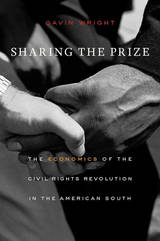 Sharing the Prize: The Economics of the Civil Rights Revolution in the American South
Gavin Wright
Harvard University Press, 2013 Winner of the Alice Hanson Jones Prize, Economic History Association
A Choice Outstanding Academic Title of the Year
The civil rights movement was also a struggle for economic justice, one that until now has not had its own history. Sharing the Prize demonstrates the significant material gains black southerners made—in improved job opportunities, quality of education, and health care—from the 1960s to the 1970s and beyond. Because black advances did not come at the expense of southern whites, Gavin Wright argues, the civil rights struggle was that rarest of social revolutions: one that benefits both sides.
“Wright argues that government action spurred by the civil-rights movement corrected a misfiring market, generating large economic gains that private companies had been unable to seize on their own.”
—The Economist
“Written…with the care and imagination [Wright] displayed in his superb work on slavery and the southern economy since the Civil War, this excellent economic history offers the best empirical account to date of the effects the civil rights revolution had on southern labor markets, schools, and other important institutions…With much of the nation persuaded that a post-racial age has begun, Wright’s analytical history…takes on fresh urgency.”
—Ira Katznelson, New York Review of Books
Sharing The Wonder Of Birds With Kids
Laura Erickson
University of Minnesota Press, 2002 On the wings of Laura Erickson’s award-winning book For the Birds comes Sharing the Wonder of Birds with Kids. Easy and fun to use, Sharing the Wonder is a delightful book that helps caring adults introduce kids to the fascinating world of birds. Chock-full of creative activities, this hands-on guide goes way beyond teaching bird identification. In her light-hearted style, Erickson paves the way for children to discover—with a little help from you—the beauty and significance of birds, how their bodies work, why they behave as they do, and why it’s critical to protect and care for them. Sharing the Wonder of Birds with Kids will show you how to kindle children’s interest in birds, giving them the joy and pride of discovering these natural treasures for themselves.
 The Shark and the Jellyfish: More Stories in Natural History
Stephen Daubert
Vanderbilt University Press, 2009 In this sequel to the acclaimed Threads from the Web of Life, Stephen Daubert presents twenty-six new stories that pull the reader into the mystery and immediacy of ecological processes ranging from the microscopic to the tectonic. Many show surprising intersections of creatures from different realms or the hidden interplay of evolving organisms. These gripping stories contain a level of intimacy and detail not usually encountered in other styles of natural history writing. Praise for the first collection of stories: Stephen Daubert's Threads from the Web of Life is written in the tradition of Aldo Leopold and Bernd Heinrich. It teaches by drawing you into the drama, excitement, and beauty of nature.
--Don Glass, host of the NPR-syndicated program "A Moment of Science" Threads from the Web of Life is a uniquely wide-ranging combination of scientific research and literary imagination that takes the reader on journeys through time and space that even the most elaborate television programs still can't provide. Stephen Daubert's grasp of a variety of botanical, zoological, geological, and climatological disciplines is impressive, and he presents them and their interactions with grace and authority.
--David Rains Wallace, author of The Klamath Knot, The Monkey's Bridge, and Beasts of Eden Each of these happenings is a thread in the intricate web of life, and Daubert, a molecular scientist at the University of California, Davis, demonstrates that these threads are easily broken by humans. ... Instructive and entertaining.
--Publishers Weekly Threads from the Web of Life takes readers on a journey around the globe as the author describes unique and unusual ecological processes. It is ideal for casual reading as well as a source of selections to read aloud (!) or to link literature with the study of natural history.
--NSTA Recommends, National Science Teachers Association Highly recommended. ... The stories are as much enjoyable as they are informative.
--Science Books& Films
In these sixteen stories of the interplay of organisms, weather, and geophysics, many a being succumbs to predation, and many another endures. Evolution happens as species learn the hard way. There is often a tragic element in these fascinating tales. . . . These vivid, poetic tales . . . afford good teaching. Threads from the Web of Life will appeal to any reader whose heart is in the living world.
-- ForeWord
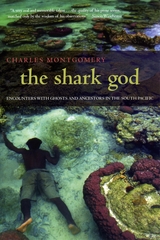 The Shark God: Encounters with Ghosts and Ancestors in the South Pacific
Charles Montgomery
University of Chicago Press, 2007
When Charles Montgomery was ten years old, he stumbled upon the memoirs of his great-grandfather, a seafaring missionary in the South Pacific. Twenty years later and a century after that journey, entranced by the world of black magic and savagery the bishop described, Montgomery set out for Melanesia in search of the very spirits and myths his great-grandfather had sought to destroy. In The Shark God, he retraces his ancestor’s path through the far-flung islands, exploring the bond between faith and magic, the eerie persistence of the spirit world, and the heavy footprints of the British Empire.
In the South Pacific, he discovers a world of sorcery and shark worship, where Christian and pagan rituals coexist and an ordinary day is marked by confrontations with America-worshiping cult leaders and militants alike. A defiantly original blend of history and memoir, anthropology and travel writing, The Shark God is ultimately a tale of personal and political transformation.
“The Shark God, a travel story as dark and twisted as one might ever wish to hear . . . reaches a superb climax with some apocalyptically page-turning scenes.”—Guardian
“A fascinating account of the drama of Melanesian life.”—Times Literary Supplement
“With exquisite writing, Montgomery lovingly captures the beauty and the horrors, the mysteries and the shams of the people and places he visits.”—Publishers Weekly
“A very real and memorable talent. . . . The endurance [Montgomery] displayed on his travels was admirable, the adventures he survived were tremendous, and the quality of his prose seems matched only by the wisdom of his observations.”—Simon Winchester, Globe and Mail (Toronto)
 Sharks and People: Exploring Our Relationship with the Most Feared Fish in the Sea
Thomas P. Peschak
University of Chicago Press, 2008 At once feared and revered, sharks have captivated people since our earliest human encounters. Children and adults alike stand awed before aquarium shark tanks, fascinated by the giant teeth and unnerving eyes. And no swim in the ocean is undertaken without a slight shiver of anxiety about the very real—and very cinematic—dangers of shark bites. But our interactions with sharks are not entirely one-sided: the threats we pose to sharks through fisheries, organized hunts, and gill nets on coastlines are more deadly and far-reaching than any bite. In Sharks and People acclaimed wildlife photographer Thomas Peschak presents stunning photographs that capture the relationship between people and sharks around the globe.
A contributing photographer to National Geographic, Peschak is best known for his unusual photographs of sharks—his iconic image of a great white shark following a researcher in a small yellow kayak is one of the most recognizable shark photographs in the world. The other images gathered here are no less riveting, bringing us as close as possible to sharks in the wild. Alongside the photographs, Sharks and People tells the compelling story of the natural history of sharks. Sharks have roamed the oceans for more than four hundred million years, and in this time they have never stopped adapting to the ever-changing world—their unique cartilage skeletons and array of super-senses mark them as one of the most evolved groups of animals. Scientists have recently discovered that sharks play an important role in balancing the ocean, including maintaining the health of coral reefs. Yet, tens of millions of sharks are killed every year just to fill the demand for shark fin soup alone. Today more than sixty species of sharks, including hammerhead, mako, and oceanic white-tip sharks, are listed as vulnerable or in danger of extinction.
The need to understand the significant part sharks play in the oceanic ecosystem has never been so urgent, and Peschak’s photographs bear witness to the thrilling strength and unique attraction of sharks. They are certain to enthrall and inspire.
 Sharks and Rays of Australia: Second Edition
Peter R. Last and John D. Stevens
Harvard University Press, 2009 The waters around Australia, the world’s smallest continent, are home to the greatest diversity of sharks and rays on Earth. Fully 100 of these sea creatures (along with their little-known relatives, the chimaerids) have been named or described since the first edition of this book—the biggest revision of the Class Chondrichthyes since the time of Linneaus. This second edition of Sharks and Rays of Australia brings more than 300 of these species to life in newly commissioned, full-color illustrations.
Here, in precisely painted detail, are the weird silvery ghost shark and the remarkably camouflaged ornate wobbegong; spurdogs and swell sharks; the primitive frilled shark and the blacktip, a fast swimmer capable of leaping out of the water like a dolphin. Peter Last and John Stevens review the major shake-ups in the elasmobranch family tree—sorting out, for instance, dogfishes and skates—and include updated family keys, the latest information about species ranges, and new distribution maps. Extensively revised species descriptions reflect additional fisheries and newly gleaned life history and biological information—all essential to conservation efforts as sharks die in commercial bycatches and end up on restaurant menus. An essential tool for conservation biologists trying to save threatened sharks, now under siege worldwide, this marvelous volume will also appeal to fish biologists, divers, naturalists, commercial and recreational fishermen, and anyone with an appreciation for these ancient evolutionary survivors.
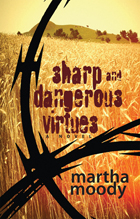 Sharp and Dangerous Virtues: A Novel
Martha Moody
Ohio University Press, 2012 It’s 2047 in Dayton, Ohio. In response to food and water shortages, the U.S. government has developed an enormous, and powerfully successful, agricultural area—the “Heartland Grid”—just north of the city. In the meantime, in the wake of declining American power a multinational force has established itself in Cleveland. Behind these quickly shifting alliances lies a troubling yet tantalizing question: what will the American future look like? Sharp and Dangerous Virtues is the story of ordinary people caught in situations they had never planned for or even imagined. There are Chad and Sharis, a married couple with two sons, holding out for normal life in their decaying suburb; Tuuro, a black church custodian whose false confession of murder is used for political purposes; Lila, Dayton’s aging, lonely Commissioner of Water, who dreams of being part of the “pure” existence of the Grid residents; and Charles and Diana, idealistic lovers trying desperately to preserve the nature center that has become their refuge. What will these people do? What choices are left for them, and what choices have been taken away? Whom and what can they trust? Novelist Moody—known for her vivid portrayals of complicated characters and relationships in novels such as Best Friends and Sometimes Mine—weaves together cataclysmic events and the most intimate of human emotions to create a future that seems achingly real. Sharp and Dangerous Virtues will change the way you think and feel.
 Sharpening the Legal Mind: How to Think Like a Lawyer
William Powers Jr, edited by John Deigh
University of Texas Press, 2023 The way lawyers think about the law can seem deeply mysterious. They see nuance and meaning in statutes and implications in judicial opinions that are opaque to the rest of us. Accessible and thought provoking, Sharpening the Legal Mind explains how lawyers analyze the cases and controversies that come before the courts. Written by William Powers Jr., the former president of the University of Texas at Austin, this book is an authoritative introduction to the academic study of law and legal reasoning, including insights into the philosophy of law and the intellectual history of legal thought. Powers discusses the methods lawyers use to interpret the law, the relation between law and morals, and the role of courts in shaping the law. In eight chapters, he follows the historical debate on these issues and others through different generations and movements in American legal thought—formalism, realism, positivism—to critical legal studies and postmodern theory. The perfect read for anyone looking for a primer on legal reasoning, Sharpening the Legal Mind demystifies the debates and approaches to thinking like a lawyer that profoundly influence the rule of law in our lives.
 Sharpshooter: A Novel of the Civil War
David Madden
University of Tennessee Press, 2005 A gripping and thought-provoking work that is unlike any Civil War novel previously written, Sharpshooter takes us into the mind of one of the war’s veterans as he attempts, years after the conflict, to reconstruct his experiences and to find some measure of meaning in them.
A child of the divided East Tennessee mountain region, Willis Carr left home at age thirteen to follow his father and brothers on a bridge-burning mission for the Union cause. Imprisoned at Knoxville, he agreed to join the Confederate army to avoid being hanged and became a sharpshooter serving under General Longstreet. He survived several major battles, including Gettysburg, and eventually found himself guarding prisoners at the infamous Andersonville stockade, where a former slave taught him to read.
After the war, haunted by his memories, Carr writes down his story, revisits the battlefields, studies photographs and drawings, listens to other veterans as they tell their stories, and pores over memoirs and other books. Above all, he embues whatever he hears, sees, and reads with his emotions, his imagination, and his intellect. Yet, even as an old man nearing death, he still feels that he has somehow missed the war, that something essential about it has eluded him. Finally, in a searing moment of personal revelation, a particular memory, long suppressed, rises to the surface of Carr’s consciousness and draws his long quest to a poignant close.
A compelling work of fiction from a writer who is both a gifted novelist and a distinguished student of the Civil War, David Madden’s Sharpshooter invites us to see this signal episode in American history in a new way—to grasp its facts, to imagine what facts cannot convey, and to make the war our own.
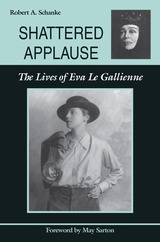 Shattered Applause: The Lives of Eva Le Gallienne
Robert A. Schanke. Foreword by May Sarton
Southern Illinois University Press, 1992 This comprehensive biography of the actress film critic Rex Reed called “a national treasure” draws on Robert A. Schanke’s interviews and correspondence not only with Eva Le Gallienne but also with more than one hundred of her colleagues and friends, including Glenda Jackson, Burgess Meredith, Eli Wallach, Peter Falk, Ellen Burstyn, Anne Jackson, Farley Granger, Jane Alexander, Uta Hagen, and Rosemary Harris. Forty-two illustrations offer highlights of Le Gallienne’s many notable performances in such plays as Hedda Gabler, Liliom, The Cherry Orchard, Peter Pan, Camille, Mary Stuart, The Royal Family,and The Dream Watcher. Behind her public role as a famous actress and as the founding and maintaining force of the first civic repertory theatre in the United States, Eva Le Gallienne led a private life complicated by her identity as a lesbian. Schanke considers Le Gallienne’s sexuality and how it played a role in the struggles, defeats, and triumphs that combined to inspire her greatness. Shattered Applause, a finalist for the Lambda Literary Award for Lesbian Nonfiction, tells a fascinating story that also serves as a barometer of the changing values, tastes, and attitudes of American society.
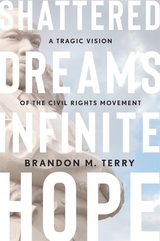 Shattered Dreams, Infinite Hope: A Tragic Vision of the Civil Rights Movement
Brandon M. Terry
Harvard University Press, 2025 A landmark reinterpretation of the civil rights movement that challenges reductive heroic narratives of the 1950s and 1960s and invigorates new debates and possibilities for the future of the struggle for liberation.
We are all familiar with the romantic vision of the civil rights movement: a moment when heroic African Americans and their allies triumphed over racial oppression through courageous protest, forging a new consensus in American life and law. But what are the effects of this celebratory storytelling? What happens when a living revolt against injustice becomes an embalmed museum piece?
In this innovative work, Brandon Terry develops a novel theory of interpretation to show how competing accounts of the civil rights movement circulate through politics and political philosophy. The dominant narrative is romantic. This “arc of justice” narrative is found in popular histories, the speeches of Barack Obama, and even the writings of the liberal philosopher John Rawls. Despite being public orthodoxy, these romantic visions are exhausted and unpersuasive on their own terms. The breakdown of the authority of this history of justice has created space for a rival ironic mode, embodied in the political ideas of Afropessimism. While offering a sympathetic critique, Terry ultimately finds Afropessimist thought self-undermining and unworkable.
Instead, he argues, the civil rights movement is best understood in tragic terms. By challenging the attachment to triumphant pasts, Terry demonstrates that tragedy exemplifies what the civil rights movement has been and can still be. Provocative and original, Shattered Dreams, Infinite Hope offers an optimistic political vision without naïveté, to train our judgment and resilience in the face of reasonable despair.
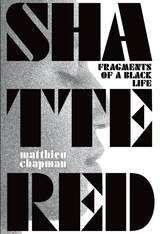 Shattered: Fragments of a Black Life
Matthieu Chapman
West Virginia University Press, 2023 A heartrending and engrossing memoir that challenges narratives of racial progress and postracial America.
“Every so often, a book comes along that changes the way we see, speak, and think about the world. Shattered is one of those books.” —Frank B. Wilderson III, author of Afropessimism and Incognegro
From a distance, Matthieu Chapman’s life and accomplishments serve as an example of racial progress in America: the first in his family to go to college, he earns two master’s degrees and a doctorate and then becomes a professor of theater. Despite his personal and academic success, however, the specter of antiblackness continues to haunt his every moment and interaction. Told through fragments, facets, shards, slivers, splinters, and absences, Shattered places Chapman’s own story in dialogue with US history and structural analysis of race to relay the experience of being very alive in a demonstrably antiblack society—laying bare the impact of the American way on black bodies, black psyches, and black lives. From the Church of Jesus Christ of Latter-day Saints to the offices of higher education, from a Loyal White Knights flyer on his windshield to a play with black students written by a black playwright, Chapman’s life story embodies the resistance that occurs, the shattering, collapsing, and reconfiguring of being that happens in the collisions between conceptions of blackness. Shattered is a heartrending and thought-provoking challenge to narratives of racial progress and postracial America—an important reminder that systemic antiblack racism affects every black person regardless of what they achieve in spite of it.
Shattered Justice: Crime Victims' Experiences with Wrongful Convictions and Exonerations
Kimberly J. Cook
Rutgers University Press, 2022 Shattered Justice presents original crime victims' experiences with violent crime, investigations and trials, and later exonerations in their cases. Using in-depth interviews with 21 crime victims across the United States, Cook reveals how homicide victims’ family members and rape survivors describe the painful impact of the primary trauma, the secondary trauma of the investigations and trials, and then the tertiary trauma associated with wrongful convictions and exonerations. Important lessons and analyses are shared related to grief and loss, and healing and repair. Using restorative justice practices to develop and deliver healing retreats for survivors also expands the practice of restorative justice. Finally, policy reforms aimed at preventing, mitigating, and repairing the harms of wrongful convictions is covered.
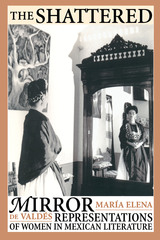 The Shattered Mirror: Representations of Women in Mexican Literature
By María Elena de Valdés
University of Texas Press, 1998 Popular images of women in Mexico—conveyed through literature and, more recently, film and television—were long restricted to either the stereotypically submissive wife and mother or the demonized fallen woman. But new representations of women and their roles in Mexican society have shattered the ideological mirrors that reflected these images. This book explores this major change in the literary representation of women in Mexico. María Elena de Valdés enters into a selective and hard-hitting examination of literary representation in its social context and a contestatory engagement of both the literary text and its place in the social reality of Mexico. Some of the topics she considers are Carlos Fuentes and the subversion of the social codes for women; the poetic ties between Sor Juana Inés de la Cruz and Octavio Paz; questions of female identity in the writings of Rosario Castellanos, Luisa Josefina Hernández, María Luisa Puga, and Elena Poniatowska; the Chicana writing of Sandra Cisneros; and the postmodern celebration—without reprobation—of being a woman in Laura Esquivel's Like Water for Chocolate.
 Shattered Mirrors: Our Search for Identity and Community in the AIDS Era
Monroe E. Price
Harvard University Press, 1989 The AIDS epidemic has touched the lives of all Americans. An entire generation has been forced to redefine the way it looks at intimacy. Our very images of ourselves are being altered in the wake of this tragic illness. Yet we are only now beginning to discover the true extent of the change AIDS has wrought on American society. This massive challenge to public health is creating a fault line beneath our institutions, threatening to undermine much that we have taken for granted about the pillars of our culture. Looking out across the landscape of AIDS, we sense a fundamental shift in the way we think about ourselves, about others, and about government.
Shattered Mirrors is a deeply moving meditation on the impact AIDS is having on American consciousness. AIDS has become a moral lesson for our nation, Monroe Price argues, but not the narrow lesson about the dangers of deviancy that certain segments of society have professed. The AIDS epidemic challenges some of our most cherished ideas about individual autonomy, free expression, fairness, and confidence in the future. As this book points out, the ultimate legacy of the AIDS epidemic is far more than its terrible impact on the health of the citizenry.
As the disease grinds on, several traditional barriers between church and state, government and the media, citizen and consumer have begun to erode, while other barriers of class, race, and lifestyle are growing larger. It is too early to say whether these and similar changes will be permanent, but as long as there is uncertainty about how devastating AIDS will prove to be to our society, we will continue to debate its meaning and how we should respond to the threat it poses to all of us. In the long run, Price maintains, AIDS may force us to reexamine the role government should play in shaping our personal lives. More than this, it may well oblige us to redefine what we mean by identity and community in a democracy under siege.
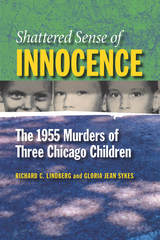 Shattered Sense of Innocence: The 1955 Murders of Three Chicago Children
Richard C. Lindberg and Gloria Jean Sykes
Southern Illinois University Press, 2006 In October 1955, three Chicago boys were found murdered, their bodies naked and dumped in a ditch in Robinson Woods on the city’s Northwest Side. A community and a nation were shocked. In a time when such crimes against children were rare, the public was transfixed as local television stations aired stark footage of the first hours of the investigation. Life and Newsweek magazines published exclusive stories the following week. When Kenneth Hansen was convicted and sentenced for the murders, the case was considered solved—until questions were raised about Hansen’s presumed guilt.
Shattered Sense of Innocence: The 1955 Murders of Three Chicago Children tells the gripping story of the three murdered boys—thirteen-year-old John Schuessler, his eleven-year-old brother, Anton, and thirteen-year-old Bobby Peterson—and the quest to find and bring to justice their killer. Authors Richard C. Lindberg and Gloria Jean Sykes recount the bungled 1955 police investigation, the failures of multiple law enforcement agencies, and the subsequent convictions of Kenneth Hansen, in 1995 and 2002, and present new information concerning two suspects overlooked by police for five decades.
The authors deftly examine all sides of this tragic story, drawing on exclusive interviews with law enforcement agents, with horse trainers affiliated with the so-called horse mafia, and with the man convicted of the murders, Kenneth Hansen. This intensely intimate account offers a rare glimpse into one community and examines how these atrocious crimes altered public perceptions nationwide. Shattered Sense of Innocence, which is also a story of political controversy, a determined federal agent’s quest for justice, and a community’s loss of innocence, includes fifty illustrations.
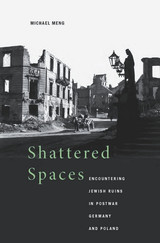 Shattered Spaces: Encountering Jewish Ruins in Postwar Germany and Poland
Michael Meng
Harvard University Press, 2011 After the Holocaust, the empty, silent spaces of bombed-out synagogues, cemeteries, and Jewish districts were all that was left in many German and Polish cities with prewar histories rich in the sights and sounds of Jewish life. What happened to this scarred landscape after the war, and how have Germans, Poles, and Jews encountered these ruins over the past sixty years?
In the postwar period, city officials swept away many sites, despite protests from Jewish leaders. But in the late 1970s church groups, local residents, political dissidents, and tourists demanded the preservation of the few ruins still standing. Since the collapse of the Soviet Union in 1989, this desire to preserve and restore has grown stronger. In one of the most striking and little-studied shifts in postwar European history, the traces of a long-neglected Jewish past have gradually been recovered, thanks to the rise of heritage tourism, nostalgia for ruins, international discussions about the Holocaust, and a pervasive longing for cosmopolitanism in a globalizing world.
Examining this transformation from both sides of the Iron Curtain, Michael Meng finds no divided memory along West–East lines, but rather a shared memory of tensions and paradoxes that crosses borders throughout Central Europe. His narrative reveals the changing dynamics of the local and the transnational, as Germans, Poles, Americans, and Israelis confront a built environment that is inevitably altered with the passage of time. Shattered Spaces exemplifies urban history at its best, uncovering a surprising and moving postwar story of broad contemporary interest.
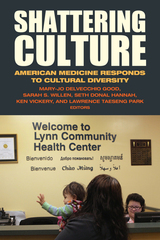 Shattering Culture: American Medicine Responds to Cultural Diversity
Mary-Jo DelVecchio Good
Russell Sage Foundation, 2012 "Culture counts" has long been a rallying cry among health advocates and policymakers concerned with racial disparities in health care. A generation ago, the women's health movement led to a host of changes that also benefited racial minorities, including more culturally aware medical staff, enhanced health education, and the mandated inclusion of women and minorities in federally funded research. Many health professionals would now agree that cultural competence is important in clinical settings, but in what ways? Shattering Culture provides an insightful view of medicine and psychiatry as they are practiced in today's culturally diverse clinical settings. The book offers a compelling account of the many ways culture shapes how doctors conduct their practices and how patients feel about the care they receive. Based on interviews with clinicians, health care staff, and patients, Shattering Culture shows the human face of health care in America. Building on over a decade of research led by Mary-Jo Good, the book delves into the cultural backgrounds of patients and their health care providers, as well as the institutional cultures of clinical settings, to illuminate how these many cultures interact and shape the quality of patient care. Sarah Willen explores the controversial practice of matching doctors and patients based on a shared race, ethnicity, or language and finds a spectrum of arguments challenging its usefulness, including patients who may fear being judged negatively by providers from the same culture. Seth Hannah introduces the concept of cultural environments of hyperdiversity describing complex cultural identities. Antonio Bullon and Mary-Jo Good demonstrate how regulations meant to standardize the caregiving process—such as the use of templates and check boxes instead of narrative notes—have steadily limited clinician flexibility, autonomy, and the time they can dedicate to caring for patients. Elizabeth Carpenter-Song looks at positive doctor-patient relationships in mental health care settings and finds that the most successful of these are based on mutual "recognition"—patients who can express their concerns and clinicians who validate them. In the book's final essay, Hannah, Good, and Park show how navigating the maze of insurance regulations, financial arrangements, and paperwork compromises the effectiveness of mental health professionals seeking to provide quality care to minority and poor patients. Rapidly increasing diversity on one hand and bureaucratic regulations on the other are two realities that have made providing culturally sensitive care even more challenging for doctors. Few opportunities exist to go inside the world of medical and mental health clinics and see how these realities are influencing patient care. Shattering Culture provides a rare look at the day-to-day experiences of psychiatrists and other clinicians and offers multiple perspectives on what culture means to doctors, staff, and patients and how it shapes the practice of medicine and psychiatry.
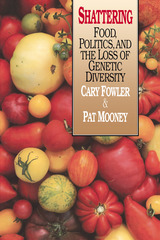 Shattering: Food, Politics, and the Loss of Genetic Diversity
Cary Fowler and Pat Mooney
University of Arizona Press, 1990
It was through control of the shattering of wild seeds that humans first domesticated plants. Now control over those very plants threatens to shatter the world's food supply, as loss of genetic diversity sets the stage for widespread hunger.
Large-scale agriculture has come to favor uniformity in food crops. More than 7,000 U.S. apple varieties once grew in American orchards; 6,000 of them are no longer available. Every broccoli variety offered through seed catalogs in 1900 has now disappeared. As the international genetics supply industry absorbs seed companies—with nearly one thousand takeovers since 1970—this trend toward uniformity seems likely to continue; and as third world agriculture is brought in line with international business interests, the gene pools of humanity's most basic foods are threatened.
The consequences are more than culinary. Without the genetic diversity from which farmers traditionally breed for resistance to diseases, crops are more susceptible to the spread of pestilence. Tragedies like the Irish Potato Famine may be thought of today as ancient history; yet the U.S. corn blight of 1970 shows that technologically based agribusiness is a breeding ground for disaster.
Shattering reviews the development of genetic diversity over 10,000 years of human agriculture, then exposes its loss in our lifetime at the hands of political and economic forces. The possibility of crisis is real; this book shows that it may not be too late to avert it.
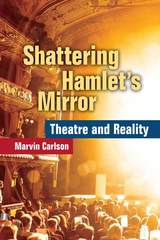 Shattering Hamlet's Mirror: Theatre and Reality
Marvin Carlson
University of Michigan Press, 2016 Theatrical playing, Hamlet famously averred, holds a mirror up to nature. But unlike the reflections in the mirror, the theater’s images are composed of real objects, most notably bodies, that have an independent existence outside the world of reflection. Throughout Western theater history there have been occasions when the reality behind the illusion was placed on display. In recent years theaters in Europe and North America have begun calling attention to the real in their work—presenting performers who did not create characters and who may not even have been actors, but who appeared on stage as themselves; texts created not by dramatic authors but drawn from real life; and real environments sometimes shared by actors and performers and containing real elements accessible to both. These practices, argues Marvin Carlson, constitute a major shift in the practical and phenomenological world of theater, and a turning away from mimesis, which has been at the heart of the theater since Aristotle. Shattering Hamlet's Mirror: Theatre and Reality examines recent and contemporary work by such groups as Rimini Protokoll, Societas Raffaelo Sanzio, the Gob Squad, Nature Theatre of Oklahoma, and Foundry Theatre, while revealing the deep antecedents of today’s theater, placing it in useful historical perspective. While many may consider it a post-postmodern phenomenon, the “theater of the real,” as it turns out, has very deep roots.
 Shattering the Self in Early Modern English Verse: Gender, Sex, and Queerness Beyond the Human
Gina Filo
Northwestern University Press, 2026 Reconfiguring our understanding of early modern English erotic and literary landscapes
Rejecting the ideals of stability and sexual mastery demanded of masculine subjects, early modern English poets threw the limits of bodies and selves into question to embrace erotic experiences of genderqueer and transspecies embodiment and affiliation. Through close readings of still-canonical and lesser-read writers including William Shakespeare, John Donne, and Thomas Traherne, Gina Filo shows how these experimental encounters at the limits of the human were inextricable parts of the early modern literary and sexual imaginaries.
In its exploration of nonnormative forms of erotic attachment and embodiment, Shattering the Self in Early Modern English Verse: Gender, Sex, and Queerness Beyond the Human contributes to the burgeoning fields of early modern trans and ecocritical studies while also drawing on contemporary queer theory. Filo neither seeks to naively recuperate a fantasized past nor cedes relationality, sociality, or generativity to the normative. Instead, she shows how the embrace of erotic possibility, flexible, unstable subjectivities, and querying of the limits of “the human” were core features of early modern poetics, reconfiguring our understanding of English literary history and queer relationality today.
 Shawnee: Ceremonialism Native American Tribe
James H. Howard
Ohio University Press, 1981 In spite of the important role of the Shawnee tribe of American Indians in the Colonial period and the early years of the American republic, they have been virtually ignored by the scholarly world. Anthropologists have paid little attention to the Shawnees, despite the tribe’s rich culture and pivotal position among the other tribes in eastern North America.
In this first comprehensive account of Shawnee culture, Dr. Howard assembled data concerning the tribe by utilizing published accounts, documents, maps, photographs, and paintings; and by visiting present-day Shawnees and participating in their ceremonies, games and everyday activities. The work is embellished with musical notations of Shawnee songs, maps, heirloom photographs and several photographs taken by the author during his fieldwork. Of particular interest is a remarkable series of paintings of Shawnee life by gifted Shawnee artist, Earnest Spybuck.
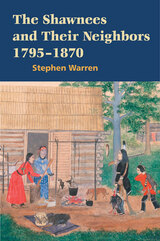 The Shawnees and Their Neighbors, 1795-1870
Stephen Warren
University of Illinois Press, 2004 Stephen Warren traces the transformation in Shawnee sociopolitical organization over seventy years as it changed from village-centric, multi-tribe kin groups to an institutionalized national government led by wealthy men with only marginal kin ties to the people they claimed to represent. The Shawnees and Their Neighbors, 1795-1870 lays bare the myths and histories produced by Shawnee interpreters and their vested interests in modernizing the tribes. Until recently, historians have assumed that Central Algonquians derive from politically unified tribes, but by analyzing the crucial role that individuals, institutions, and policies played in shaping modern tribal governments, Warren reveals a messier, more complicated history of migration and conflict. Ultimately, Warren establishes that the form of the modern Shawnee "tribe" was coerced in accordance with the U.S. government's desire for an entity with whom to do business, rather than as a natural development of traditional Shawnee ways.
Shawnese Traditions: C. C. Trowbridge's Account
Edited by Vernon Kinietz and Erminie Voegelin
University of Michigan Press, 1939 C. C. Trowbridge wrote reports on the customs of the Miami, Menominee, Shawnee, and Wyandot tribes. It is believed that he wrote the manuscript entitled Shawnese Traditions around 1824; the University of Michigan published it in 1939.
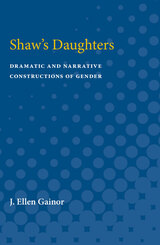 Shaw's Daughters: Dramatic and Narrative Constructions of Gender
J. Ellen Gainor
University of Michigan Press, 1991 For almost a century critics of George Bernard Shaw's dramatic works have accepted the characterization of Shaw as an artist and thinker well ahead of his time with regard to social issues—women's liberation in particular. Since the first wave of feminist criticism in the 1960s and 1970s, however, very little effort has been made to examine Shaw's works in the light of the most recent and challenging developments in feminist theory and gender studies. Now, at a time of renewed historical interest in his plays, J. Ellen Gainor brings the critical understanding of Shaw's work into the present day.Gainor introduces previously unexamined reviews and articles by Shaw's female contemporaries—and discovers among them a remarkable resistance to his depictions of women. Through an analysis of three major character tropes Gainor discovers dramaturgical patterns in Shaw's gender construction that work against the contention that the author created positive and progressive images of women and that situate his work well within the dominant social ideologies of the late Victorian and Edwardian eras.Gainor demonstrates that positioning Shaw firmly among his contemporaries may actually resolve some of the troubling issues in his dramaturgy, allowing us to understand more clearly the origins of a number of his female character types, and even to see continuities throughout his work where they have not been shown before.
Shayndl and Salomea: From Lemberg to Berlin
Salomea Genin
Northwestern University Press, 1997 At the age of fifty and faced with severe depression, Salomea Genin began to write about her family's history. From stories both told and untold, Genin recreates the lives of the Zwerling family in the Jewish quarter of Lvov: Shulim, her strict and deeply religious grandfather; his patient but tired wife Dvoire; and his beautiful, rebellious daughter Shayndl, who marries a dreamer against her father's wishes and without his blessing, and who will later become Salomea Genin's mother.
Genin's richly detailed portrait shows the effects of a family's struggle—personal, religious, social, and for their very survival—against the shadow of the Nazi rise to power.
Shays' Rebellion: The Making of an Agrarian Insurrection
David P. Szatmary
University of Massachusetts Press, 1980 We are currently updating our website and have not yet posted complete information for this title. Many of our books are in the Google preview program, which allows readers to view up to 20% of the book. If this title is active in the program, you will find the Google Preview button in the sidebar below.
She Being Dead Yet Speaketh: The Franklin Family Papers
Mary Franklin and Hannah Burton
Iter Press, 2020 On Black Bartholomew’s Day—August 24, 1662—nearly two thousand ministers denied the authority of the Church of England and were subsequently removed from their posts. Mary Franklin was the wife of Presbyterian minister Robert Franklin, one of the dissenting ministers ejected from their pulpits and their livings on that day. She recorded the experience of her persecution in the unused pages of her husband’s sermon notebook. In 1782—some hundred years after the composition of her grandmother’s narrative— Mary’s granddaughter, Hannah Burton, took up this same notebook to chronicle her experience as an impoverished widow, barely surviving the economic revolutions of eighteenth-century London.
Collected for the first time, this volume of the Franklin Family Papers offers rare insight into the personal lives of three generations of dissenting women.
 She Came from Mariupol
Natascha Wodin
Michigan State University Press, 2022 WINNER OF THE 2017 LEIPZIG BOOK FAIR PRIZE—When Natascha Wodin’s mother died, Natascha was only ten years old—too young to find out what her mother had experienced during World War II. All the little girl knew was that they were detritus, human debris left over from the war. Years later, Natascha set out on a quest to find out what happened to her mother during that time. Why had they lived in a camp for “displaced persons”? Where did her mother come from? What had she experienced? The one thing she knew is that her parents had to leave Mariupol in Ukraine for Germany as part of the Nazi forced labor program in 1943. Armed with this limited knowledge, Natascha resolved to piece together the puzzle of her family’s past. The result is a highly praised, beautiful piece of prose that has drawn comparisons to W. G. Sebald in its approach. Like Sebald, Natascha’s aim is to reclaim the stories of those who can no longer speak for themselves. The author is not only in search of her own family’s history, but she is also aware that she is charting unmarked territory: accounts of the plight of forced laborers and displaced persons are still a rarity within literature about World War II and its atrocities. Natascha’s personal homage to her mother’s life story is an important lyrical memorial for the thousands of Eastern Europeans who were forced to leave their homes and work in Germany during the war, and a moving reflection of the plight of displaced peoples throughout the ages. This is a darkly radiant account of one person’s fate, developing momentous emotive power—its subject serves as a proxy for the fate of millions.
 She Devils at the Door
Eliza Smith Brown
Carnegie Mellon University Press, 2023 The true story of the Gilded Age’s “political twins” who brought women’s suffrage and political reform to the city of Pittsburgh.
Sometimes troublemakers emerge from the most unlikely of places. This true story follows the lives of two daughters of the Gilded Age—Lucy and Eliza Kennedy—who were educated at Vassar College and became leaders of the suffrage movement. Then, after the Nineteenth Amendment was passed in 1920, they spent the next forty years fighting corruption in politics and government.
Tenacious, smart, and witty, they captivated crowds, disarmed their opponents, and instilled particular dread among the corrupt politicians who were the unfortunate targets of their nonpartisan crusade. Their entry across the threshold of Pittsburgh’s City-County Building would reportedly invoke a flurry of hushed warnings through the halls: “The She Devils are at the door!” Together, Lucy and Eliza fought for the vote, empowered women to use it wisely, forced a mayor out of office in disgrace, took control of the city budget, exposed a series of scandals, spearheaded police reform, and launched a campaign that would eventually clear Pittsburgh of its smoky veil.
Featuring the true story of two powerful women, this book comes at a propitious time, reminding us how far women have come and how vigilant we must remain.
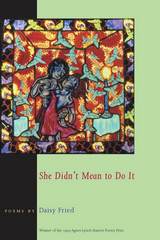 She Didn't Mean to Do It
Daisy Fried
University of Pittsburgh Press, 2000 "The poems successfully maintain a delicate balance, a unique and distinct interior logic." --Philadelphia City Paper
"The poems in Daisy Fried's first collection of poetry read like tough, urban fables. Formally innovative and thematically challenging, these poems traverse the geography of sex and teenage initiation rights . . . These poems resist being pinned down. They roam the pages in a kind of tight, disruptive free verse." --Ploughshares
"Fried shows that poetry can be lyrical, bombastic, garrulous even, and still transport her readers." --Pittsburgh Tribune-Review
"Maybe this is the book of the year, it has such range and it is so well-written, for her faithfulness to her emotion is matched by her carefulness of execution." --Thom Gunn
"Fried's poetry attacks and attacks, and gets through. And when it does, it does because she jams the right words into a strikingly original order with ferocity, intelligence and dash." --August Kleinzahler
"Of the urban landscape-its grit, power, ugly beauty, comedy and pain, Daisy Fried makes vital poetry." --Alicia Suskin Ostriker
Daisy Fried, recipient of a Pew Fellowship in poetry, has published widely in journals, including American Poetry Review, Indiana Review, Antioch Review, Colorado Review, Ploughshares, and Threepenny Review. She has written articles and book reviews for Glamour, Philadelphia Magazine, Newsday, and Philadelphia Inquirer, among others, and has taught creative writing at Haverford College and Rutgers University. She holds a B.A. in English from Swarthmore College and lives in South Philadelphia.
She Has a Name
Kamilah Aisha Moon
Four Way Books, 2013 With unrelenting yet tender honesty, She Has a Name tells the story of a young woman with autism from multiple points of view. The speakers in these poems—sisters, mother, father, teacher—seek to answer questions science can’t yet answer, seek to protect the young woman, and seek to understand what autism means to their own lives as well.
'She said she was in the family way': Pregnancy and Infancy in Modern Ireland
Edited by Elaine Farrell
University of London Press, 2012 She said she was in the family way' examines the subject of pregnancy and infancy in Ireland from the seventeenth to the twentieth century. It draws on exciting and innovative research by early-career and established academics, and consider topics that have been largely ignored by historians in Ireland. The book will make an important contribution to Irish women’s history, family history, childhood history, social history, crime history and medical history, and will provide a reference point for academics interested in themes of sexuality, childbirth, infanthood and parenthood.
She Took Off Her Wings And Shoes
Suzette Bishop
Utah State University Press, 2004 Suzette Marie Bishop teaches writing at Texas A&M International University. This will be her first full-length book, though she's published a chapbook and many individual poems in national poetry journals. Nominated twice for the Pushcart Prize, Ms. Bishop's credits include publications in Antioch Review, 13th Moon, Eratica, Aries, The Little Magazine, and many other literary journals. As a poet and writing teacher on the faculty of Texas A&M International, she gives many readings, as well as workshops for gifted children, seniors, and other writers on the US-Mexico border; she has worked with at-risk youth and with the rural Hispanic community.
 She Walks Into the Sea
Patricia Clark
Michigan State University Press, 2009 Patricia Clark's poems explore not only refuge but also wonder and appreciation, as well as astonishment.
A number of the 56 poems collected here show her grappling with loss, especially the loss of her mother, though she isn't one to indulge in misery. Instead, she goes walking. It is the harp tree in "The Poplar Adrift" that Clark imagines giving voice to sorrow, thus sparing those who stroll by—"all the grief that passes" becoming, in the tree’s very fibers, sound on the air, a wind through branches and leaves.
Clark also finds opportunities for learning, for meditation, and for contemplation. Octavio Paz has written, "Nature speaks as though it were a lover." In many of the poems collected here, Clark listens to nature speaking and revels in this lover, aiming to capture some of the qualities of Michigan's trees, birds, and landscapes in lyric poems.
It is Clark's particular gift to give us "tasted" as she draws her readers into the world, inhabiting the worlds of nature, head, and heart.
She Works/He Works: How Two-Income Families Are Happy, Healthy, and Thriving
Rosalind C. Barnett and Caryl Rivers
Harvard University Press, 1996 Readable and challenging, this four-year study of three hundred middle-class and working-class couples debunks the myth of the overwrought working mother with her insensitive husband and neglected children. Drawing on extensive cross-disciplinary research, Rosalind Barnett and Caryl Rivers argue that “collaborative couples,” busy as they are, thrive in their diverse roles, and inspire competence and confidence in their children.
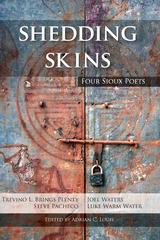 Shedding Skins: Four Sioux Poets
Adrian C. Louis
Michigan State University Press, 2008 Here's the myth: Native Americans are people of great spiritual depth, in touch with the rhythms of the earth, rhythms that they celebrate through drumming and dancing. They love the great outdoors and are completely in tune with the natural world. They can predict the weather by glancing at the sky, or hearing a crow cry, or somehow. Who knows exactly how? The point of the myth is that Indians are, well, special. Different from white people, but in a good way.
The four young male Native American poets whose work is brought together in this startling collection would probably raise high their middle fingers in salute to this myth. These guys and "guys" they are—don't buy into the myth. Their poems aren't about hunting and fishing or bonding with animal spirits. Their poems are about urban decay and homelessness, about loneliness and despair, about Payday Loans and 40-ounce beers, about getting enough to eat and too much to drink. And there is nothing romantic about their poetry, either. It is written in the vernacular of mean streets: often raw and coarse and vulgar, just like the lives it describes. Sure, they write about life on the reservation. However, for the Indians in their poems, life on the reservation is a lot like life in the city, but without the traffic. These poets are sick to death of the myth. You can feel it in their poems.
These poets are bound by a common attitude as well as a common heritage. All four—Joel Waters, Steve Pacheco, Luke Warm Water, and Trevino L. Brings Plenty—are Sioux, and all four identify themselves as "Skins" (as in "Redskins"). In their poems, they grapple with their heritage, wrestling with what it means to be a Sioux and a Skin today. It's a fight to the finish.
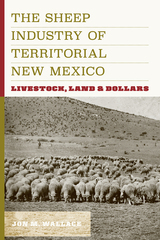 The Sheep Industry of Territorial New Mexico: Livestock, Land, and Dollars
Jon M. Wallace
University Press of Colorado, 2023 The Sheep Industry of Territorial New Mexico offers a detailed account of the New Mexico sheep industry during the territorial period (1846–1912) when it flourished. As a mainstay of the New Mexico economy, this industry was essential to the integration of New Mexico (and the Southwest more broadly) into the national economy of the expanding United States.
Author Jon Wallace tells the story of evolving living conditions as the sheep industry came to encompass innumerable families of modest means. The transformation improved many New Mexicans’ lives and helped establish the territory as a productive part of the United States. There was a cost, however, with widespread ecological changes to the lands—brought about in large part by heavy grazing. Following the US annexation of New Mexico, new markets for mutton and wool opened. Well-connected, well-financed Anglo merchants and growers who had recently arrived in the territory took advantage of the new opportunity and joined their Hispanic counterparts in entering the sheep industry.
The Sheep Industry of Territorial New Mexico situates this socially imbued economic story within the larger context of the environmental consequences of open-range grazing while examining the relationships among Hispanic, Anglo, and Indigenous people in the region. Historians, students, general readers, and specialists interested in the history of agriculture, labor, capitalism, and the US Southwest will find Wallace’s analysis useful and engaging.
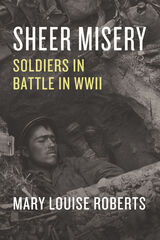 Sheer Misery: Soldiers in Battle in WWII
Mary Louise Roberts
University of Chicago Press, 2021 Marching across occupied France in 1944, American GI Leroy Stewart had neither death nor glory on his mind: he was worried about his underwear, which was engaged in a relentless crawl of its own. Similar complaints of physical discomfort pervade infantrymen’s memories of the European theater, whether the soldiers were British, American, German, or French. Wet, freezing misery with no end in sight—this was life for millions of enlisted men during World War II.
Sheer Misery trains a humane and unsparing eye on the corporeal experiences of the soldiers who fought in Belgium, France, and Italy during the last two years of the war. In the horrendously unhygienic and often lethal conditions of the front line, their bodies broke down, stubbornly declaring their needs for warmth, rest, and good nutrition. Feet became too swollen to march, fingers too frozen to pull triggers; stomachs cramped, and diarrhea stained underwear and pants. Turning away from the accounts of high-level military strategy that dominate many WWII chronicles, acclaimed historian Mary Louise Roberts instead relies on diaries and letters to bring to life visceral sense memories like the moans of the “screaming meemies,” the acrid smell of cordite, and the shockingly mundane sight of rotting corpses. As Roberts writes, “For soldiers who fought, the war was above all about their bodies.”
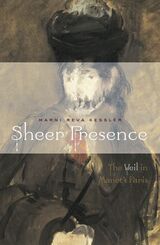 Sheer Presence: The Veil in Manet’s Paris
Marni Reva Kessler
University of Minnesota Press, 2006 Tamar’s instrument of seduction in the Hebrew Bible, Penelope’s shroud in Homer’s Odyssey, accessory of brides as well as widows, and hallmark of the religious and the wealthy, the veil has historically been an intriguing signifier. Initially donned in France for liturgical purposes and later for masked balls and as a sun- and windscreen at the seashore, face-covering veils were adopted for fashionable urban use during the reign of Napoleon III. In Sheer Presence, Marni Reva Kessler demonstrates how this ubiquitous garment and its visual representations knot together many of the precepts of Parisian life. Considering the period from the beginning of Napoleon III’s rule in 1852 to 1889, when the Paris Universal Exhibition displayed veiled North African Muslims and other indigenous colonial peoples, Kessler deftly connects the increased presence of the veil on the streets and on canvas to Haussmann’s massive renovation of Paris. The fashion of veil wearing, she argues, was imbricated with broader concerns: fears of dust and disease fueled by Haussmannization and class mixing on the city streets, changes in ideals of youth and beauty, attempts to increase popular support for imperialism, and the development of modernist art practices. A veil was protection for the proper woman from the vices associated with the modern city, preserving—at least on the surface—her femininity and class superiority. Kessler explores these themes with close readings of paintings by Gustave Caillebotte, Edgar Degas, and Edouard Manet—including Manet’s perplexing portraits of artist Berthe Morisot—as well as photographs, images from the popular press, engravings, lithographs, and academic paintings. She also mines French fashion journals, etiquette books, novels, and medical publications for clues to the veil’s complex meanings during the period.Positioning the veil directly at the intersection of feminist, formalist, and social art history, Kessler offers a fresh perspective on period discourses of public health, seduction and sexuality, colonial stereotypes, and, ultimately, an emerging modernity.Marni Reva Kessler is assistant professor of art history at the University of Kansas.
Sheet Music
Robert Gibb
Autumn House Press, 2012 In Gibb's second Autumn House Poetry collection, he finds sublime music in everyday city life. He offers a roadmap to hear the music of life and nature within the context of an industrial setting.
Shelby’s Expedition to Mexico: An Unwritten Leaf of the War
John R. Edwards
University of Arkansas Press, 2007 Confederate general Joseph O. Shelby and his legendary Iron Brigade refused to acknowledge the end of the Civil War. Instead, they fought their way to Mexico in search of a place where they could continue to defy the U.S. government. These veteran Missouri cavalrymen clawed their way for fifteen hundred miles, fighting Juaristas, Indians, desperados, and disgruntled gringos. They disbanded only after they had offered their services to Emperor Maximilian and were turned down. Shelby’s adjutant, journalist John N. Edwards, first published his story of the exploits of this superb mounted brigade and its quixotic final march in 1872. Conger Beasley provides a lively introduction that includes the first biographical sketch of the author. The 1969 movie The Undefeated starring John Wayne and Rock Hudson was based upon Shelby’s expedition.
Shelf Life: Essays, Memoirs, and an Interview
Thom Gunn
University of Michigan Press, 1993 Born and raised in Britain, Thom Gunn has lived in the United States since 1954. He is well known as a poet and is increasingly gaining recognition as a literary critic. Gunn’s main concern in Shelf Life is with twentieth-century American poets, both the famous and the obscure; he also discusses other matters, including the Elizabethans, Christopher Isherwood as man and stylist, and Gunn’s own poetry, which he touches on indirectly in the first two sections of the book and directly in the last.
Gunn’s criticism communicates his own enthusiasm for poetry. He tries to show his readers how to get a first foothold into the work of some of his favorite poets, whether Wyatt or Whitman, Mina Loy or Robert Creeley.
 Shelf Life: Literary Essays and Reviews
William H. Pritchard
University of Massachusetts Press, 2009 In this collection of essays and reviews, William H. Pritchard focuses on the work of English and American writers, most of them from the twentieth century. At a time when English studies in the academy seems increasingly impelled by historical and political concerns, Pritchard's aim is to reinstate the aesthetic as the major motive for literary study. Indeed "study" may be the wrong word for it, as the poet Philip Larkin made forcefully evident when he once snapped at an interviewer, "Oh, for Christ's sake one doesn't study poets. You read them and think, that's marvelous, how is it done, could I do it?"
Pritchard is convinced that his job as a critic is to talk back to the imagination he has been engaged by. The four sections of this volume look at writers as diverse as the critic Samuel Johnson, the novelist Raymond Chandler, and the poet James Merrill, and at the abrasive epistolary behavior of Evelyn Waugh and Kingsley Amis. Perhaps the book's most original section is its final one, in which Pritchard writes about music-about playing the piano, singing hymns, listening to jazz-and about the teaching life as it appears in literature and in his own classroom. He concludes with appreciative essays on two of his own fondly remembered teachers.
Shelf Life is mannerly and elegant, but venturesome, even bold in its explorations of the artistic performance-of that passionate preference Robert Frost found to be the root of all human expression.
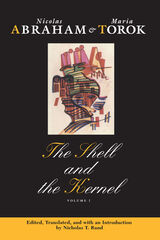 The Shell and the Kernel: Renewals of Psychoanalysis, Volume 1
Nicolas Abraham and Maria Torok
University of Chicago Press, 1994 This volume is a superb introduction to the richness and originality of Abraham and Torok's approach to psychoanalysis and their psychoanalytic approach to literature. Abraham and Torok advocate a form of psychoanalysis that insists on the particularity of any individual's life story, the specificity of texts, and the singularity of historical situations. In what is both a critique and an extension of Freud, they develop interpretive strategies with powerful implications for clinicians, literary theorists, feminists, philosophers, and all others interested in the uses and limits of psychoanalysis.
Central to their approach is a general theory of psychic concealment, a poetics of hiding. Whether in a clinical setting or a literary text, they search out the unspeakable secret as a symptom of devastating trauma revealed only in linguistic or behavioral encodings. Their view of trauma provides the linchpin for new psychic and linguistic structures such as the "transgenerational phantom," an undisclosed family secret handed down to an unwitting descendant, and the intra-psychic secret or "crypt," which entombs an unspeakable but consummated desire. Throughout, Abraham and Torok seek to restore communication with those intimate recesses of the mind which are, for one reason or another, denied expression.
Classics of French theory and practice, the essays in volume one include four previously uncollected works by Maria Torok. Nicholas Rand supplies a substantial introductory essay and commentary throughout. Abraham and Torok's theories of fractured meaning and their search for coherence in the face of discontinuity and disruption have the potential to reshape not only psychoanalysis but all disciplines concerned with issues of textual, oral, or visual interpretation.
 Shell Day: A Story of 24 Hours and 24 Molluscan Lives
Helen Scales
University of Chicago Press, 2026 An hourly guide that follows twenty-four mollusks to reveal the fascinating lives behind their shells.
From morning to night and from the Arctic to the equator, snails, clams, and other shell-making mollusks have busy days. In this short book, award-winning author and marine biologist Helen Scales shows readers exactly how these animals spend their time. Each chapter of Shell Day features a single mollusk during a single hour, highlighting twenty-four unique species.
We begin our day far in the north, where the Svalbard archipelago lies deep in the darkness of the polar night. And yet, in what remains a scientific mystery, Iceland scallops continue daily rhythms, closing and opening their fan-shaped shells using an internal clock. At noon, we observe a clam shell sitting still on the seabed of a sandy tropical lagoon. The two shells open a crack, and a pair of rounded eyes peep out. A small, rust-colored coconut octopus hiding inside lets the clam shells fall apart and gathers them up in her arms. This mollusk’s ancestors long ago lost the ability to produce their own shells, but she’s happy to use another animal’s cast-off as a temporary home. At ten that night, we find ourselves in Southern France. A male moon snail uses his huge, fleshy foot like a plow as he digs down into the seabed in search of food. When the moon snail finds a cockle, he swiftly smothers it, then sets about drilling, aided by a daub of acidic slime. Cockles are tasty, but so are other moon snails, and his snacking has a cannibalistic flavor.
For each chapter, illustrator and cartoonist Aaron John Gregory has depicted these scenes with entrancing pen-and-ink illustrations. Working together to narrate and illustrate these unique moments in time, Scales and Gregory have created an engaging read that is a perfect way to spend an hour or two—and a true gift for beachcombers, naturalists, and anyone eager to meet the mollusks that make their favorite shells.
Shell Gorgets: Styles of the Late Prehistoric and Protohistoric Southeast
Jeffrey P. Brain and Philip Phillips
Harvard University Press, 1996 Engraved shell gorgets are found throughout prehistoric southeastern North America. The artistic sophistication of these gorgets lends itself to the sensitive stylistic and chronological analysis offered here. In part one of this volume, the gorgets are classified into styles; in part two, described archaeological sites are analyzed for associations and chronology; and in part three, information about the gorgets is correlated with other artifactual evidence, and patterns of intersite distribution are examined for chronological insights and dynamic interpretations.
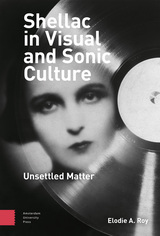 Shellac in Visual and Sonic Culture: Unsettled Matter
Elodie A. Roy
Amsterdam University Press, 2023 This book charts the unsettled media cultures and deep time of shellac, retracing its journey from the visual to the sonic, and back again. Each chapter unveils a situated moment in the long history of shellac – travelling from its early visual culture to Emile Berliner’s discovery of its auditory properties through to its recycling in contemporary art and design practices. Unforeseen correspondences between artefacts as diverse as mirrors, seals, gramophone discs and bombs are revealed. With its combinatory approach and commitment to material thinking, Shellac in Visual and Sonic Culture insists on moments of contact, encounter, and transformation. The book notably addresses the colonial unconscious underpinning the early transnational recording industry, highlighting the multiple gestures and forms of labour entombed within the production of the 78rpm disc. Roy explores shellac as a concrete substance, as well as the malleable stuff of which stories, histories and modern imaginings were made – and unmade.
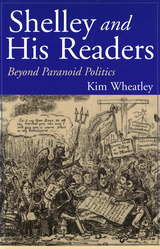 Shelley and His Readers: Beyond Paranoid Politics
Kim Wheatley
University of Missouri Press, 1999
In Shelley and His Readers, the first full-length critical analysis of the dialogue between Shelley's poetry and its contemporary reviewers, Kim Wheatley argues that Shelley's idealism can be recovered through the study of his poetry's reception. Incorporating extensive research in major early-nineteenth-century British periodicals, Wheatley integrates a reception-based methodology with careful textual analysis to demonstrate that the early reception of Shelley's work registers the immediate impact of the poet's increasingly idealistic passion for reforming the world.
Wheatley examines Shelley's poetry within the context of Romantic-era "paranoid politics," a simultaneously empowering and disabling dynamic in which the reviewers employ a heightened language of defensiveness and persecution that paints their adversaries as Satanic rebels against orthodoxy. This "paranoid style" displays a preoccupation with the efficacy of the printed word and singles out radical writers such as Shelley as sources of social contamination.
Using Shelley's Queen Mab to illustrate his early radicalism, Wheatley demonstrates that the poet, like his contemporary reviewers, is caught up in paranoid rhetoric. Failing to challenge the assumptions underlying the paranoid style-conspiracy and contagion-in this poem Shelley takes merely a defiant, oppositional stance. However, Shelley's later poems, exemplified by Prometheus Unbound and Adonais, circumvent the reviewers' rhetoric through their boldly experimental language, a process registered by the reviewers' own responses. These less explicitly political poems transcend the dynamics of cultural paranoia by shifting to an apolitical conception of the aesthetic. In collaboration with its early readers, Shelley's poetry thus moves momentarily beyond paranoid politics.
The final chapter of this study argues that the posthumous reception of Adonais uniquely replicates the elegiac moves and complex idealism of the poem, concluding with a discussion of how the Shelley circle aestheticized the poet after his death.
Shelley and His Readers offers a new approach to the question of how to recuperate Romantic idealism in the face of challenges from both deconstructive and historicist criticism. Its innovative use of reception-based analysis will make this book invaluable not only to specialists of the Romantic period but also to anyone interested in new developments in literary criticism.
Shelley and Synesthesia
Glenn O'Malley
Northwestern University Press, 1964 Glenn O’Malley’s Shelley and Synesthesia examines a little-known aspect of Percy Shelley’s poetry, offering a history of synesthesia and engaging in close readings of Shelley’s poetry, focusing primarily on his longer works. O’Malley explores the internal structure of Shelley’s poems to concentrate on patterns of imagery and symbolism, bringing attention to Shelley’s resourcefulness and responsibility in his use of synesthesia and his development of it into a powerful creative tool. The work advances the conversation on literary synesthesia and brings fresh insights to Shelley’s poems and to poetic theory in Romanticism.
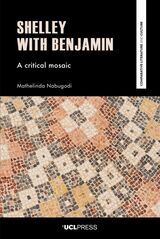 Shelley with Benjamin: A Critical Mosaic
Mathelinda Nabugodi
University College London, 2023 A comparison of the works of Percy Bysshe Shelley and Walter Benjamin that examines their similarities through citation, translation, and critical commentary.
Shelley with Benjamin is an experiment in comparative reading. Born a century apart, Percy Bysshe Shelley and Walter Benjamin are separated by time, language, temperament, and genre. One is a Romantic poet known for his revolutionary politics and delicate lyricism, and the other is a melancholy intellectual who pioneered a dialectical method of thinking in constellations. Yet, taken together, their ideas are mutually illuminating.
In a series of close readings that are by turns playful, erotic, and violent, Mathelinda Nabugodi unveils affinities between two writers whose works are simultaneously interventions in literary history and blueprints for an emancipated future. In addition to offering fresh interpretations of both major and minor writings, she elucidates the personal and ethical stakes of literary criticism. The book will appeal to readers of Shelley and Benjamin as well as those with an interest in comparative literature, literary theory, romantic poetics, and creative critical writing.
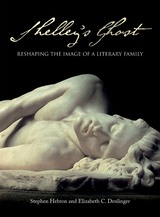 Shelley's Ghost: Reshaping the Image of a Literary Family
Stephen Hebron and Elizabeth C. Denlinger
Bodleian Library Publishing, 2010 It is difficult to think of a family more endowed with literary genius than the Shelley family—from the Romantic poet Percy Bysshe Shelley and his wife, novelist Mary Shelley, to Mary’s parents, William Godwin and Mary Wollstonecraft—all were authors in their own right. Using extensive archival material, Shelley’s Ghost explores the making of this remarkable literary family’s reputation. Drawing on the Bodleian Library’s outstanding collection of letters, poetry manuscripts, rare printed books, portraits, and other personalia—including Shelley’s working notebooks, Keats’s letters to Shelley, William Godwin’s diary, and the original manuscript of Mary Shelley’s Frankenstein—Stephen Hebron charts the history of this talented yet troubled family. After Percy Bysshe Shelley’s drowning in 1822, Mary published various manuscripts relating to both her husband’s and her father’s lives, and passed this historical legacy to her son, Sir Percy Florence Shelley and his wife, Lady Jane Shelley. As guardians of the archive until they bequeathed it to the Bodleian in 1892, Sir Percy Florence and Lady Jane helped shape the posthumous reputations of these writers. An afterword by Elizabeth Denlinger of the New York Public Library offers an additional perspective, exploring material relating to the Shelley family that slipped beyond the family’s control. An unparalleled look at one of the most significant families of British Romantic literature, Shelley’s Ghost will be welcomed by scholars and the many fans of this enduring literacy legacy.
 Shelley’s Major Verse: The Narrative and Dramatic Poetry
Stuart M. Sperry
Harvard University Press, 1988 Shelley has long been viewed as a dreamer isolated from reality, a “beautiful and ineffectual angel,” in Arnold’s words. In contrast, Stuart Sperry’s book emphasizes the life forces originating in the poet’s childhood that impelled and shaped his career, and reasserts Shelley’s relevance to the social and cultural dilemmas of contemporary life.
Concentrating on the major narrative and dramatic poems and the patterns of development they reveal, Sperry reintegrates Shelley’s poetry with his life by showing how, following the traumatic events of his early years, the poet sought to preserve and extend those life impulses by creating a network of personal relationships that provided the inspiration and model for his poems. As the circumstances of his life and his relationships to others changed and as his thought evolved, he was led to reshape his major poems. Three chapters at the center of the book, devoted to Shelley’s visionary masterpiece Prometheus Unbound, provide the finest introduction so far to its conceptions and intent as well as a powerful vindication of the poet’s enduring idealism. In defining Shelley’s true originality, Sperry defends the poet against his harshest critics by suggesting that his vision of human potential may represent a vital resource against the competitive drives and self-destructive compulsions of our own day.
Sperry’s approach to the poetry through the formative events of Shelley’s early life provides an excellent biographical introduction. His reinterpretation of the major works and the career will appeal to first-time readers as well as to mature students of Shelley.
 Shelley’s Religion
Ellsworth Barnard
University of Minnesota Press, 1936
Shelley’s Religion was first published in 1936. Minnesota Archive Editions uses digital technology to make long-unavailable books once again accessible, and are published unaltered from the original University of Minnesota Press editions.That we have power over ourselves to doAnd suffer – what, we know not till we try;But something nobler than to live and die.“The beginning of a new school of Shelleyan criticism” is to be found in this daringly original and impassioned discussion of the poet’s attitude toward God, Christianity, immortality, and related subjects. This is the most thorough treatment Shelley’s religious ideas have ever received.The author, an iconoclastic young critic of remarkable insight and intensity, attacks with spirit a number of Shelley “myths” and their proponents, living and dead. He draws extensively from Shelley’s own writings to prove that the poet was anything but an undiscriminating materialist, or a shallow and uncomprehending opponent of true religion. This is a book which Shelleyans will read with delight – some perhaps with dismay.
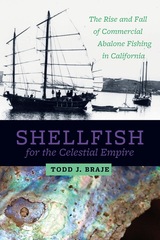 Shellfish for the Celestial Empire: The Rise and Fall of Commercial Abalone Fishing in California
Todd J. Braje
University of Utah Press, 2016 In the 1800s, when California was captivated by gold fever, a small group of Chinese immigrants recognized the fortune to be made from the untapped resources along the state’s coast, particularly from harvesting the black abalone of southern and Baja California. These immigrants, with skills from humble beginnings in a traditional Chinese fishing province, founded California’s commercial abalone industry, and led its growth and expansion for several decades. By the turn of the twentieth century, however, their successful livelihood was stolen from them through targeted legislation of the U.S. and California governments. Today, the physical evidence of historical Chinese abalone fishing on the mainland has been erased by development. On California’s Channel Islands, however, remnants of temporary abalone collecting and processing camps lie scattered along the coastlines. These sites hold a treasure trove of information, stories, lifeways, and history. Braje has excavated many of these sites and uses them to explore the history of Chinese abalone fishing, presenting a microcosm of the broader history of Chinese immigrants in America—their struggles, their successes, the institutionalized racism they faced, and the unique ways in which they helped to shape the identity of the United States.
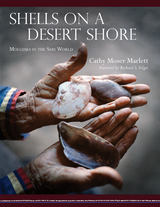 Shells on a Desert Shore: Mollusks in the Seri World
Cathy Moser Marlett; Foreword by Richard S. Felger
University of Arizona Press, 2014 In Mexico’s western Sonoran Desert along the Gulf of California is a place made extraordinary by the desert solitude, the dynamic sea, and the people who live there—the Seris. Central to the lives of these people are the sea and its shores.
Shells on a Desert Shore describes the Seri knowledge of mollusks and includes names, folklore, history, uses, and much more. Cathy Moser Marlett’s research of several decades, conducted in the Seri language, builds on work begun in 1951 by her parents, Edward and Becky Moser. The language, spoken by fewer than a thousand people today, is considered endangered. Marlett presents what she has learned from Seri consultants over recent decades and also draws from her own childhood experiences while living in a Seri village. The information from the people who had lived as hunter-gatherers provides a window into a lifestyle no longer recalled from personal experience by most Seris today—and perhaps a window into the lives of other peoples who made the Gulf’s shores their home.
The book offers a wealth of information about Seri history, as well as species accounts of more than 150 mollusks from the Seri area on the central Gulf coast. Chapters describe how the people ate mollusks or used them medicinally, how the mollusks were named, and how their shells were used. The author provides several hundred detailed drawings and photographs, many of them archival.
Shells on a Desert Shore is a fresh, original presentation of a significant part of the Seri way of life. Unique because it is written from the perspective of a participant in the Seri culture, the book will stand as a definitive, irreplaceable work in ethnography, a time capsule of the Seri people and their connection to the sea.
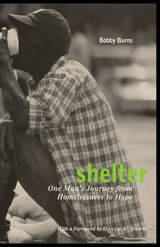 Shelter
Bobby Burns
University of Arizona Press, 1998 Bobby Burns arrived in Tucson, Arizona, with a few dollars in his pocket and no place to live. Without family, without a job, he had nowhere to go but a homeless shelter. How did a college graduate find himself so close to life on the streets? In a voice that is startling for its simplicity and utter honesty, Burns tells the story of how he slipped into homelessness, how he learned what it means to live in a place where nobody will notice if you disappear, and how he emerged to tell his story. Bobby's diary of 41 days without a home brings readers into the world of a homeless shelter.
Shelter is filled with the sights and sounds of homelessness. Shelter life is patterned by meals provided by church volunteers, lines for soap and clean towels, the repeated meticulous washing of hands by an obsessive-compulsive resident, the rare pleasure of a fried chicken dinner, the illicit smell of marijuana within the shelter. Burns witnesses the residents' struggles with drugs, alcohol, and disability, and he wonders daily whether he will have the courage to emerge from this life. Bobby's diary expresses the full range of emotions of a homeless person: anger, self-pity, pride, humility, shame, depression, and optimism. These are not contradictions; taken together they represent the real feelings provoked by homelessness.
But with rare inner courage, Bobby stokes the fires of hope within himself, marking the days in his journal to keep himself from sliding deeper into a spiral of despair. Bobby confronts his own stereotypes about the homeless and learns firsthand what it means to struggle daily for survival and for dignity. He learns greater courage and he learns greater kindness. He is given food and a bed for 41 days, but he finds shelter on his own, deep within himself.
 Shelter and Storm: At Home in the Driftless
dean
University of Minnesota Press, 2025 Living mindfully with nature during a time of uncertainty In the midst of the environmental crises of the early twenty-first century, Tamara Dean sought a way to live lightly on the planet. Her quest drew her to a landscape unlike any other: the Driftless area of Wisconsin, a region untouched by glaciers, marked by steep hills and deeply carved valleys, capped with forests and laced with cold, spring-fed streams. There, she confronted, in ways large and small, the challenges of meeting basic needs while facing the ravages of climate change—an experience at once soul-stirring and practical that she recounts in Shelter and Storm. Dean’s boundless curiosity and gift for storytelling imbue these essays with urgency and a sense of adventure. She invites readers to share in her discoveries while hunting for water, learning that a persistent weed could be food, or burning a hayfield to recreate a prairie. Contending with the fallout of fires, floods, and tornadoes, she offers responses to natural disasters that reflect the importance of community, now and for generations to come. Whether tracking down a rare, blue-glowing firefly, engineering a beaver-friendly waterway to appease a dying neighbor, or building a house of earthen blocks, Dean unites personal experience with science and history, presenting a perspective as informative as it is compelling. Keenly attentive to the stakes for our planet’s future—and the implications of extreme weather, shifting agricultural practices, and political divides—Shelter and Storm illuminates a thoughtful way forward for anyone concerned about climate change and its far-reaching consequences or for anyone searching, as Dean has, for a more sustainable way to live. Retail e-book files for this title are screen-reader friendly.
 Shelter for the Night: On Afghanistan, Language, and Detours
Fatima Mojaddedi
Duke University Press, 2026 Shelter for the Night is an ethnographic meditation on language and psychic life in 2010s Afghanistan, where militarized violence has collapsed social worlds. Across Kabul and the countryside, in poetic and probing style, the book unpacks the precarious relationship between language, violence, and the self. As social and political worlds fracture through militarized violence, economic speculation, interpersonal sabotage, and ruptures in shared understanding, people are set on unexpected detours to discontinuity. Encounters in political life, love, and translation become fragmented, difficult to parse, and entangled in symbolic violence. Yet amid the harsh realities of contemporary life in Kabul, Mojaddedi finds moments of wonder and rich inner lives of reflexivity, understanding, and social connection. From narratives of modernist ambition and political violence to tragic romance and urbanite translators and their rural interlocutors, Shelter for the Night looks at the challenges of articulating the unspeakable to make a bold claim for the importance of thinking about the contemporary world starting from Afghanistan.
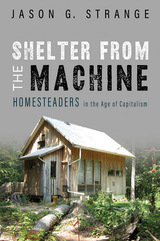 Shelter from the Machine: Homesteaders in the Age of Capitalism
Jason G. Strange
University of Illinois Press, 2020 ”You’re either buried with your crystals or your shotgun.” That laconic comment captures the hippies-versus-hicks conflict that divides, and in some ways defines, modern-day homesteaders. It also reveals that back to-the-landers, though they may seek lives off the grid, remain connected to the most pressing questions confronting the United States today.
Jason Strange shows where homesteaders fit, and don't fit, within contemporary America. Blending history with personal stories, Strange visits pig roasts and bohemian work parties to find people engaged in a lifestyle that offers challenge and fulfillment for those in search of virtues like self-employment, frugality, contact with nature, and escape from the mainstream. He also lays bare the vast differences in education and opportunity that leave some homesteaders dispossessed while charting the tensions that arise when people seek refuge from the ills of modern society—only to find themselves indelibly marked by the system they dreamed of escaping.
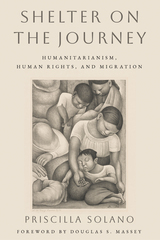 Shelter on the Journey: Humanitarianism, Human Rights, and Migration
Priscilla Solano
Temple University Press, 2024 Migration journeys are arduous, with migrants tormented by risk, abuse, threats, and xenophobia. Shelters, staffed by humanitarian workers and volunteers, provide safe spaces for those in transit. Shelter on the Journey examines how these sites, often faith-based civil society associations, create solidarity and help politicize migrants, giving them a sense of themselves as an empowered, rights-holding people.
Solano, who volunteered at shelters in Mexico, chronicles the activity in three of the nearly 100 shelters along a unique humanitarian trail that many Central Americans take to reach the United States. She outlines the constraints faced by these sites and their potential to create social transformation and considers how and why migration security is currently framed and managed as both a criminal and humanitarian issue.
Shelter on the Journey explores the politics of the shelters, their social world, and the dynamics of charity and solidarity, as well as the need for humanitarian assistance and advocacy for dignified and free transit migration.
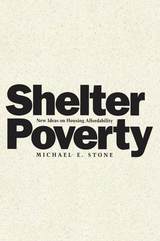 Shelter Poverty: New Ideas on Housing Affordability
Michael E. Stone
Temple University Press, 1993 "...the most original--and profoundly disturbing--work on the critical issue of housing affordability...."
--Chester Hartman, President, Poverty and Race Research Action Council
In Shelter Poverty, Michael E. Stone presents the definitive discussion of housing and social justice in the United States. Challenging the conventional definition of housing affordability, Stone offers original and powerful insights about the nature, causes, and consequences of the affordability problem and presents creative and detailed proposals for solving a problem that afflicts one-third of this nation. Setting the housing crisis into broad political, economic, and historical contexts, Stone asks: What is shelter poverty? Why does it exist and persist? and How can it be overcome?
Describing shelter poverty as the denial of a universal human need, Stone offers a quantitative scale by which to measure it and reflects on the social and economic implications of housing affordability in this country. He argues for "the right to housing" and presents a program for transforming a large proportion of the housing in this country from an expensive commodity into an affordable social entitlement. Employing new concepts of housing ownership, tenure, and finance, he favors social ownership in which market concepts have a useful but subordinate role in the identification of housing preferences and allocation. Stone concludes that political action around shelter poverty will further the goal of achieving a truly just and democratic society that is also equitably and responsibly productive and prosperous.
The Sheltered Quarter: A Tale of a Boyhood in Mecca
By Hamza Bogary
University of Texas Press, 1991 Hamza Bogary describes a bygone way of life that has now irreversibly disappeared. He speaks of life in Mecca before the advent of oil. Only partly autobiographical, the memoir is nevertheless rich in remembered detail based on Bogary's early observations of life in Mecca. He has transformed his knowledge into art through his sense of humor, empathy, and remarkable understanding of human nature. This work not only entertains; it also informs its readers about the Arabia of the first half of the twentieth century in a graphic and fascinating way. The narrator, young Muhaisin, deals with various aspects of Arabian culture, including education, pilgrimages, styles of clothing, slavery, public executions, the status of women, and religion. Muhaisin is frank in his language and vivid in his humor. The reader quickly comes to love the charming and mischievous boy in this universal tale.
 Shem Pete's Alaska: The Territory of the Upper Cook Inlet Dena'ina
James Kari and James A. Fall
University of Alaska Press, 2003 Shem Pete (1896-1989), the colorful and brilliant raconteur from Susitna Station, Alaska, left a rich legacy of knowledge about the Upper Cook Inlet Dena'ina world. Pete was one of the most versatile storytellers and historians in twentieth-century Alaska, and his lifetime travel map of approximately 13,500 square miles is one of the largest ever documented in this degree of detail anywhere in the world.
This expanded edition of Shem Pete's Alaska presents 973 named places in 16 drainage-based chapters. The names form a reconstructed network from the vantage points of the life experiences of Shem Pete and other Dena'ina and Ahtna speakers. It is annotated with comments and stories by Shem Pete and more than 50 other contributors, plus historic references, vignettes, copious photographs, historic maps, and shaded-relief placename maps. The authors provide perspective on Dena'ina language and culture, as well as a summary of Dena'ina geographic knowledge and placename research methodology.
This beautifully produced edition is a treasure for all Alaskans and for anyone interested in the "personal connectedness to a beautiful land" voiced by Dena'ina elders.
From the foreword by William Bright: "Shem Pete's experience and wisdom as an elder of the Dena'ina Athabascan Indians shine through this work like the sun—as do the skill and devotion of James Kari, James Fall, and the other Dena'ina, Ahtna, Alaska Native, and Anglo-American people who contributed to making the book a reality. . . . We have a volume that offers a vivid picture of Native Alaskan culture, history, geography, and language, with added glimpses of oral literature and music. . . . All Native American Peoples, indeed, all traditional communities in the world would be fortunate and proud to have this kind of record of their life and culture."
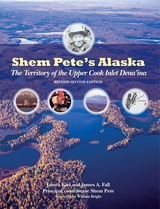 Shem Pete's Alaska: The Territory of the Upper Cook Inlet Dena'ina
James Kari and James A. Fall
University of Alaska Press, 2016 Shem Pete (1896–1989), a colorful and brilliant raconteur from Susitna Station, Alaska, left a rich legacy of knowledge about the Upper Cook Inlet Dena’ina world. Shem was one of the most versatile storytellers and historians in twentieth century Alaska, and his lifetime travel map of approximately 13,500 square miles is one of the largest ever documented with this degree of detail anywhere in the world.
The first two editions of Shem Pete’s Alaska contributed much to Dena’ina cultural identity and public appreciation of the Dena’ina place names network in Upper Cook Inlet. This new edition adds nearly thirty new place names to its already extensive source material from Shem Pete and more than fifty other contributors, along with many revisions and new annotations. The authors provide synopses of Dena’ina language and culture and summaries of Dena’ina geographic knowledge, and they also discuss their methodology for place name research.
Exhaustively refined over more than three decades, Shem Pete’s Alaska will remain the essential reference work on the landscape of the Dena’ina people of Upper Cook Inlet. As a book of ethnogeography, Native language materials, and linguistic scholarship, the extent of its range and influence is unlikely to be surpassed.
 Shen Gua’s Empiricism
Ya Zuo
Harvard University Press, 2018 Shen Gua (1031−1095) is a household name in China, known as a distinguished renaissance man and the author of Brush Talks from Dream Brook, an old text whose remarkable “scientific” discoveries make it appear curiously ahead of its time. In this first book-length study of Shen in English, Ya Zuo reveals the connection between Shen’s life as an active statesman and his ideas, specifically the empirical stance manifested through his wide-ranging inquiries. She places Shen on the broad horizon of premodern Chinese thought, and presents his empiricism within an extensive narrative of Chinese epistemology.
Relying on Shen as a searchlight, Zuo focuses in on how an individual thinker summoned conditions and concepts from the vast Chinese intellectual tradition to build a singular way of knowing. Moreover, her study of Shen provides insights into the complex dynamics in play at the dawn of the age of Neo-Confucianism and compels readers to achieve a deeper appreciation of the diversity in Chinese thinking.
The Shenandoah
Julia Davis
West Virginia University Press, 2011 In 1945, West Virginia author Julia Davis penned The Shenandoah as part of the Rivers of America Series, a landmark collection of books written by literary figures over a period of thirty years. In this classic reprint, now with an introduction by Christopher Camuto, Davis tells the history of the Shenandoah Valley and River, drawing on her own research and the experiences of ancestors who settled and lived in the area. Her book provides a poetic vision of both the river and the valley, preserving a fragment of America’s landscape.
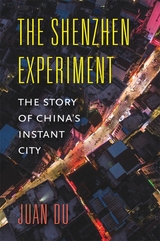 The Shenzhen Experiment: The Story of China’s Instant City
Juan Du
Harvard University Press, 2019 An award-winning Hong Kong–based architect with decades of experience designing buildings and planning cities in the People’s Republic of China takes us to the Pearl River delta and into the heart of China’s iconic Special Economic Zone, Shenzhen.
Shenzhen is ground zero for the economic transformation China has seen in recent decades. In 1979, driven by China’s widespread poverty, Deng Xiaoping supported a bold proposal to experiment with economic policies in a rural borderland next to Hong Kong. The site was designated as the City of Shenzhen and soon after became China’s first Special Economic Zone (SEZ). Four decades later, Shenzhen is a megacity of twenty million, an internationally recognized digital technology hub, and the world’s most successful economic zone. Some see it as a modern miracle city that seemingly came from nowhere, attributing its success solely to centralized planning and Shenzhen’s proximity to Hong Kong. The Chinese government has built hundreds of new towns using the Shenzhen model, yet none has come close to replicating the city’s level of economic success.
But is it true that Shenzhen has no meaningful history? That the city was planned on a tabula rasa? That the region’s rural past has had no significant impact on the urban present? Juan Du unravels the myth of Shenzhen and shows us how this world-famous “instant city” has a surprising history—filled with oyster fishermen, villages that remain encased within city blocks, a secret informal housing system—and how it has been catapulted to success as much by the ingenuity of its original farmers as by Beijing’s policy makers. The Shenzhen Experiment is an important story for all rapidly urbanizing and industrializing nations around the world seeking to replicate China’s economic success in the twenty-first century.
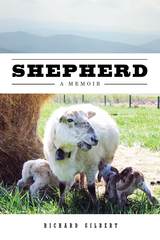 Shepherd: A Memoir
Richard Gilbert
Michigan State University Press, 2014 Upon moving to Appalachian Ohio with their two small children, Richard Gilbert and his wife are thrilled to learn there still are places in America that haven’t been homogenized. But their excitement over the region’s beauty and quirky character turns to culture shock as they try to put down roots far from their busy professional jobs in town. They struggle to rebuild a farmhouse, and Gilbert gets conned buying equipment and sheep—a ewe with an “outie” belly button turns out to be a neutered male, and mysterious illnesses plague the flock. Haunted by his father’s loss of his boyhood farm, Gilbert likewise struggles to earn money in agriculture. Finally an unlikely teacher shows him how to raise hardy sheep—a remarkable ewe named Freckles whose mothering ability epitomizes her species’ hidden beauty. Discovering as much about himself as he does these gentle animals, Gilbert becomes a seasoned agrarian and a respected livestock breeder. He makes peace with his romantic dream, his father, and himself. Shepherd, a story both personal and emblematic, captures the mythic pull and the practical difficulty of family scale sustainable farming.
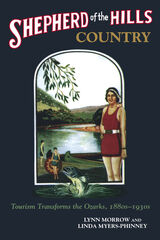 Shepherd of the Hills Country: Tourism Transforms the Ozarks, 1880s-1930s
Lynn Morrow
University of Arkansas Press, 1999 Modern tourism in the Ozark Mountains of Missouri and Arkansas is concentrated around the area’s glistening man-made lakes, its fish-filled streams and rivers, and the entertainment mecca of Branson. But recreational excursions into this part of the country began over one hundred years ago as urban Midwesterners, many of them captivated by Harold Bell Wright’s novel The Shepherd of the Hills, sought the outdoors for spiritual and physical regeneration. Morrow and Myers-Phinney excavate the beginnings of commercial tourism in the region and follow it through six decades as the influx of visitors who became familiar with the Ozarks and its investment opportunities brought capital, new commerce, and additional residents to the hills. Chapters focus on float fishing, game parks, cave exploration, the influence of the railroad, and the men who were instrumental in the region’s transformation. The authors discuss traditional lifestyles rooted in “living off the land,” with stock raising and lumbering providing basic subsistence, and changes wrought by tourism, which affected all classes of people across the White River landscape. They describe the flowering of “Ozarks folklore”—how stories told around gravel-bar fishing camps and retold by newspaper journalists translated the hills’ oral tradition for mass audiences. While the main theme of this study is the development of tourism, it is also a social history of the interior highlands of the Ozarks. We see how the residents and their way of life were discovered, exploited, and changed by new opportunities and the demands of tourism and increasing trade. As such, this book is a valuable new addition to the University of Arkansas Press’s Ozarks Collection.
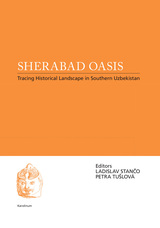 Sherabad Oasis: Tracing Historical Landscape in Southern Uzbekistan
Edited by Ladislav Stanco and Petra Tušlová
Karolinum Press, 2020 Sherabad Oasis: Tracing Historical Landscape in Southern Uzbekistan is the second volume of the series examining the Czech-Uzbek archaeological expedition in southern Uzbekistan. While the first book was devoted to the excavations at the central site of the Sherabad Oasis called Jandavlattepa, this volume analyzes the development of the settlement throughout this oasis based on important new data gained in the recent expedition. The methodology used includes extensive and intensive archaeological surveys, revisions of previously published archaeological data, historical maps, and innovative satellite images. Apart from the dynamics of the settlement of the research area, spanning from prehistoric to modern time, the development of the irrigation systems in the lowland steppe is also assessed.
Edited by Ladislav Stančo and Petra Tušlová, this volume continues the significant work of Czech researchers in Uzbekistan, a key Central Asian republic at the crossroads of history and culture.
 Sheridan to Robertson: A Study of the Nineteenth-Century London Stage
Ernest Bradlee Watson
Harvard University Press We have accurate knowledge of English drama—remarks George Pierce Baker in his Introduction to this volume—in the seventeenth and eighteenth centuries and also at the other extreme, since 1870; but the few attempts at histories of the stage or of the drama from 1800 to 1870 (the period covered by Dr. Watson’s book) have not shown any broad treatment of the subject nor have they been carefully documented. Dr. Watson, on the other hand, has not only presented a vivid picture of these years in our dramatic history but he has been able to revise many current ideas as to the drama of the time. “More than any other book I know,” continues Professor Baker, “this of Dr. Watson’s treats plays and their production in their right relationship—as inseparable. He does not merely gather facts as to the mechanics of the stage of 1800 to 1870, its actors, managers, scenery, and lighting; he explains the development of the drama itself through these.” The value of the work both for students and for the general reader is considerably enhanced by the inclusion of many reproductions of rare items in the famous Shaw Theatre Collection at Harvard.
Sherlock Holmes and the Eisendorf Enigma
Larry Millett
University of Minnesota Press, 2019 Dogged by depression, doubt, and—as a trip to the Mayo Clinic has revealed—emphysema, 66-year-old Sherlock Holmes is preparing to return to England when he receives a shock: a note slipped under his hotel room door, from a vicious murderer
Sherlock Holmes and the Ice Palace Murders
Larry Millett
University of Minnesota Press, 2010 The year is 1896, and St. Paul’s magnificent Winter Carnival is under way when Holmes and Watson are summoned by the city’s most powerful man, railroad magnate James J. Hill. A wealthy young man disappears on the eve of his wedding—and his fiancée suspiciously discards her wedding dress. After a grisly discovery in the carnival’s Ice Palace leads to a flurry of clues, Holmes is on the case. His pursuit of the murderer takes him through the highest echelons of St. Paul society and into cahoots with Shadwell Rafferty, a gregarious saloonkeeper and part-time private investigator. Soon Holmes, Watson, and Rafferty are embroiled in a perilous adventure that takes them from one frozen corner of the city to another and out onto the treacherous ice of the Mississippi River as they trail a cruel and ruthless killer.
Sherlock Holmes and the Red Demon
Larry Millett
University of Minnesota Press, 2010 In the summer of 1994, a workman at the historic mansion of railroad baron James J. Hill in St. Paul, Minnesota, stumbles on a long-hidden wall safe. When experts arrive to open the safe and examine its contents, they make an astonishing discovery. There, inside, is a handwritten manuscript bearing the signature of John H. Watson, M.D.
The manuscript contains the story of how Sherlock Holmes and Watson traveled to Minnesota to track a murderous arsonist—known only as the Red Demon—who is threatening both Hill and his Great Northern Railway. Set against the backdrop of the real, devastating Hinckley forest fire of 1894, Sherlock Holmes and the Red Demon is the tense and atmospheric first novel in Larry Millett’s classic series of adventures that brought Sherlock Holmes and Dr. Watson to Minnesota.
Sherlock Holmes and the Rune Stone Mystery
Larry Millett
University of Minnesota Press, 2012 Sherlock Holmes is bored between cases at 221B Baker Street. So when King Oskar II of Sweden—who has heard of the discovery of the Kensington Rune Stone by a farmer in Minnesota—asks to engage his services, Holmes jumps at the chance to decipher the runes and determine whether the find is real or a hoax. With Dr. John H. Watson by his side, faithfully recording every detail, Holmes makes his way to Minnesota for a third time. But, in the first of many strange and unfortunate coincidences, the farmer who found the mysterious stone is murdered, and the stone itself is stolen on the day the famous detective arrives. With the help of one Shadwell Rafferty, now a friend and partner, Holmes must solve this baffling case to find both the stone and the murderer.
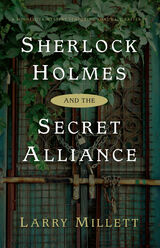 Sherlock Holmes and the Secret Alliance
Larry Millett
University of Minnesota Press, 2012 As the city of Minneapolis prepares for a visit from President William McKinley, someone else prepares for murder. On the day before the visit, a union activist is found hanged, naked, outside a ruined mansion. A placard around his neck reads “THE SECRET ALLIANCE HAS SPOKEN.” Who is the alliance? What does it want? How was the victim involved with the city’s corrupt mayor? And why did he possess a photograph of a prominent citizen in a compromising position? Shadwell Rafferty searches for answers, encountering bribery, corruption, union organizers, anarchists, and conspiracy, putting himself in danger. But as luck would have it, his old friends Sherlock Holmes and Dr. John H. Watson are on their way. In this fourth installment of Larry Millett’s Minnesota Mystery series, Shadwell Rafferty commands center stage in a brand-new city. Packed with Millett’s signature historical and architectural detail, this book is deviously delightful.
Sherlock Holmes, Esq., and John H. Watson, M.D.: An Encyclopaedia of Their Affairs
Orlando Park
Northwestern University Press, 1962 This encyclopedia serves as a guide to the fifty-six stories and four novels that comprise the Sherlock Holmes canon. Arranged alphabetically, Orlando Park provides entries on all manner of people, places, and objects from Arthur Conan Doyle’s novels and stories, as well as thorough treatments of the traits and opinions of Holmes and Watson. Throughout Park intends not only to answer questions but to stimulate curiosity, making the book an engaging guide for both the Sherlock Holmes aficionado and the reader new to Holmes's world.
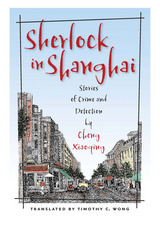 Sherlock in Shanghai: Stories of Crime and Detection by Cheng Xiaoping
Cheng Xiaoqing and translated by Timothy C. Wong
University of Hawaii Press, 2007 Shanghai in the 1920s and 1930s—"the Paris of the Orient"—was both a glittering metropolis and a shadowy world of crime and social injustice. It was also home to Huo Sang and Bao Lang, fictional Chinese counterparts to Arthur Conan Doyle’s Sherlock Holmes and Dr. Watson. The duo lived in a spacious apartment on Aiwen Road, where Huo Sang played the violin (badly) and smoked Golden Dragon cigarettes as he mulled over his cases. Cheng Xiaoqing (1893–1976), "The Grand Master" of twentieth-century Chinese detective fiction, had first encountered Conan Doyle’s highly popular stories as an adolescent. In the ensuing years he played a major role in rendering them first into classical and later into vernacular Chinese. In the late 1910s, Cheng began writing detective fiction very much in Conan Doyle’s style, with Bao as the Watson-like-I narrator—a still rare instance of so direct an appropriation from foreign fiction.
Cheng Xiaoqing wrote detective stories to introduce the advantages of critical thinking to his readers, to encourage them to be skeptical and think deeply, because truth often lies beneath surface appearances. His attraction to the detective fiction genre can be traced to its reconciliation of the traditional and the modern. In "The Shoe," Huo Sang solves the case with careful reasoning, while "The Other Photograph" and "On the Huangpu" blend this reasoning with a sensationalism reminiscent of traditional Chinese fiction. "The Odd Tenant" and "The Examination Paper" also demonstrate the folly of first impressions. "At the Ball" and "Cat’s-Eye" feature the South-China Swallow, a master thief who, like other outlaws in traditional tales, steals only from the rich and powerful. "One Summer Night" clearly shows Cheng’s strategy of captivating his Chinese readers with recognizably native elements even as he espouses more globalized views of truth and justice.
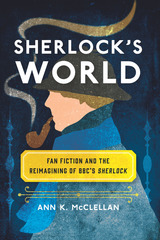 Sherlock's World: Fan Fiction and the Reimagining of BBC's Sherlock
Ann K. McClellan
University of Iowa Press, 2018 Sherlock Holmes remains more popular than ever some 130 years after the detective first appeared in print. These days, the iconic character’s staying power is due in large part to the success of the recent BBC series Sherlock, which brings the famous sleuth into the twenty-first century. One of the most-watched television series in BBC history, Sherlock is set in contemporary London, where thirtysomething Sherlock and John (no longer fussy old Holmes and Watson), alongside New Scotland Yard, solve crimes with the help of smartphones, texting, online forums, and the internet. In their modernization of Sir Arthur Conan Doyle’s nineteenth-century world, Sherlock creators Stephen Moffatt and Mark Gatiss make London as much a character of their show as the actors themselves. The highly stylized series has inspired an impassioned fan community in Britain, the U.S., and beyond. Fans create and share their writings, which reimagine the characters in even more dramatic ways than the series can. Interweaving fan fiction studies, world-building, and genre studies, Ann McClellan examines the hit series and the fan fiction it inspires. Using Sherlock to trace the changing face of fan fiction studies, McClellan’s book explores how far fans are willing to go to change the Sherlockian canon while still reinforcing its power and status as the source text. What makes Sherlock fanfic Sherlockian? How does it stay within the canon even while engaging in the wildest reimaginings? Sherlock’s World explores the boundaries between canon, genre, character, and reality through the lenses of fan fiction and world-building. This book promises to be a valuable resource for fan studies scholars, those who write fan fiction, and Sherlock fans alike.
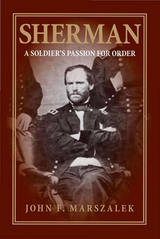 Sherman: A Soldier's Passion for Order
John F. Marszalek
Southern Illinois University Press, 1993 Sherman: A Soldier’s Passion for Order is the premier biography of William Tecumseh Sherman, the Civil War commander known for his “destructive war” policy against Confederates and as a consummate soldier. This updated edition of John F. Marszalek’s award-winning book presents the general as a complicated man who, fearing anarchy, searched for the order that he hoped would make his life a success. Sherman was profoundly influenced by the death of his father and his subsequent relationship with the powerful Whig politician Thomas Ewing and his family. Although the Ewings treated Sherman as one of their own, the young Sherman was determined to make it on his own. He graduated from West Point and moved on to service at military posts throughout the South. This volume traces Sherman’s involvement in the Mexican War in the late 1840s, his years battling prospectors and deserting soldiers in gold-rush California, and his 1850 marriage to his foster sister, Ellen. Later he moved to Louisiana, and, after the state seceded, Sherman returned to the North to fight for the Union. Sherman covers the general’s early Civil War assignments in Kentucky and Missouri and his battles against former Southern friends there, the battle at Shiloh, and his rise to become second only to Grant among the Union leadership. Sherman’s famed use of destructive war, controversial then and now, is examined in detail. The destruction of property, he believed, would convince the Confederates that surrender was their best option, and Sherman’s successful strategy became the stuff of legend. This definitive biography, which includes forty-six illustrations, effectively refutes misconceptions surrounding the controversial Union general and presents Sherman the man, not the myth.
Sherman Alexie: A Collection of Critical Essays
Jeff Berglund
University of Utah Press, 2010 Sherman Alexie is, by many accounts, the most widely read American Indian writer in the United States and likely in the world. A literary polymath, Alexie's nineteen published books span a variety of genres and include his most recent National Book Award-winning The Absolutely True Diary of a Part-Time Indian. Now, for the first time, a volume of critical essays is devoted to Alexie's work both in print and on the big screen. Editors Jeff Berglund and Jan Roush have assembled twelve leading scholars of American Indian literature to provide new perspectives on a writer with his finger on the pulse of America. Interdisciplinary in their approach to Alexie's work, these essays cover the writer's entire career, and are insightful and accessible to scholars and lay readers alike. This volume is a worthy companion to the work of one of our nations's most recognized contemporary voices.
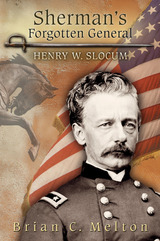 Sherman's Forgotten General: Henry W. Slocum
Brian C. Melton
University of Missouri Press, 2007 Henry Warner Slocum, a Union major general who was a corps and army commander in the Civil War, served from the first call for troops until he stood with William Tecumseh Sherman to receive Joseph E. Johnston’s surrender after Appomattox. He saw action at Bull Run, Chancellorsville, and Gettysburg, and by the end of the war he had taken command of the Army of Georgia, yet historians have largely overlooked this key commander. Brian Melton has written the first scholarly account of this important general—the first full-length biography in nearly a century—who as one of Sherman’s most trusted commanders exercised significant influence during the Civil War. Although Slocum is remembered primarily for his lackluster performance at Gettysburg, Melton discloses that there is more to him than current history credits, offering a holistic account of his life to show that his career was much more significant than has been supposed. Slocum took on the characteristics of the leaders he served, and Melton reveals how Slocum’s attitudes and tactics changed dramatically between commanders to explain why he proved to be of little help to George McClellan and almost a liability while serving under “Fighting Joe” Hooker and yet was an effective commander under Sherman. Slocum became Sherman’s “left arm” and adapted so thoroughly to his style of generalship that he anticipated the general’s intentions on two important occasions, and Melton contends that Slocum was a much more important contributor to the success of Sherman’s later campaigns than has been acknowledged, becoming at times more aggressive and driving than Sherman himself. Melton ultimately considers Slocum’s fate as one of the forgotten generals of the Civil War—brought on largely by his joining the Democratic Party in 1865—and demonstrates why previous simplistic depictions of Slocum miss the mark. By providing the first detailed look at this important second-tier commander, Sherman’s Forgotten General illuminates the influences, events, and individuals of Slocum’s career to show that, while he may not have changed the course of the war, he played a conspicuous and important role in its successful execution that has long deserved to be recognized.
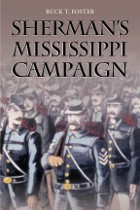 Sherman's Mississippi Campaign
Buck T. Foster
University of Alabama Press, 2006 The rehearsal for the March to the Sea With the fall of Vicksburg to Union forces in mid-1863, the Federals began work to extend and consolidate their hold on the lower Mississippi Valley. As a part of this plan, Major General William Tecumseh Sherman set out from Vicksburg on February 3, 1864, with an army of some 25,000 infantry and a battalion of cavalry. They expected to be joined by another Union force moving south from Memphis and supported themselves off the land as they traveled due east across Mississippi. Sherman entered Meridian on February 14 and thoroughly destroyed its railroad facilities, munitions plants, and cotton stores, before returning to Vicksburg. Though not a particularly effective campaign in terms of enemy soldiers captured or killed, it offers a rich opportunity to observe how this large-scale raid presaged Sherman’s Atlanta and Carolina campaigns, revealing the transformation of Sherman’s strategic thinking.
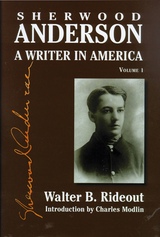 Sherwood Anderson: A Writer in America, Volume 1
Walter B. Rideout
University of Wisconsin Press, 2006 Sherwood Anderson: A Writer in America is the definitive biography of this major American writer of novels and short stories, whose work includes the modern classic Winesburg, Ohio. In the first volume of this monumental two-volume work, Walter Rideout chronicles the life of Anderson from his birth and his early business career through his beginnings as a writer and finally to his move in the mid-1920s to “Ripshin,” his house near Marion, Virginia. The second volume will cover Anderson’s return to business pursuits, his extensive travels in the South touring factories, which resulted in his political involvement in labor struggles and several books on the topic, and finally his unexpected death in 1941. No other existing Anderson biography, the most recent of which was published nearly twenty years ago, is as thoroughly researched, so extensively based on primary sources and interviews with a range of Anderson friends and family members, or as complete in its vision of the man and the writer. The result is an unparalleled biography—one that locates the private man, while astutely placing his life and writings in a broader social and political context. Outstanding Academic Title, Choice Magazine Winner, Biography Award, Society of Midland Authors
 Sherwood Anderson: A Writer in America, Volume 2
Walter B. Rideout
University of Wisconsin Press, 2006 Sherwood Anderson, an important American novelist and short-story writer of the early twentieth century, is probably best known for his novel Winesburg, Ohio. His realistic and nonformulaic writing style would influence the next generation of authors, most notably Ernest Hemingway and William Faulkner.
Walter Rideout’s Sherwood Anderson: A Writer in America is a seminal work that reintroduces us to this important, yet recently neglected, American writer, giving him long overdue attention. This second volume of the monumental two-volume work covers Anderson’s life after his move in the mid-1920s to “Ripshin,” his house near Marion, Virginia (where Volume 1 ended.) The second volume covers his return to business pursuits; his extensive travels in the South touring factories, which resulted in his political involvement in labor struggles and several books on the topic; and finally his unexpected death in 1941.
No other existing Anderson biography, the most recent of which was published nearly twenty years ago, is as thoroughly researched, so extensively based on primary sources and interviews with a range of Anderson’s friends and family members, or as complete in its vision of the man and the writer. Rideout uncovers much new information about events and people in Anderson’s life and provides a new perspective on many of his works. This two-volume biography presents Anderson’s many remarkable attributes more clearly than ever before, while astutely placing his life and writings in the broader social, political, and artistic movements of his times.
Outstanding Book, selected by the American Association of School Librarians, and Best Books for General Audiences, selected by the Public Library Association
Outstanding Academic Title, Choice Magazine
Winner, Biography Award, Society of Midland Authors
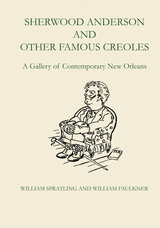 Sherwood Anderson and Other Famous Creoles: A Gallery of Contemporary New Orleans
Drawings by William Spratling
Text by William Faulkner
University of Texas Press, 1966 "When Bill Faulkner came to New Orleans he was a skinny little guy, three years older than I, and was not taken very seriously except by a few of us." Thus the late William Spratling, popularly known as the Taxco "Silver King," recalled the mid-1920's, when Faulkner, a young man fresh from Oxford, Mississippi, roomed with Spratling in Pirates Alley. "By the time I would be up, say at seven, Bill would already be out on the little balcony over the garden tapping away on his portable, an invariable glass of alcohol-and-water at hand." A result of their friendship was a book depicting "various people who were then engaged … with the arts in New Orleans." It was based on firsthand observation. "There were casual parties with wonderful conversation and with plenty of grand, or later to be grand, people." Some of the names, in addition to Sherwood Anderson, were Horace Liveright, Carl Van Doren, Carl Sandberg, John Dos Passos, Anita Loos, and Oliver La Farge. Spratling supplied sharp caricatures of the people and Faulkner contributed succinct captions and a Foreword. It was all "sort of a private joke," but the four hundred copies were sold within a week and the original edition is now a collector's item. This book is a charming reminder of exciting days and talented people.
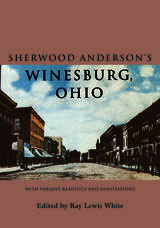 Sherwood Anderson’s Winesburg, Ohio: With Variant Readings and Annotations
Sherwood Anderson
Ohio University Press, 2000 In 1919 a middle-aged Chicago advertising writer from Ohio, a failure as a businessman, husband, and father, published a small yellow book of short stories intended to “reform” American literature. Against all expectations, Winesburg, Ohio: A Group of Tales of Ohio Small Town Life achieved what its author intended: after 1919 and after Winesburg, Ohio, American literature would be written and read freshly and differently. Winesburg, Ohio has never been out of print, but never has Anderson’s book been published in the form and with the editorial care that the work has needed and deserved. The present text, authorized by the Sherwood Anderson Literary Estate Trust, is an expert text. The editor has relied on years of experience in editing Sherwood Anderson and has consulted all Anderson manuscripts, typescripts, letters, and diaries and all editions of the book to present the masterpiece in its intended state. New to this expert edition of Winesburg, Ohio are historical and cultural annotations, documentation of changes in the various editions, identification of the Ohio originals for Anderson’s characters, and maps bearing the streets and buildings of the real town of Clyde, Ohio, which is the basis of Anderson’s fictional account. Included as well are unique photographs of Anderson and Clyde, Ohio, illustrations that deepen knowledge and feeling for the author’s actual hometown and time, revealing Winesburg, Ohio to be an intensely local narrative—very much an “Ohio” book—and yet a book that has found and held worldwide attention.
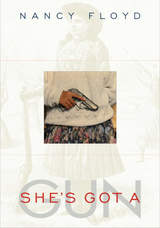 She's Got a Gun
Nancy Floyd
Temple University Press, 2008 In 1991 Nancy Floyd bought her first handgun. Soon she was participating in Ladies Day at her local shooting range and reading Women & Guns magazine. In 1993 she began interviewing and photographing women who were fellow gun owners. In 1997 she started researching "gun women" from the past to see how they were represented in the popular imagination. Now she has brought her work together in a riveting new book, filled with remarkable photographs and candid first-person stories, accompanied by an eye-opening illustrated history of female gun ownership in America.
Sympathetic but unsentimental, Floyd presents gun-toting women young and old, including an eleven-year-old girl competing in her first gun competition, a woman whose grandmother was killed by an intruder, and a war veteran who experienced firefights while stationed in Iraq. Whatever you might think about gun-toting women before you open this book, your preconceptions are sure to be shattered by the end.
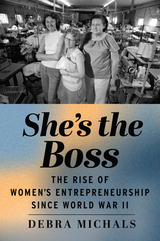 She's the Boss: The Rise of Women’s Entrepreneurship since World War II
Debra Michals
Rutgers University Press, 2025 In the years after World War II, as women were being pushed from wartime jobs for returning soldiers, government and business leaders—and women themselves—saw small business ownership as a viable economic solution. In just five years, US women owned nearly a million of the nation’s businesses. In the decades since, women have moved increasingly into business ownership, often outpacing male start-ups so that today, they own more than fourteen million businesses, 40 percent of all US companies.
She’s the Boss chronicles the forces that made entrepreneurship attractive to women. In rich detail, Debra Michals shares the stories of the countless women of all races, ethnicities, genders, and abilities who contributed to this important history. The book also explores the intersection of women’s personal choices within changing social, political, and economic factors, such as the rising divorce rates of the 1960s and 1970s, ongoing workplace and credit discrimination, civil and women’s rights activism and activist entrepreneurs, the 1970s recession and 1980s “Reagan Revolution,” and more recently, the internet, crowd-funding, and social entrepreneurship.
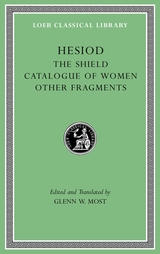 The Shield. Catalogue of Women. Other Fragments
Hesiod
Harvard University Press, 2018 Antiquity’s original didactic poet.
Hesiod describes himself as a Boeotian shepherd who heard the Muses call upon him to sing about the gods. His exact dates are unknown, but he has often been considered a younger contemporary of Homer.
The first volume of this revised Loeb Classical Library edition offers Hesiod’s two extant poems and a generous selection of testimonia regarding his life, works, and reception. In Theogony, Hesiod charts the history of the divine world, narrating the origin of the universe and the rise of the gods, from first beginnings to the triumph of Zeus, and reporting on the progeny of Zeus and of goddesses in union with mortal men. In Works and Days, Hesiod shifts his attention to humanity, delivering moral precepts and practical advice regarding agriculture, navigation, and many other matters; along the way he gives us the myths of Pandora and of the Golden, Silver, and other Races of Men.
The second volume contains The Shield and extant fragments of other poems, including the Catalogue of Women, that were attributed to Hesiod in antiquity. The former provides a Hesiodic counterpoint to the shield of Achilles in the Iliad; the latter presents several legendary episodes organized according to the genealogy of their heroes’ mortal mothers. None of these is now thought to be by Hesiod himself, but all have considerable literary and historical interest.
Glenn W. Most has thoroughly revised his edition to take account of the textual and interpretive scholarship that has appeared since its initial publication.
The Shield. Catalogue of Women. Other Fragments
Hesiod
Harvard University Press, 2006 This volume, which completes the new Loeb Classical Library edition of Hesiod, contains The Shield and extant fragments of other poems, including the Catalogue of Women, that were attributed to Hesiod in antiquity. None of these is now thought to be by Hesiod himself, but all have considerable literary and historical interest. The Catalogue of Women is a systematic presentation in five books of a large number of Greek legendary heroes and episodes, organized according to the genealogy of the heroes' mortal mothers. The Shield provides a Hesiodic counterpoint to the shield of Achilles in the Iliad, with Heracles as the protagonist. The volume concludes with a comprehensive index to the complete edition.
 Shields of the Republic: The Triumph and Peril of America’s Alliances
Mira Rapp-Hooper
Harvard University Press, 2020 Is America’s alliance system so quietly effective that politicians and voters fail to appreciate its importance in delivering the security they take for granted?
For the first century and a half of its existence, the United States had just one alliance—a valuable but highly controversial military arrangement with France. Largely out of deference to George Washington’s warnings against the dangers of “entangling alliances,” subsequent American presidents did not consider entering another until the Second World War. Then everything suddenly changed. Between 1948 and 1955, US leaders extended defensive security guarantees to twenty-three countries in Europe and Asia. Seventy years later, the United States had allied with thirty-seven.
In Shields of the Republic, Mira Rapp-Hooper reveals the remarkable success of America’s unprecedented system of alliances. During the Cold War, a grand strategy focused on allied defense, deterrence, and assurance helped to keep the peace at far lower material and political costs than its critics allege. When the Soviet Union collapsed, however, the United States lost the adversary the system was designed to combat. Its alliances remained without a core strategic logic, leaving them newly vulnerable.
Today the alliance system is threatened from without and within. China and Russia seek to break America’s alliances through conflict and non-military erosion. Meanwhile, US politicians and voters are increasingly skeptical of alliances’ costs and benefits and believe we may be better off without them. But what if the alliance system is a victim of its own quiet success? Rapp-Hooper argues that America’s national security requires alliances that deter and defend against military and non-military conflict alike. The alliance system is past due for a post–Cold War overhaul, but it remains critical to the country’s safety and prosperity in the 21st century.
 Shields of the Republic: The Triumph and Peril of America’s Alliances
Mira Rapp-Hooper
Harvard University Press “Rapp-Hooper takes on directly and convincingly the Trumpian critique that alliances are not worth the investment and have led the nation to fight other people’s battles for them…Her deep erudition, crisp prose style, and innate brilliance shine through on most every page.”
—Boston Review
“The threat of COVID-19 has bolstered her argument, making plain both the importance of the alliance system and the imperative to adapt alliances to new ends.”
—Foreign Policy
“Musters rock-solid evidence to demonstrate what policymakers have long believed: that America’s alliances are a remarkably effective foreign policy tool.”
—Stephen Hadley, former National Security Advisor
“Argues persuasively that the complex alliance system instituted after the devastation of World War II has proven remarkably successful.”
—Kirkus Reviews
For the first 150 years of its existence, heeding George Washington’s warning about the dangers of “entangling alliances,” the United States had just one alliance—a valuable but highly controversial military arrangement with France. That changed dramatically with the Second World War. Between 1948 and 1955, the United States extended defensive security guarantees to twenty-three countries in Europe and Asia. Seventy years later, it is allied with thirty-seven countries.
Today the alliance system is threatened from without and within. China and Russia seek to break America’s alliances through conflict and non-military erosion, while US politicians and voters, skeptical of costs, believe we may be better off without them. But what if the alliance system is a victim of its own quiet success? Mira Rapp-Hooper argues that a grand strategy focused on allied defense, deterrence, and assurance helped to keep the peace throughout the Cold War and that the alliance system remains critical to America’s safety and prosperity in the twenty-first century.
Shift
Jeredith Merrin
University of Chicago Press, 1996 Shift traces the love between two women over several years and explores the intricacies of family relationships. Jeredith Merrin's poems, moving from ecstatic love lyrics to poems of familial affection and damage, to grave, more mature love poems, are psychologically loaded and technically sophisticated. These poems convey a wonderful sense of the sexual and social complexity of human relationships.
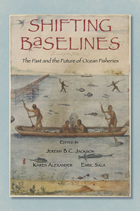 Shifting Baselines: The Past and the Future of Ocean Fisheries
Edited by Jeremy B.C. Jackson, Karen E. Alexander, and Enric Sala
Island Press, 2011 Shifting Baselines explores the real-world implications of a groundbreaking idea: we must understand the oceans of the past to protect the oceans of the future. In 1995, acclaimed marine biologist Daniel Pauly coined the term "shifting baselines" to describe a phenomenon of lowered expectations, in which each generation regards a progressively poorer natural world as normal. This seminal volume expands on Pauly's work, showing how skewed visions of the past have led to disastrous marine policies and why historical perspective is critical to revitalize fisheries and ecosystems.
Edited by marine ecologists Jeremy Jackson and Enric Sala, and historian Karen Alexander, the book brings together knowledge from disparate disciplines to paint a more realistic picture of past fisheries. The authors use case studies on the cod fishery and the connection between sardine and anchovy populations, among others, to explain various methods for studying historic trends and the intricate relationships between species. Subsequent chapters offer recommendations about both specific research methods and effective management. This practical information is framed by inspiring essays by Carl Safina and Randy Olson on a personal experience of shifting baselines and the importance of human stories in describing this phenomenon to a broad public.
While each contributor brings a different expertise to bear, all agree on the importance of historical perspective for effective fisheries management. Readers, from students to professionals, will benefit enormously from this informed hindsight.
 Shifting Blind Identities in Higher Education: Stories of Selfhood
Edited by Alison Cook-Sather
Lever Press, 2026 Shifting Blind Identities: Stories of Selfhood features accounts of how blindness and low vision intersect with other dimensions of identity for both students and faculty in higher education. Contributors from a range of institutional contexts illuminate “common but not comparable” experiences, as well as importantly different ones, and explore different intersections of identity while navigating higher education spaces. Each chapter addresses these questions: What is the relationship between seeing and selfhood? What choices do students and faculty make about how they experience and represent the intersections of their vision condition and other dimensions of their identity? What do authors wish others to understand, consider, let go of, and/or embrace regarding their experiences of navigating higher education with blindness or low vision?
Writing in their own unique voices, each author shares details of their lived experiences; analyses of how those are shaped by institutions, social norms, and individuals; and offers action steps for how everyone can make higher education more welcoming to and supportive of not only those with blindness or low vision but also those with a wide diversity of identities and experiences. Shifting Blind Identities inspires both insight and action into cultivating a more accessible and inclusive space in higher education.
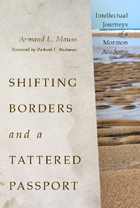 Shifting Borders and a Tattered Passport: Intellectual Journeys of a Mormon Academic
Armand L. Mauss
University of Utah Press, 2012 The life of a Mormon intellectual in the secular academic community is likely to include some contradictions between belief, scholarship, and the changing times. In his memoir, Armand L. Mauss recounts his personal and intellectual struggles—inside and outside the LDS world—from his childhood to his days as a graduate student at UC Berkeley in the 1960s through his many years as a professor.
As an important and influential observer and author in the Mormon intellectual world, Mauss has witnessed how, in attempting to suppress independent and unsponsored scholarship during the final decades of the twentieth century, LDS leaders deliberately marginalized important intellectual support and resources that could have helped, in the twenty-first century, to refurbish the public image of the church. As a sociologist, he notes how the LDS Church, as a large, complex organization, strives to adjust its policies and practices in order to maintain an optimal balance between unique, appealing claims on the one hand and public acceptance on the other. He also discusses national and academic controversies over the New Religious Movements of the 1960s and 1970s. Writing in clear language, Mauss shows how he has navigated the boundaries where his faith and academic life intersect, and reveals why a continuing commitment to the LDS Church must be a product of choice more than of natural or supernatural “proof.”
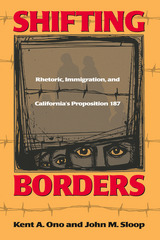 Shifting Borders: Rhetoric, Immigration And Prop 187
Kent Ono
Temple University Press, 2002 "Like articles representing the positions of proponents of the measure, those representing opponents constructing the nation as potentially in danger as a result of undocumented immigration." How do we learn to recognize the damning effects of good rhetorical intentions? And where will we find arguments which escape this trap that permeates the liberal social policy world? Shifting Borders uses an evaluation of the debate over California Proposition 187 to demonstrate how this quandary is best understood by close interrogation of mainstream reports and debates and by bringing to the fore voices that are often left out of mediated discussions. It is these voices outside the mainstream, so-called "outlaw" discourses, that hold the best possibilities for real social change. To illustrate their claim, the authors present dominant and outlaw discourses around Proposition 187, from television reports, internet chat sites, and religious discourse to coverage of the Los Angeles Times. Their critique ably demonstrates how difficult it is to maintain a position outside the mainstream, but also how important it is for the press, citizens and scholars to actively search out such voices. The findings are organized through a model that provides an innovative method for understanding events and arguments through their rhetorical and communicative construction. In a world where the mediated word defines so much of what we know, Shifting Borders provides a lucid introduction to analyzing the spoken and written word that constitutes political debate in contemporary U.S. culture. In doing so, it makes an important contribution to any future development of progressive political strategy. postamble();
Shifting Ethnic Identities in Spain and Gaul, 500-700: From Romans to Goths and Franks
Erica Buchberger
Amsterdam University Press, 2017 Traditional scholarship on post-Roman western culture has tended to examine the ethnic identities of Goths, Franks, and similar groups while neglecting the Romans themselves, in part because modern scholars have viewed the concept of being Roman as one denoting primarily a cultural or legal affiliation. As this book demonstrates, however, early medieval 'Romanness' also encompassed a sense of belonging to an ethnic group, which allowed Romans in Iberia and Gaul to adopt Gothic or Frankish identities in a more nuanced manner than has been previously acknowledged in the literature.
Shifting Ground: Reinventing Landscape in Modern American Poetry
Bonnie Costello
Harvard University Press, 2003 Just as the look of the American landscape has changed since the nineteenth century, so has our idea of landscape. Here Bonnie Costello reads six twentieth-century American poets who have reflected and shaped this transformation and in the process renovated landscape by drawing new images from the natural world and creating new forms for imagining the earth and our relation to it.
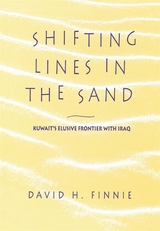 Shifting Lines in the Sand: Kuwait’s Elusive Frontier with Iraq
David Finnie
Harvard University Press, 1992 During the 1991 Gulf War, pundits and experts scrambled unsuccessfully to explain Iraq's “claim” to Kuwait. In a lucid and measured account of a complex historical and geographic drama that culminated in Operation Desert Storm, David Finnie elucidates the long Kuwaiti-Iraqi border dispute and lays Saddam Hussein's dubious claim to rest. He also raises larger questions about European colonialism and about the creation of new nation-states in the Middle East in the nineteenth and twentieth centuries.
Finnie vividly portrays how arbitrary the drawing of frontiers can be, and how they come to serve internal, regional, and international rivalries and ambitions. This history begins in the eighteenth century, when Kuwait was first settled by nomads from the Arabian desert. Finnie describes the country's growing prosperity under a merchant oligarchy, then shows how the Kuwaitis, seeking British protection from the sprawling Ottoman Empire, came to serve England's imperial strategy. He details the ways in which Britain parlayed its mandatory control of Iraq and its protectorate over Kuwait to curb the larger nation's ambitions and to ensure Kuwait's independence under British auspices.
A fresh look at British diplomatic documents reveals how Whitehall covered its tracks, heading off the Iraqis, obfuscating League of Nations proceedings, and confounding scholars and researchers down to the present day. Pursuing his story through Britain's withdrawal from the Persian Gulf and Iraq's 1963 recognition of Kuwait's boundaries, Finnie examines the U.N. post-war measures to secure the frontier in the face of Iraq's continuing pressure for better access to Gulf waters.
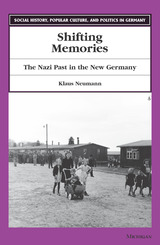 Shifting Memories: The Nazi Past in the New Germany
Klaus Neumann
University of Michigan Press, 2000 Shifting Memories explores the contours and genealogies of non-Jewish Germans' public memories of the Nazi past in the Federal Republic of Germany, asking how the crimes committed by Nazi Germany are reflected in the present. The study illuminates particular aspects of public remembering by focusing on case studies, telling a number of stories which at times appear parallel and at times intersect.
The case studies address, for example, the legacy of the so-called Celler Hasenjagd (the hunting down of concentration camp prisoners who survived an Allied air raid in April 1945 in a town in Lower Saxony); efforts by the City of Hildesheim to memorialize the Kristallnacht pogrom; attempts by Italian, Jewish, and Sinti survivors to commemorate their suffering in two West German towns; the posthumous reputation of a German communist imprisoned in Buchenwald and credited with having saved the lives of 159 Jewish children; and the public memories of the Ravensbrück and Buchenwald concentration camps in East Germany.
Directed at an audience curious about contemporary Germany, this book will appeal to those interested in issues of public and social memory, and in the legacy of Auschwitz.
Klaus Neumann is a historian who has taught in universities in Germany and Australia and written about social memories in the Pacific Islands, Australia, and Germany. Previous books include Not the Way It Really Was and Rabaul Yu Swit Moa Yet. He lives in Richmond, Australia.
Shifting Obsessions: Three Essays on the Politics of Anticorruption
Aryeh Neier
Central European University Press, 2004 This book is not a study of anti-corruption policies. Instead, it looks at the politics of anti-corruption. Policies are what institutions do. But in analyzing politics, this book seeks to discover why institutions do what they do. The author delves into political motivations at a time when "combating corruption" is the fashion among the academic community. Krastev argues that anti-corruption sentiments are not driven by the actual level of corruption but by general disappointment with liberal reforms that cause rising social inequality. In this collection of essays, the author makes the provocative argument that the current corruption-focused policies are doomed.
 Shifting Sands: Landscape, Memory, and Commodities in China's Contemporary Borderlands
Xiaoxuan Lu
University of Texas Press, 2023 How China’s borderlands transformed politically and culturally throughout the twentieth and twenty-first centuries.
China’s land borders, shared with fourteen other nations, are the world’s longest. Like all borders, they are not just lines on a map but also spaces whose histories and futures are defined by their frontier status. An ambitious appraisal of China’s borderlands, Shifting Sands addresses the full scope and importance of these regions, illustrating their transformation from imperial backwaters to hotbeds of resource exploitation and human development in the age of neoliberal globalization. Xiaoxuan Lu brings to bear an original combination of archival research, fieldwork, cartography, and landscape analysis, broadening our understanding of the political economy and cultural changes in China’s borderlands in the twentieth and twenty-first centuries. While conventional wisdom looks to the era of Deng Xiaoping for China’s “opening,” Lu shows the integration of China’s borderlands into national and international networks from Sun Yat-sen onward. Yet, while the state has left a firm imprint on the borderlands, they were hardly created by China alone. As the Chinese case demonstrates, all borderlands are transnational, their physical and socioeconomic landscapes shaped by multidirectional flows of materials, ideas, and people.
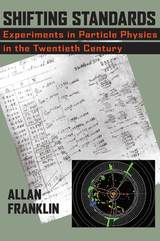 Shifting Standards: Experiments in Particle Physics in the Twentieth Century
Allan Franklin
University of Pittsburgh Press, 2013 In Shifting Standards, Allan Franklin provides an overview of notable experiments in particle physics. Using papers published in Physical Review, the journal of the American Physical Society, as his basis, Franklin details the experiments themselves, their data collection, the events witnessed, and the interpretation of results. From these papers, he distills the dramatic changes to particle physics experimentation from 1894 through 2009.
Franklin develops a framework for his analysis, viewing each example according to exclusion and selection of data; possible experimenter bias; details of the experimental apparatus; size of the data set, apparatus, and number of authors; rates of data taking along with analysis and reduction; distinction between ideal and actual experiments; historical accounts of previous experiments; and personal comments and style.
From Millikan’s tabletop oil-drop experiment to the Compact Muon Solenoid apparatus measuring approximately 4,000 cubic meters (not including accelerators) and employing over 2,000 authors, Franklin’s study follows the decade-by-decade evolution of scale and standards in particle physics experimentation. As he shows, where once there were only one or two collaborators, now it literally takes a village. Similar changes are seen in data collection: in 1909 Millikan’s data set took 175 oil drops, of which he used 23 to determine the value of e, the charge of the electron; in contrast, the 1988–1992 E791 experiment using the Collider Detector at Fermilab, investigating the hadroproduction of charm quarks, recorded 20 billion events. As we also see, data collection took a quantum leap in the 1950s with the use of computers. Events are now recorded at rates as of a few hundred per second, and analysis rates have progressed similarly.
Employing his epistemology of experimentation, Franklin deconstructs each example to view the arguments offered and the correctness of the results. Overall, he finds that despite the metamorphosis of the process, the role of experimentation has remained remarkably consistent through the years: to test theories and provide factual basis for scientific knowledge, to encourage new theories, and to reveal new phenomenon.
 Shifting Stories: History, Gossip, and Lore in Narratives from Tang Dynasty China
Sarah M. Allen
Harvard University Press, 2014 Shifting Stories explores the tale literature of eighth- and ninth-century China to show how the written tales we have today grew out of a fluid culture of hearsay that circulated within elite society. Sarah M. Allen focuses on two main types of tales, those based in gossip about recognizable public figures and those developed out of lore concerning the occult. She demonstrates how writers borrowed and adapted stories and plots already in circulation and how they transformed them—in some instances into unique and artfully wrought tales.
For most readers of that era, tales remained open texts, subject to revision by many hands over the course of transmission, unconstrained by considerations of textual integrity or authorship. Only in the mid- to late-ninth century did some readers and editors come to see the particular wording and authorship of a tale as important, a shift that ultimately led to the formation of the Tang tale canon as it is envisioned today.
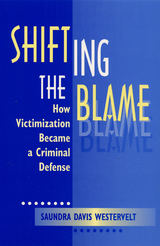 Shifting The Blame: How Victimization Became a Criminal Defense
Westervelt, Saundra D
Rutgers University Press, 1998 More than just a study of legal history, Shifting the Blame looks at the "abuse excuse" defense as an indicator of broad social change in cultural understandings of victimization, responsibility, and womanhood. The introduction of victimization as an exculpatory condition within the context of a criminal defense tells the story of a society that has accepted victimization as a new way of explaining and excusing misbehavior. Through case law analysis, the book documents the initial development of the strategy in three different types of cases in the 1970s - "rotten social background", brainwashing, and battered women's self-defense cases. Since its initial acceptance in battered women's cases in the early 1980s, the use of the strategy has expanded to a variety of offenders in different types of relationships arguing different defenses. In lively, readable prose, Westervelt examines each form of expansion, revealing that while the expansion of the strategy has been fairly extensive, it has also been limited in some important ways. Her research shows readers that only certain types of "victims," particularly victims of physical abuse, have successfully used this defense. Shifting the Blame exposes the ways in which the acceptance of this new defense strategy illuminates a cultural shift in understandings of individual responsibility and shows how the law plays a role in defining who can be an acceptable victim. Saundra D. Westervelt is an assistant professor in the Sociology Department at the University of North Carolina at Greensboro.
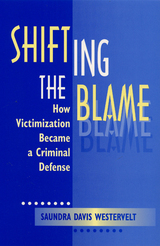 Shifting The Blame: How Victimization Became a Criminal Defense
Westervelt, Saundra D
Rutgers University Press, 1996 More than just a study of legal history, Shifting the Blame looks at the "abuse excuse" defense as an indicator of broad social change in cultural understandings of victimization, responsibility, and womanhood. The introduction of victimization as an exculpatory condition within the context of a criminal defense tells the story of a society that has accepted victimization as a new way of explaining and excusing misbehavior. Through case law analysis, the book documents the initial development of the strategy in three different types of cases in the 1970s - "rotten social background", brainwashing, and battered women's self-defense cases. Since its initial acceptance in battered women's cases in the early 1980s, the use of the strategy has expanded to a variety of offenders in different types of relationships arguing different defenses. In lively, readable prose, Westervelt examines each form of expansion, revealing that while the expansion of the strategy has been fairly extensive, it has also been limited in some important ways. Her research shows readers that only certain types of "victims," particularly victims of physical abuse, have successfully used this defense. Shifting the Blame exposes the ways in which the acceptance of this new defense strategy illuminates a cultural shift in understandings of individual responsibility and shows how the law plays a role in defining who can be an acceptable victim. Saundra D. Westervelt is an assistant professor in the Sociology Department at the University of North Carolina at Greensboro.
Shifting the Burden: The Struggle over Growth and Corporate Taxation
Cathie J. Martin
University of Chicago Press, 1991 Since World War II, the corporate tax burden has, overall, decreased enormously as a percentage of the government's total revenue. Until now, however, no explanation of this phenomenon has accounted for the periodic reforms—such as the dramatic 1986 Tax Reform Act—which significantly increase some corporate taxes.
Remarkably accessible and rich in historical evidence, Shifting the Burden is the most compelling explanation to date of how our nation's tax policy is formulated. Cathie J. Martin shows how presidents' cultivation of allies within the business community and struggles within that community itself combine to shape tax policy.
 Shifting the Color Line: Race and the American Welfare State
Robert C. Lieberman
Harvard University Press, 2001 Despite the substantial economic and political strides that African-Americans have made in this century, welfare remains an issue that sharply divides Americans by race. Shifting the Color Line explores the historical and political roots of enduring racial conflict in American welfare policy, beginning with the New Deal.
Through Social Security and other social insurance programs, white workers were successfully integrated into a strong national welfare state. At the same time, African-Americans--then as now disproportionately poor--were relegated to the margins of the welfare state, through decentralized, often racist, public assistance programs.
Over the next generation, these institutional differences had fateful consequences for African-Americans and their integration into American politics. Owing to its strong national structure, Social Security quickly became the closest thing we have to a universal, color-blind social program. On the other hand, public assistance--especially Aid to Families with Dependent Children (AFDC)--continued to treat African-Americans badly, while remaining politically weak and institutionally decentralized.
Racial distinctions were thus built into the very structure of the American welfare state. By keeping poor blacks at arm's length while embracing white workers, national welfare policy helped to construct the contemporary political divisions--middle-class versus poor, suburb versus city, and white versus black--that define the urban underclass.
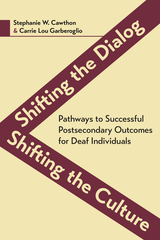 Shifting the Dialog, Shifting the Culture: Pathways to Successful Postsecondary Outcomes for Deaf Individuals
Stephanie W. Cawthon
Gallaudet University Press, 2017 In this volume, Stephanie W. Cawthon and Carrie Lou Garberoglio discuss the individual and systemic factors that both facilitate and inhibit the attainment of postsecondary education, training, and career goals for deaf individuals. Real-life examples and current research are combined in this consideration of the interactions between individuals and the many layers of the overall system in which they navigate.
In addition to using a systems theory approach, the authors employ resiliency models that emphasize how deaf individuals persist through the transition process amidst the barriers that reside within larger educational and social systems. Employment, independent living, and community involvement are a few of the postsecondary outcomes that are covered. Shifting the Dialog, Shifting the Culture addresses critical issues that influence how deaf individuals reach their postsecondary goals and is designed for a diverse audience that includes professionals who work (or are training to work) with deaf individuals, policy makers, as well as federal and state personnel.
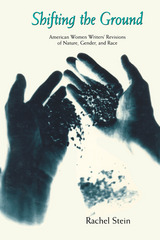 Shifting the Ground: American Women Writers' Revisions of Nature, Gender, and Race
Rachel Stein
University of Virginia Press, 1997 In Shifting the Ground, Rachel Stein adds a feminist slant to the field of ecocriticism. Americans have historically defined themselves in terms of their conquest of "virgin land." Unfortunately, this identification has often proved disastrous to groups such as women, Native Americans, and African Americans, who were regarded as nature incarnate, part of the ground that must be mastered in the name of nation.
From a perspective of ecofeminist theory, Stein suggests that selected writings by Emily Dickinson, Zora Neale Hurston, Alice Walker, and Leslie Marmon Silko cannily revise intersections between American conceptions of nature and problematic formulations of gender and race. Writing from diverse social positions, each author examines a historical instance of this colonial conjunction: Dickinson grapples with the forces of Victorian Puritanism; Hurston interrogates Afro-Caribbean and African-American women's abuse as "beasts of burden"; Walker examines black mothers' struggles in the Jim Crow South as the legacy of their history as slave "chattel"; and Silko treats social ills of Native Americans as stemming from their objectification by white settlers.
In order to alleviate these oppressive conditions, Stein argues, each writer incorporates an alternative conception of nature from popular and indigenous traditions such as sentimentalism, Voodoo, African-American animism, and Laguna Pueblo story cycles. By reinterpreting nature, they transform their characters from social objects into self-empowered subjects.
Recasting these authors against the backdrop of conquest rhetoric, Stein offers provocative new readings of their texts. Her book paves the way for further development of ecocriticism and ecofeminist theory with regard to American women writers.
Reviews
"Shifting the Ground examines the ways in which four women writers--Dickinson, Hurston, Walker, and Silko--subvert the destructive American mythos of 'nature's nation' and replace it with alternative visions of egalitarian interrelations between nature, gender, and race. Stein's study is well-informed, cogently written, and intelligent. Shifting the Ground is ecofeminist literary criticism at its best."
--Cheryll Glotfelty, University of Nevada, Reno
The Author
Rachel Stein is Assistant Professor of English at Siena College.
|
|
